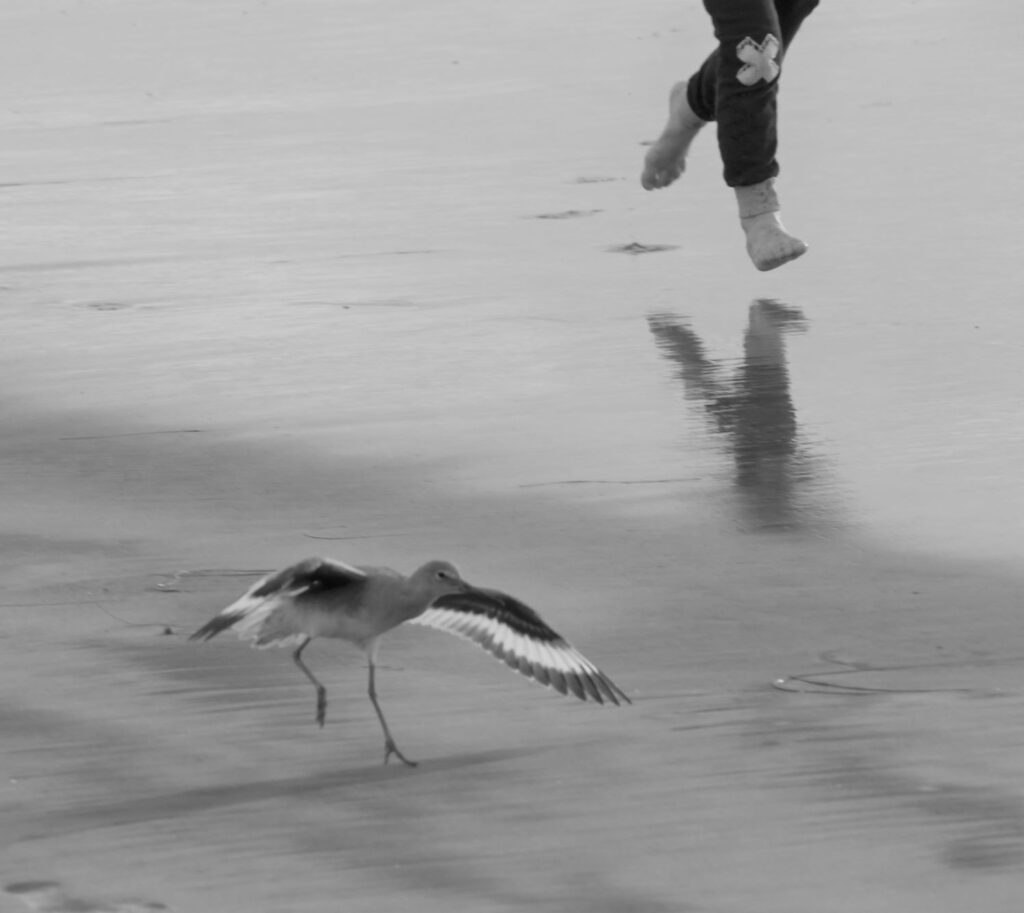
BIRD SURVEYS OF SAN DIEGO COUNTY, CA 2020-2021; 2024 Callyn Yorke
28 October – 1 November 2024 SUMMARY (122 Species)
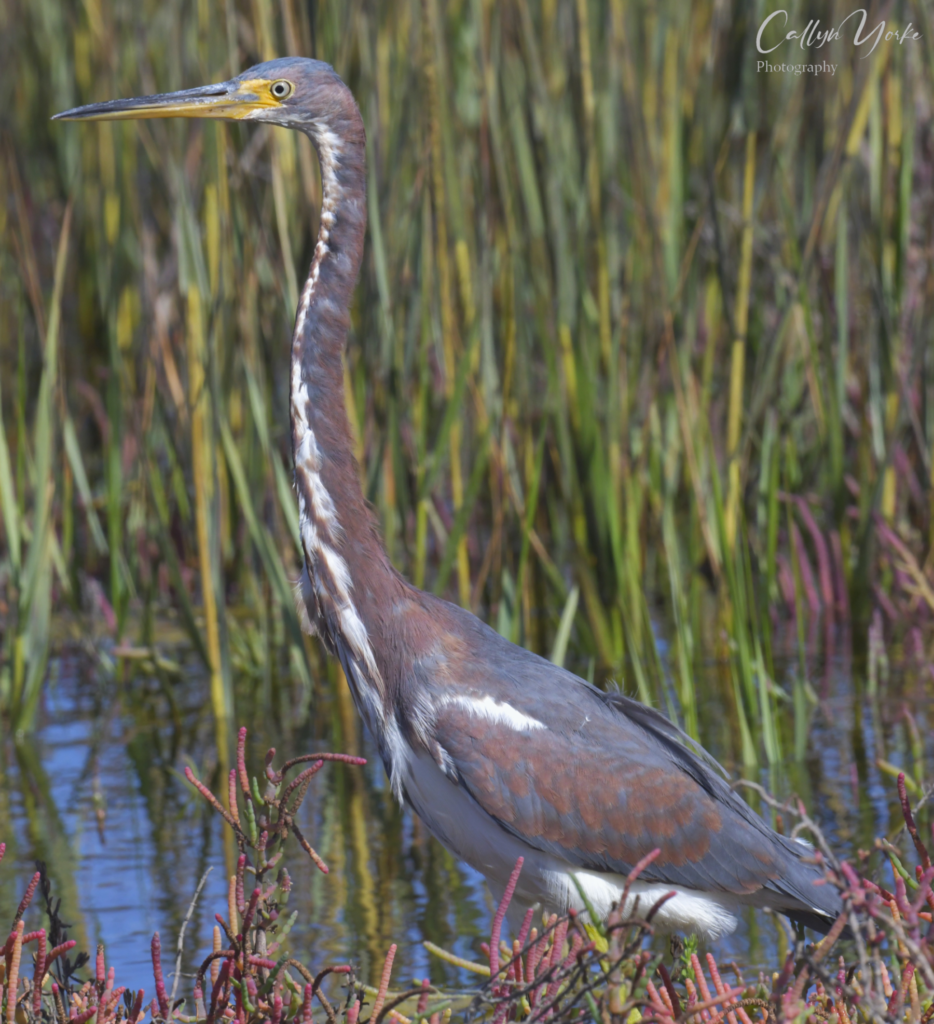
Weather: Partly cloudy; 51°F to 70°F; wind 2- 16 mph, generally increasing by late morning and afternoon. Seas calm to choppy with increasing onshore winds; surf 1-3 ft. Low tide 1200- 1500 hrs.
Time: 0735-1500 hrs.
Observers: Dan Byrne and I (DB & CY: 10/30-11/1/2024); CY (10/28-10/29/2024)
Areas Covered:

Encinitas, including upper and lower Cottonwood Creek (UCC; LCC), Moonlight Beach (MB), town and suburbs (EN). One walking survey was made through UCC, LCC and MB (10/28/24: 0735-1145 hrs.). LCC and MB were the most productive locations surveyed, especially the newly revegetated areas next to a homeless camp in the central section of LCC. There, mixed species flocks (OCWA, YRWA, COYE, WIWA, HUVI, BUTI, WCSP, SOSP) foraged conspicuously in willows and lush outcrops of seed-bearing herbs and shrubs, evidently habituated to human presence. UCC, by contrast, had fewer birds and considerably more disturbance, i.e., ball-court games, lawn mowing, and people walking/running with dogs. MB at high tide also had early morning activities on the beach (e.g. volleyball games, joggers, people with dogs) and in the water (about twenty surfers). Mixed species flocks of gulls on shore (e.g., WEGU, CAGU, HEGU) were frequently flushed.
Multiple driving and walk-through surveys of EN usually produced common, widespread, opportunistic species, e.g. Eurasian Collared Dove, European Starling, House Wren, Scaly-breasted Munia, House Sparrow, White-crowned Sparrow and Common Yellowthroat.
Oceanside Harbor and mouth of the San Luis Rey River (OH; SLR, 10/29/2024: 0837-0950 hrs.). A 2-hr. free parking lot, adjacent to seafood restaurants on the north side of the SLR river bridge, was the starting and end point of my walking survey of the area. The survey included an overview of SLR from the bridge and north sidewalk, continuing to the two, bracketed shoreline breakwaters, main harbor and channel. Taken together, the numbers and diversity of birds were low, partially due to gusty winds (10-15 mph) combined with heavy surf (2-3 ft.). Multiple people with dogs were present throughout the area; fresh OHV tracks were seen in the sandbars bordering the river mouth.
Guajome Regional Park (GRP, 10/29/2024: 1012-1145 hrs.). From the north park entrance ($3 parking fee) in an coast live oak-Eucalyptus woodland, I walked along the south edge of the main lake, then southwestward on a designated nature trail, finally circling back across a hillside combination of coastal sage and mowed ruderal field.
Birding was most productive around the main lake; much less so on the nature trail. An RV campground next to the nature trail was full. Multiple cyclists, joggers and dog-walkers were present during the survey. No other birders were encountered in the park during my visit.
Northwest San Elijo Lagoon (SEL, 10/29/2024: 1225-1400 hrs.). From the visitor center, I walked the main trail south and westward along the main tidal channel, crossing two relatively new foot bridges, then on a trail paralleling the west and northwest sections of the tidal salt marsh. The main parking lot was full when I arrived; additional parking was available across the street from the SEL entrance at a public works facility, though apparently only for EV charging.
Moderate to heavy foot traffic with multiple leashed dogs has become the norm here. A very small number of the visitors and staff workers appear to be engaged in birding and/or nature appreciation. Thus, this exceptionally well preserved and accessible coastal sage – riparian – tidal salt marsh, is used mostly for mindless recreational purposes.
The incidental good news is that a nearly constant human presence on the trails has resulted in partial to nearly complete habituation of resident and wintering waterbirds, at least when they are allowed adequate distance to seek cover. Although leashed dogs usually flush birds from the trailside, they seldom fly far and may soon return to the same area following the dog’s departure. This behavior contrasts sharply with the presence of dogs on shore, where birds are fully exposed and readily flushed, often to a distantly remote location.
Jacumba, including the hot springs, community park and suburbs (JAC, 10/30/24: 0950-1605 hrs. DB & CY). Birding around the main hot springs pond and marsh was fairly productive. Mixed species flocks of sparrows, finches, warblers and other passerines (e.g., BRSP, VESP, SASP, WCSP, BGGN, VERD, BUTI, OCWA) frequented clumps of willow, cottonwood, saltbush, horse brush and tule; some species (e.g. SASP, VESP) were drinking pond water on the shore. Comparatively tall vegetation adjacent to the main pond featured larger species, e.g. PHAI, NOMO and CASJ.
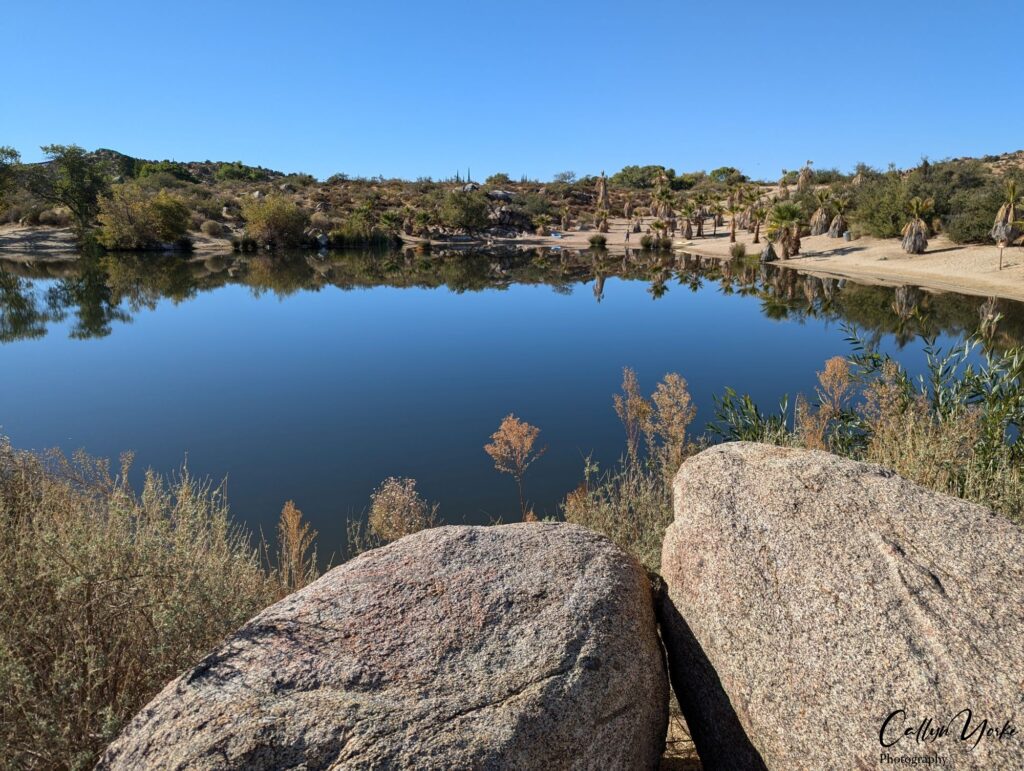
A small pond with surrounding marsh on the south side of the main pond, with a pvc pipe delivering intermittent water flow (used for bathing by locals), attracted RBKI, SOSP and NAWA. Further afield, a pair of Harris Hawks centered their activities around a hilltop utility pole, about 200 yards west of the hot springs pond.

The Jacumba Community Park (JCP), turf-less baseball field and bordering desert scrub, included a few more species for our trip list, e.g. Red-tailed Hawk, Cactus Wren, California Thrasher, Brewer’s Blackbird and Brown-headed Cowbird. A brief drive-through of the Jacumba residential area turned up Eurasian Collared Dove, Common Raven, European Starling and Yellow-rumped Warbler. The day’s tally finished at forty-two bird species, most of which were found in the vicinity of the main hot springs pond.
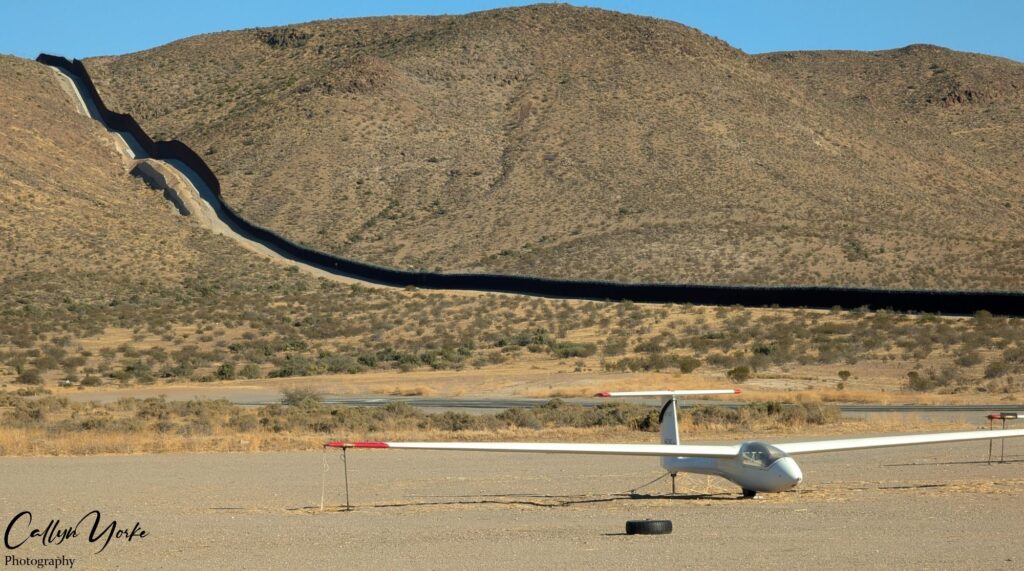
We enjoyed a delicious lunch and brief tour of the luxurious Jacumba Hot Springs Hotel – featuring warm spring water pools, an eclectic Santa Fe – Moroccan motif ($180 – $500/night). Our personalized tour included remarks regarding the history of the Jacumba Hot Springs, which had been a popular destination prior to the construction of the I-8 bypass.
Nowadays, this rustic little border town appears to be quiet with little automobile traffic on the main street, HWY 80, previously the principal route connecting Jacumba with El Centro. Indeed, the Jacumba atmosphere was pleasant, somewhat reminiscent of a Midwest farm town. Local merchants and residents were friendly and welcoming; as visiting birders we encountered no difficulties when walking about with camera and binoculars.
San Diego Bay (SDB, 10/31/2024: 1100-1440 hrs.), including the south bay salt ponds and adjacent National Wildlife Refuge (SWP); west-central and north-west bay shorelines and mudflats, i.e. Loew’s Coronado Bay Resort (LCB) and the Amphibious Naval Base shoreline (ANB).
Using a 30x Bushnell Spacemaster spotting scope and Bogen tripod, Zeiss 10 x 42 and Nikon 8 x 32 binoculars, together with a Nikon D850 camera fitted with a Nikon pf 500mm lens, we first visited the nature trail between 10th and 8th St., Imperial Beach, overlooking the saltworks and part of the South Bay National Wildlife Refuge (SWP). Dense flocks of shorebirds occurred on the nearest saltwork berm on the north edge of a tidal channel, however many of the birds were too distant for assigning specific identifications (photo).
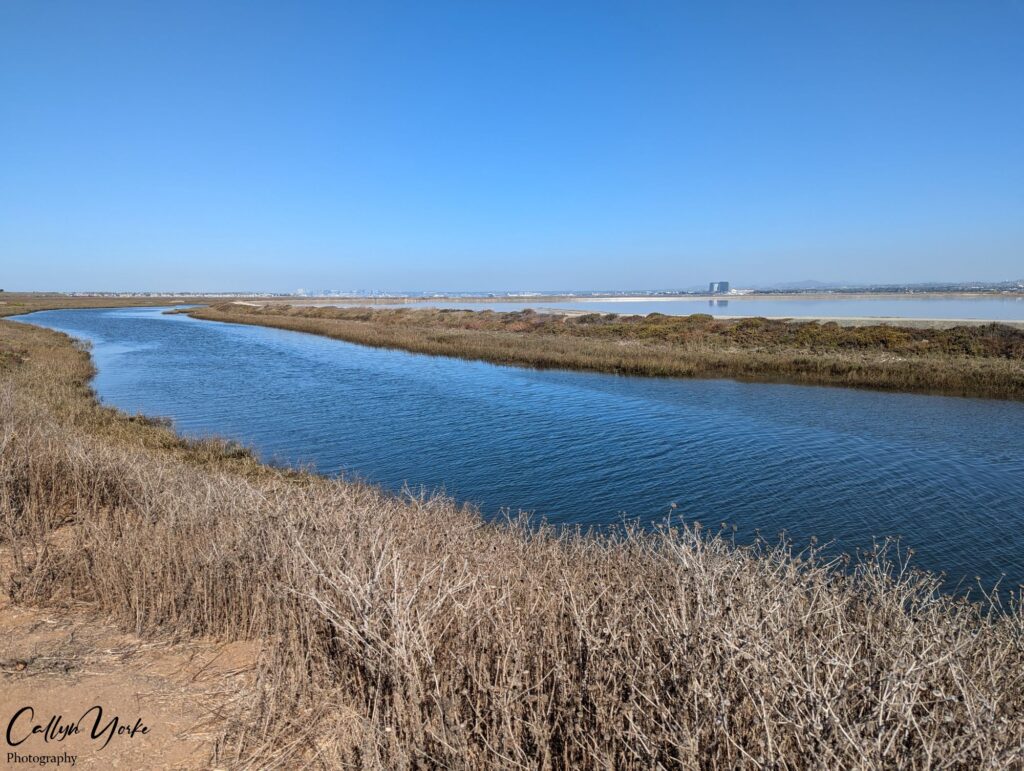
Continuing by car northbound on CA-75, roadside viewing access was limited. We drove north to the Loew’s Coronado Bay Resort parking lot and found shorebirds on the adjacent mudflats. Driving further northward on CA-75, brought us to the last section of visible mudflats, best viewed from a paved bike path, looking eastward through a chain-link fence (ANB). There, a variety of shorebirds, including BBPL, REKN, MAGO, DUNL, were fairly close and in good light for comparatively easy identification.
While at that last location, a brush fire in the distance, on the south side of Montezuma Rd., near San Diego State University, had reached an alarming size (photo). Steady onshore winds kept the smoke from drifting westward toward us and the shorebirds busily foraging on the mudflats.
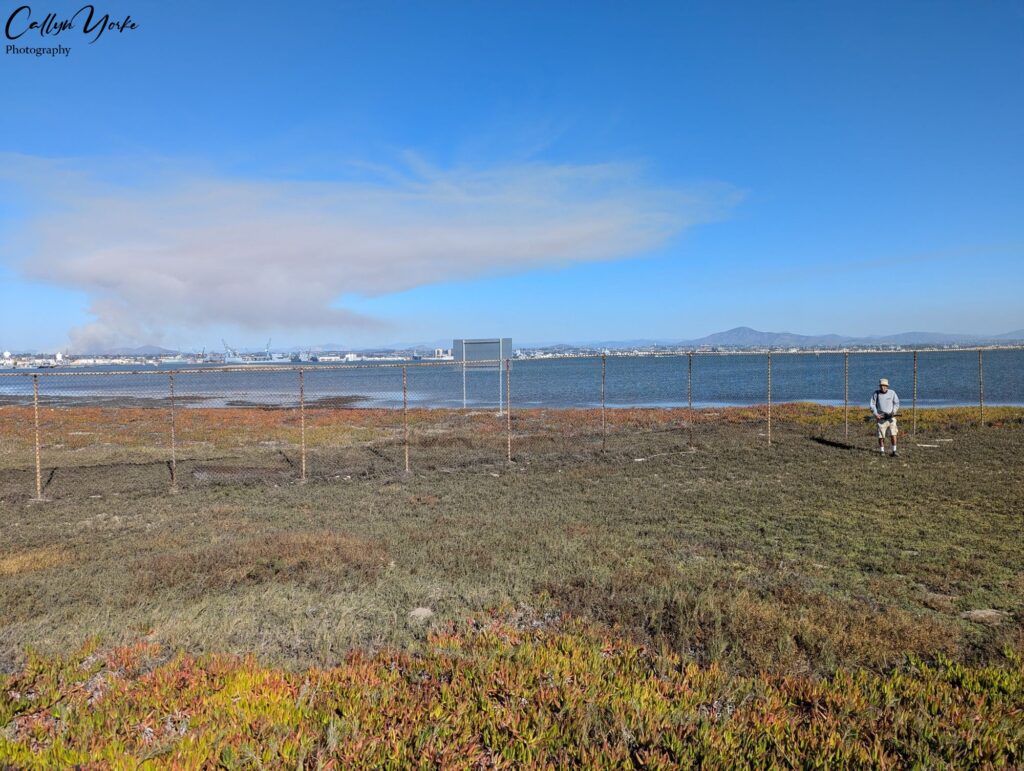
Balboa Park (BP, 1 November 2024: 1009-1430 hrs.). From the Starlight Bowl parking lot, we walked north and eastward, crossing the Park Blvd. pedestrian bridge leading to the hillside Desert Garden. Birdlife was fairly conspicuous in an international assemblage of cacti plantings bordering coastal sage scrub, as well as the adjacent parkland dominated by mature Eucalyptus trees. Our survey also included casual observations in gardens, on lawns and in patches of mature woodland, e.g. Ficus spp. in this most popular section of the four-hundred acre park. However, no new bird species were added to the overall trip list in BP. We had lunch at the Prado restaurant, where the most memorable item was an exotic Caribbean anole (Anolis sp.) on the wall next to our table (photo).
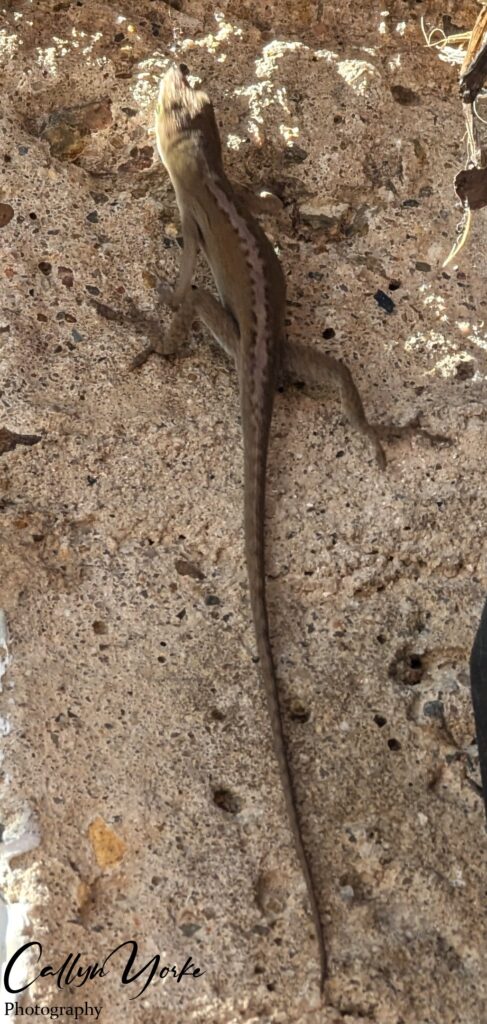
Annotated Bird List
Abbreviated site localities, north to south, are as follows: Guajome Regional Park (GRP); Oceanside Harbor, beach, breakwaters and mouth of the San Luis Rey River (OH; SLR); Encinitas neighborhood (EN); Moonlight Beach, Upper and Lower Cottonwood Creek (MB; UCC; LCC); Northwest San Elijo Lagoon (SEL); Balboa Park (BP); San Diego Bay, including the South Bay Saltwork ponds, tidal marsh and channels of the NWR (SWP); Loew’s Coronado Bay Resort (LCB) and the Amphibious Naval Base mudflats (ANB); Jacumba Hot Springs, Community Park and neighborhood (JAC).
Actual counts are given for a species location; when there were more than about thirty individuals, I estimated by counting groups of ten.
Plumage and behavioral categories are abbreviated as follows: basic – nonbreeding plumage (bsc plmg); alternate – breeding plumage (alt plmg); molting – transitional plumage (trans plmg); adult (ad); juvenile/immature/ subadult (imm); gull age classes – first cycle, second cycle, C1, C2, etc.); male (m); female (f); associated with a mixed species flock (msf); estimated height in ft. above ground or water (agl); probing substrate (prb); insect – arthropod gleaning, i.e. from foliage (igl); hover or snatch-gleaning (hog); aerial hawking, e.g. of flying insects (aha); consuming flower parts, nectar, fruit, seeds (frg); gregarious – in pairs or flocks (greg.); widespread occurrence in appropriate habitats (ubiq.) – for bird species in this category, only the location with the highest count is given.
- Canada Goose 2 greg. inundated tidal salt marsh, SEL.
- Gray-lag Goose (domestic) 3 greg. edge of main lake, GRP.
- Blue-winged Teal 2 (f) greg. swimming in marsh at edge of channel with CITE, SEL.
- Cinnamon Teal 3 (m,f) greg. swimming at edge of channel, SEL.
- Gadwall 5 (m,f) greg., swimming at north edge of lake, GRP.
- American Wigeon 25 (m,f) greg. individuals and small flocks resting in marsh, on mudflats and swimming in channel, SEL.
- Mallard 20 (m,f) greg. a relatively habituated flock on shore and in shallows, GRP; ubiq..
- Northern Pintail 3 (m,f) greg. dabbling in shallows and marsh at edge of channel, SEL.
- Ruddy Duck 5 (m,f; bsc. plmg.) greg. swimming in shallows at edge of lake, GRP.
- California Quail 25 (m,f) greg. two coveys on ground – one in brushy border of main hot springs pond; another in sage scrub in JCP behind baseball field, JAC.
- Pied-billed Grebe 1 swimming in open water, SLR; 2 swimming in open water, GRP; 5 in shallows and open water in tidal channel, SEL.
- Eared Grebe 1 swimming in tidal channel, SWP; 1 (alt. plmg.) swimming near shore, ANB. 1(bsc. plmg.) diving at edge of tidal channel, SEL.
- Western Grebe 7 greg. individuals preening and resting small flocks in harbor channel, OH; 1 in open water ANB.
- Feral Rock Pigeon 100 greg. a large, cohesive flock circling beach and parking area, MB; EN; OH; BP.
- Eurasian Collared Dove 2 on utility lines, EN; 1 on ground next to roadway, JAC.
- Mourning Dove 4 on utility lines and in flight, UCC; 2 in leafless deciduous tree, JCP.
- Greater Roadrunner 1 on neighborhood street next to an open field, JAC.
- Anna’s Hummingbird 3 (m,f) hovering around trees and shrubs, LCC; ubiq..
- Allen’s Hummingbird 6 (m,f) perched on low branches of willows, cottonwoods; hovering amidst swarms of flying insects, UCC, LCC; ubiq.
- Selasphorus sp. 4 (f) in shrubs and low limbs of trees, riparian patches, UCC, LCC; JAC.
- Ridgeway’s Rail 1 walking, foraging (pr) in shallows at edge of tidal marsh, SEL.
- Common Gallinule 1 with AMCO and MALL, walking on shore of main lake, GRP.
- American Coot 60 greg. on shore and in shallows around lake, GRP; SEL.
- Black-necked Stilt 17 greg. in tidal marsh and flying low over channel, SWP (photo).
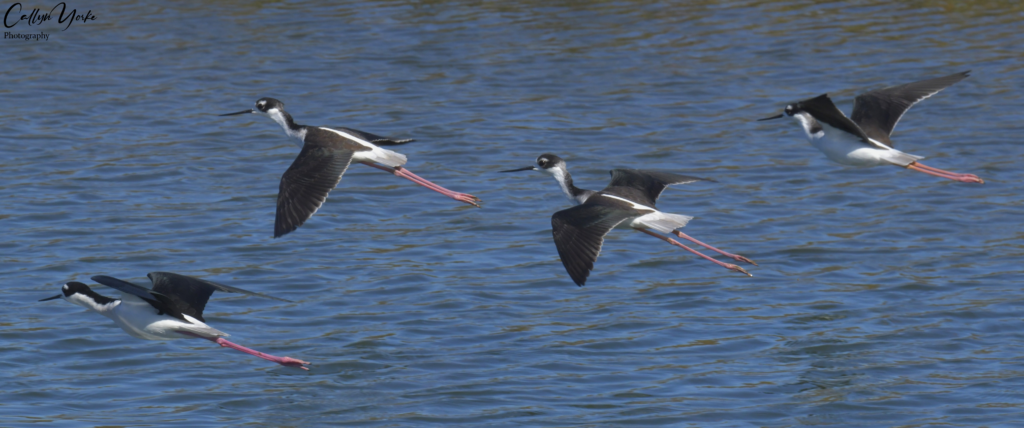
- Black-bellied Plover 35 + (bsc. plmg.) greg. in msf on berm; individuals foraging (pr) on mudflats with other shorebirds, SWP; 3 LCB; ANB; SEL.
- Snowy Plover 1 on distant mudflat with WESP, LCB.
- Semipalmated Plover 20 greg. pairs and loose flocks foraging (pr) on mudflats, LCB; ANB (photo).
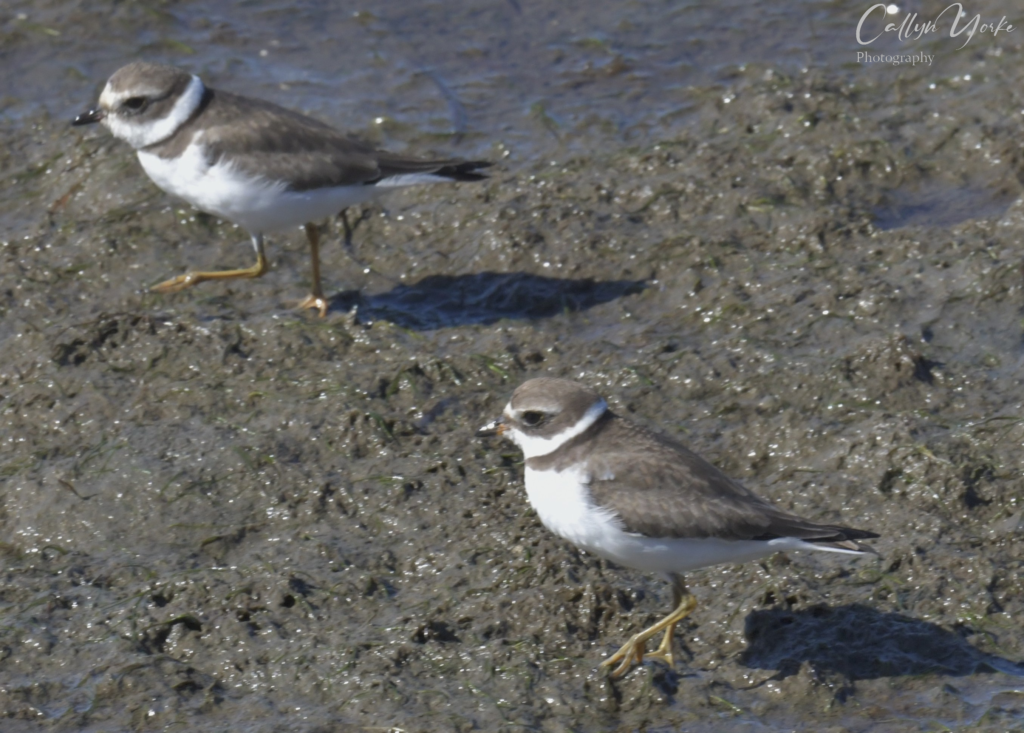
- Killdeer 5 individuals on mudflats in msf with other shorebirds, ANB.
- Whimbrel 1 on outer shore at high tide, MB.
- Long-billed Curlew 2 individuals resting in salt marsh; one in low flight over channel, SEL; 2 individuals foraging (pr) on mudflat, LCB.
- Marbled Godwit 8 greg. foraging (pr) in shallows at edge of mudflat, ANB.
- Ruddy Turnstone 3 loosely greg. foraging (pr) in msf with other shorebirds on mudflat, ANB.
- Red Knot 8 + (probably more individuals out of view in dense msf of shorebirds) (bsc. plmg.) highly greg. on berm, SWP; 8 greg. foraging (pr) on mudflat in msf with other shorebirds, ANB.
- Sanderling 20 + greg. in msf with other small shorebird species resting on berm, SWP.
- Dunlin 15 (bsc. plmg.) greg. resting on berm and foraging (pr) on mudflats and shallows in small flocks, SWP, LCB, ANB.
- Least Sandpiper 10 + in msf with other shorebirds resting on a berm; flocks occasionally seen in flight, possibly this species, although WESP appeared to be the numerically dominant sandpiper in the SD Bay area, SWP.
- Western Sandpiper 70 (bsc. pmg.) in msf with DUNL, REKN and other shorebirds resting on berm, foraging on mudflats and in flight over the bay, SWP, LCB, ANB.
- Short-billed Dowitcher 4 (bsc. plmg.) highly greg. while foraging (pr) in shallows and marsh with LBDO nearby for comparisons, SEL.
- Long-billed Dowitcher 2 (bsc. plmg.) foraging (pr) in shallows and on a mudflat bordering a tidal channel; nearby SBDO for comparisons, SEL.
- Dowitcher sp. 15 foraging in shallows and on mudflat,SEL; SWP, LCB, ANB.
- Greater Yellowlegs 6 greg. resting together in marsh on south side of tidal channel, SWP; 1 on mudflat, LCB.
- Willet 20 in marsh and on mudflats, msf with other shorebirds, SWP, LCB, ANB; 3 on outer shore, OH.
- Bonaparte’s Gull 1 in flight, distant msf with terns over bay, ANB.
- Heermann’s Gull 30 (mostly ad. in bsc. plmg.) greg. on breakwater with DCCO and BRPE, OH; 20 greg. on shore and inner beach with WEGU and CAGU, MB.
- Ring-billed Gull 8 (C!, C2) greg. mostly resting on inner beach mid-shore, usually apart from larger gull spp., MB.
- Western Gull 35 (ad., imm. – mostly C1, C2) greg. on and offshore, MB; 10 in flight over bay and mudflats, LCB, ANB.
- California Gull 40 (ad., imm. – mostly C1, C2) greg. in msf with WEGU and HEEG, on and offshore, MB; 5 individuals in flight over bay, LCB.
- Herring Gull 1 (ad) on sandy berm with CAGU and WEGU, MB (photo).
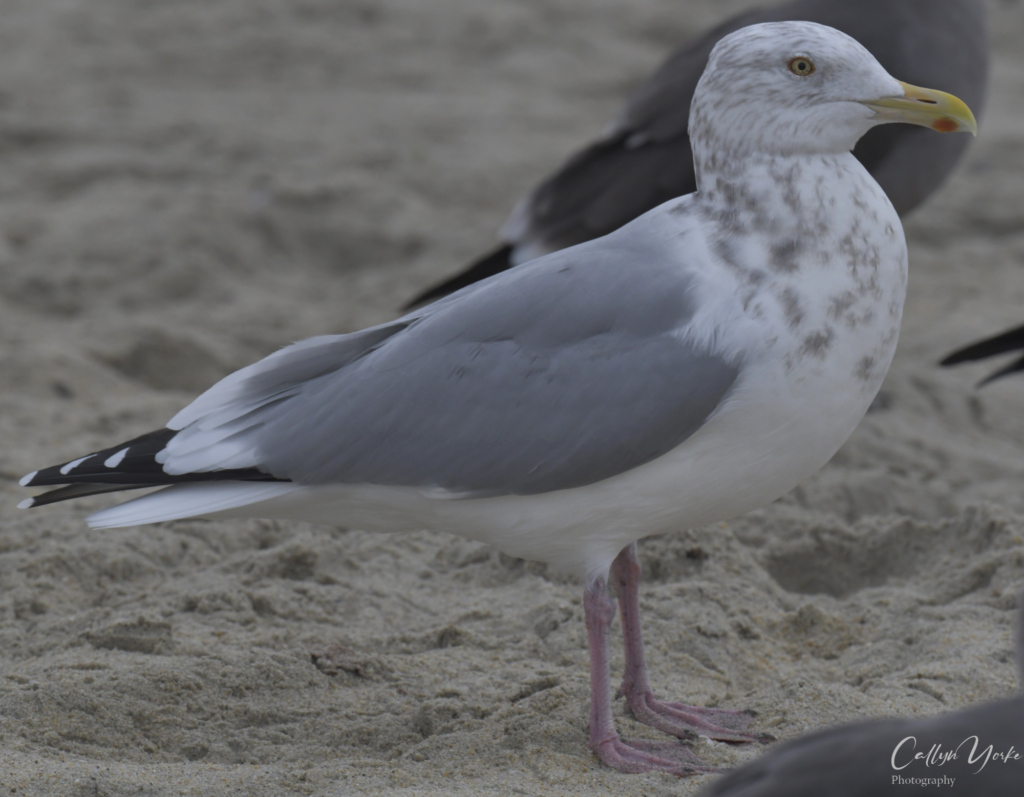
- Caspian Tern 1 in flight over bay, LCB.
- Forster’s Tern 10 greg. in flight and alighting on berm, SWP.
- Royal Tern 1 diving offshore, MB; 5 in flight northward offshore, OH.
- Elegant Tern 3 greg., flying over berm and ponds, SWP.
- Brandt’s Cormorant 1 flying low, nw offshore, MB.
- Double-crested Cormorant 20 (ad., imm) on utility lines, outer channel shore, and flying around marsh, SEL; 16 on bait dock and adjacent breakwater, diving in harbor, OH; 1 in tree at edge of main lake, GRP.
- Brown Pelican 30 (ad., imm.) on bait fish dock, breakwaters, in and around harbor and offshore, OH; MB, ubiq..
- Great Blue Heron 1 in flight over marsh adjacent to nature trail, GRP; 1 in tidal marsh, SWP.
- Great Egret 4 standing in marsh and edge of channels, SEL; coastal –ubiq..
- Snowy Egret 10 individuals and pairs in marsh and shallows at edges of channels, SEL; coastal- ubiq..
- Tricolored Heron 2 (imm) individuals of differing size, active in tidal marsh shallows; both birds relatively habituated to pedestrians on trail; apparently this species has become a locally common winter resident in coastal SDCO, SEL (photo – Introduction).
- Black-crowned Night Heron 2 in trees at edge of the lake, GRP.
- Turkey Vulture 1 soaring over town and valley, JAC; 1 soaring over salt ponds, SWP.
- Osprey 2 on street light poles on bridge over river mouth, SLR; 1 on wooden post in tidal marsh, SEL.
- Red-shouldered Hawk 1 vocal (unseen) cottonwoods at edge of park, UCC.
- Red-tailed Hawk 1 (ad) soaring over field, GRP; 2 ; one bird soaring on thermals over hillside next to main hot springs pond; another individual (dark morph) on a roadside utility pole, HWY 80, JAC; one imm. in tree canopy being harassed by AMCR, BP.
- Harris’s Hawk 2 (ad., imm.) greg. initially seen while perched together on a hillside utility pole about 200 yards west of the main hot springs pond; later seen soaring together over adjacent ridge; reportedly a common resident species in this vicinity, JAC.
- Belted Kingfisher 2 (m,f) perched on posts in salt marsh, SEL; 1 in tree on north edge of lake, GRP.
- Nuttall’s Woodpecker 1-2 vocal in riparian patches, UCC; LCC; GRP; 1 flying between cottonwoods, JAC.
- Downy Woodpecker 2 (m,f) vocal, a pair foraging on small diameter limbs in adjacent willows, LCC.
- Acorn Woodpecker 4 (m,f) greg. vocal, all four birds perched together on a horizontal, subcanopy Eucalyptus limb; one pair among them in brief copulation, GRP.
- Peregrine Falcon 1 flying northwest, low and fast over bay; seen briefly after shorebirds had flushed from mudflats, LCB.
- Black Phoebe 3 individuals sallying to lawns, ground and shore from low tree limbs, shrubs, rocks and posts, UCC, LCC, MB; ubiq..
- Say’s Phoebe 4 vocal, individuals in shrubs and trees, sallying to ground in open fields; when sympatric, usually in separate areas from BLPH, JAC; GRP; ubiq..
- Cassin’s Kingbird 3 vocal, individuals on utility wires and on exposed canopy limbs of Eucalyptus, UCC, EN; BP.
- Hutton’s Vireo 1 foraging quickly (ig) through willow tree foliage, msf with BUTI, OCWA, YRWA, WIWA, LCC.
- California Scrub-Jay 4 greg. individuals flying with an acorn in beak; foraging (pr) on ground; noted comparatively dark gray undersides of individuals in the Jacumba population , JAC; ubiq..
- American Crow 30 greg. vocal, most abundant where scavenging food scraps in suburbs, EN; ubiq..
- Common (Northern) Raven 1 in flight over open field, JCP.
- Verdin 1 repeatedly vocal (calls -unseen) remaining concealed in dense brush bordering the main hot springs pond, JAC.
- Horned Lark 40 greg. two flocks, one in dry wash adjacent to main hot springs; the other on the Jacumba glider field, JAC; 10 a cohesive flock in low flight over bike path and adjacent ice plant field, ANB.
- Tree Swallow 6 loosely greg. circling main lake, 15 -40 ft. agl., GRP.
- Violet-green Swallow 4 greg. circling lake, 4 – 50 ft. agl., separate from TRSW, GRP.
- Barn Swallow 1 flying low, back and forth over tidal channel, SEL.
- Bushtit 12 greg. cohesive flocks of 8 -12 birds, occasionally vocal, foraging (ig; frg) a wide variety of coastal sage shrubs and riparian trees; often with nearby msf of warblers, e.g. YRWA, OCWA, UCC, LCC; JAC; ubiq..
- Wrentit 1 vocal (unseen) hillside coastal sage on upper trail paralleling I-5, UCC.
- Swinhoe’s White-eye 5 greg. active in mid-level tree foliage and tall shrubs, UCC; EN.
- Ruby-crowned Kinglet 4 individuals foraging actively (ig) in lower limb foliage of cottonwoods and willows, UCC; LCC; JAC.
- Blue-gray Gnatcatcher 2, individuals foraging actively (ig) in shrubs and foliage of lower cottonwood and willow limbs, JAC.
- House Wren 1 vocal (unseen) riparian woods, UCC; 1 moving low through cactus pads in state of die-back, desert garden, BP.
- Marsh Wren 2 vocal in tule-willow edge of lake; one bird moving low in tangled vines at shoreline with COYE, GRP.
- Cactus Wren 2 one with feather in beak, moving through shrubs at edge of fence bordering the baseball field, JCP.
- European Starling 2 greg, in cottonwood, neighborhood adjacent to the main hot sprigs pond, JAC.
- California Thrasher 1 in desert scrub bordering the baseball field, JCP.
- Northern Mockingbird 2 in willows, cottonwoods around main pond, JAC.
- Hermit Thrush 1 vocal (calls – unseen) in riparian woodland, UCC.
- Phainopepla 2 (m,f) individuals perched atop tall shrubs and willows, main pond; chased to adjacent tree by a mockingbird, JAC (photo).
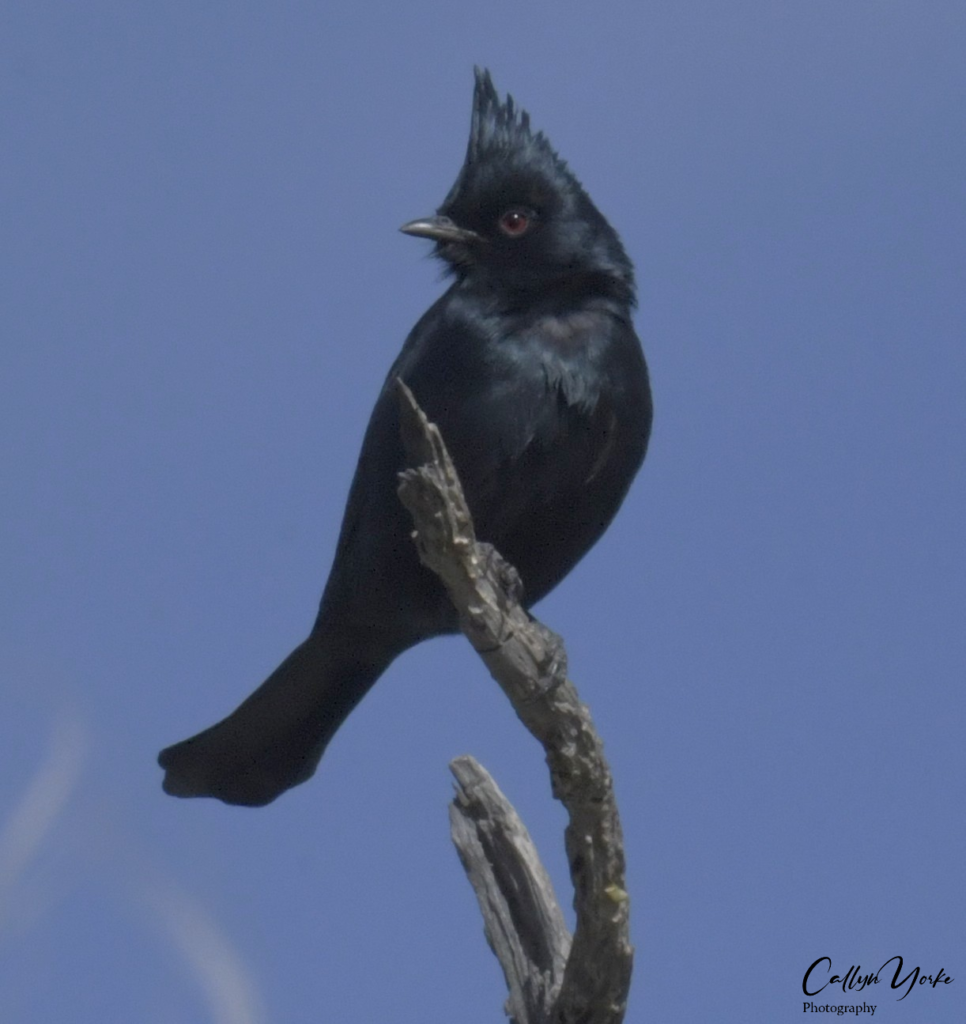
- Scaly-breasted Munia 5 vocal, greg. in willow-riparian patch on upper trail, UCC.
- House Sparrow 5 around restaurant entrance and outdoor seating, EN; 5 greg. on pavement outside of restaurant in main plaza, BP.
- American Pipit 12 greg. a cohesive flock in low, fast flight over bike trail and ice plant and shore, ANB.
- House Finch 8 (m,f) greg. in cottonwoods and mulefat; open and brushy fields, shorelines, parks, gardens and suburbs, UCC, LCC; ubiq..
- Lesser Goldfinch 6 (m,f) vocal, greg. itinerant flocks affecting seeded grasses, shrubs, trees throughout the region, UCC; ubiq..
- Chipping Sparrow 1 (bsc. plmg.) in msf with VESP, WCSP, SASP, in shrubs at edge of main hot springs pond, JAC.
- Clay-colored Sparrow 1 (ad.) in msf with VESP, WCSP, SASP, CHSP, in shrubs at edge of main hot springs pond, JAC.
- Brewer’s Sparrow 8 (bsc. plmg.) greg. pairs and small flocks, often msf with other sparrows (VESP, WCSP, SASP) in brushy borders of main pond, ravines and desert scrub, JAC, JCP (photo).
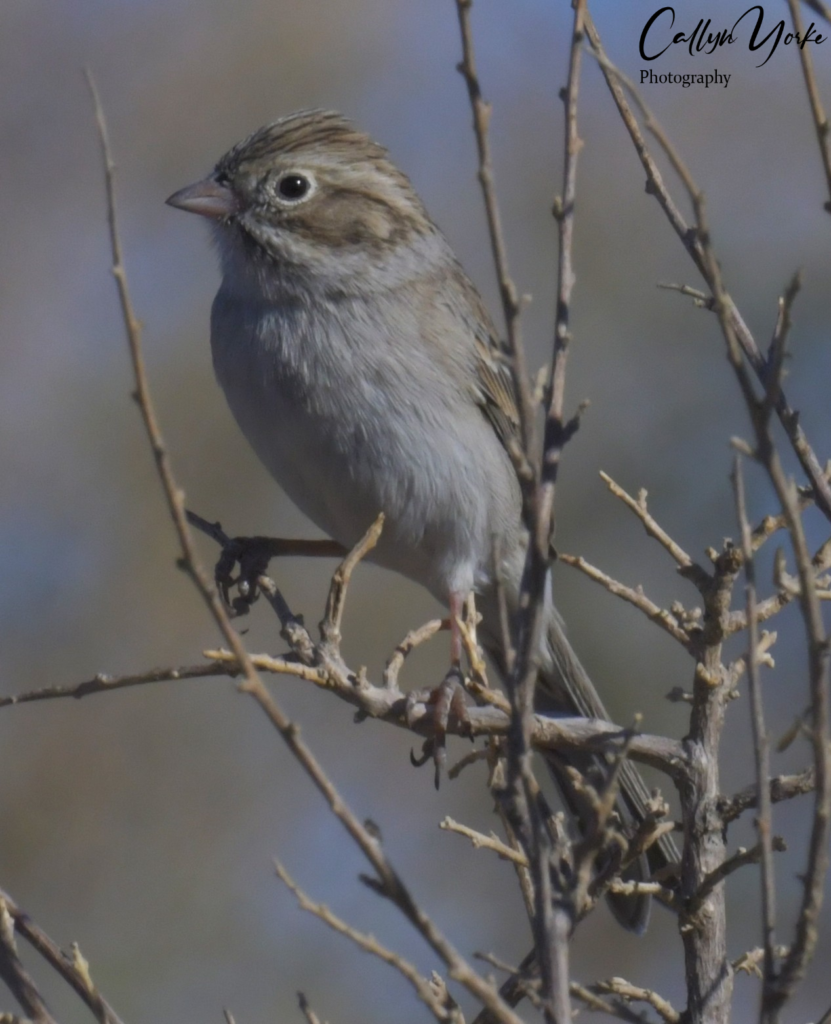
- Black-throated Sparrow 1 in flight se over sage scrub hillside above the main hot springs pond, JAC.
- Dark-eyed (Oregon) Junco 5 greg. foraging on ground beneath conifer trees, BP.
- White-crowned (Gambell’s) Sparrow 20 (ad., imm. -about 20% overall), vocal (calls and song) greg., in brushy fields, adjacent trees; parks, suburbs and gardens, JAC; ubiq..
- Vesper Sparrow 10 (bsc. plmg.) greg. occasionally on ground, drinking from hot springs, and often in msf with SASP, WCSP, BRSP and other small passerines, brushy borders of the main hot springs pond; ravine and desert scrub, JAC, JCP (photo).
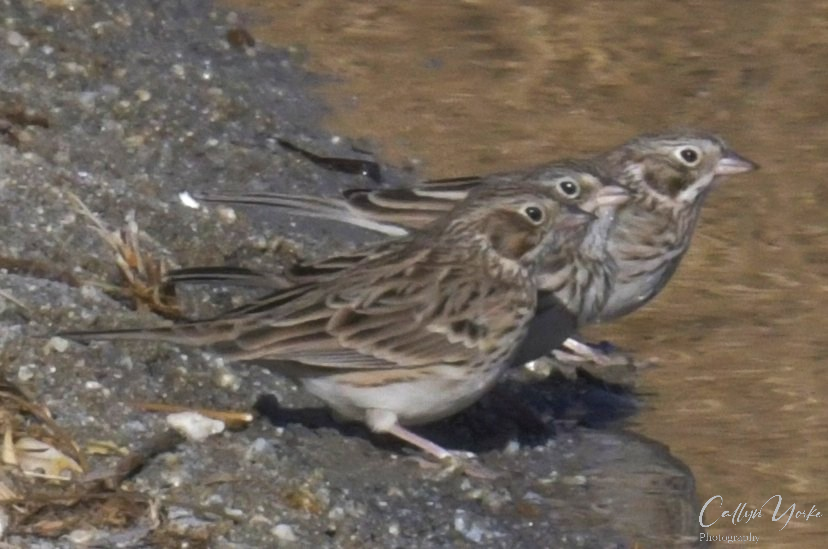
- Belding’s Saltmarsh Savannah Sparrow 8 greg. pairs flushed short distances in salt marsh bordering main channel and inundated flats, SEL.
- Large-billed Savannah Sparrow 1 in Atriplex sp. and Salicornia, trailside near the visitor’s center, SEL.
- Savannah Sparrow 5 (phenotypically variable; subspecies assignment dubious in this region, outside of the breeding season (e.g., Dunn & Alderfer 2017. p. 573) ; most birds appeared similar to those commonly wintering further north, e.g. interior LACO; dark streaking averaging about two shades paler than Belding’s; most but not all, showing a conspicuous yellow supercilium) 5 greg. in brushy borders of main hot springs pond, ravine; often on ground in msf with WCSP, VESP.
- Song Sparrow 12 greg. a relatively large flock of 10 foraging on ground in picnic area at lakeside, GRP; 1 in marsh bordering small hot springs pond, JAC. wetlands – coastal and interior; resident populations augmented by migrants, ubiq..
- California Towhee 4 vocal, greg. pairs often foraging together on ground near brush cover; UCC, LCC; coastal sage, riparian, parks, suburbs, ubiq..
- Spotted Towhee 1 secretive in brushy riparian area at side of nature trail, GRP.
- Western Meadowlark 1 in open, ruderal hillside field, GRP.
- Red-winged Blackbird 20 (ad., imm; m,f; bsc. plmg.) greg. vocal in and around marsh and overhanging willow-cottonwood borders, GRP.
- Brown-headed Cowbird 12 (m,f) greg. with BRBL in shaded dirt area on ground at edge of baseball field, JCP.
- Brewer’s Blackbird 14 (m,f) mostly silent with BHCO on ground, JCP.
- Great-tailed Grackle 20 (m,f) vocal, greg. individuals, trios in flight and on ground around harbor, OH.
- Orange-crowned Warbler 5, occasionally vocal (calls), greg., individuals and pairs often in msf with YRWA, WCSP and other small passerines from canopy to ground, in seeded herbs, shrubs, trees, gleaning insects becoming active with rising air temperature, LCC; riparian woods, gardens, brushy borders of open fields, ubiq..
- Nashville Warbler 1 active in willows and salt cedar at edge of small hot springs pond, JAC (photo).
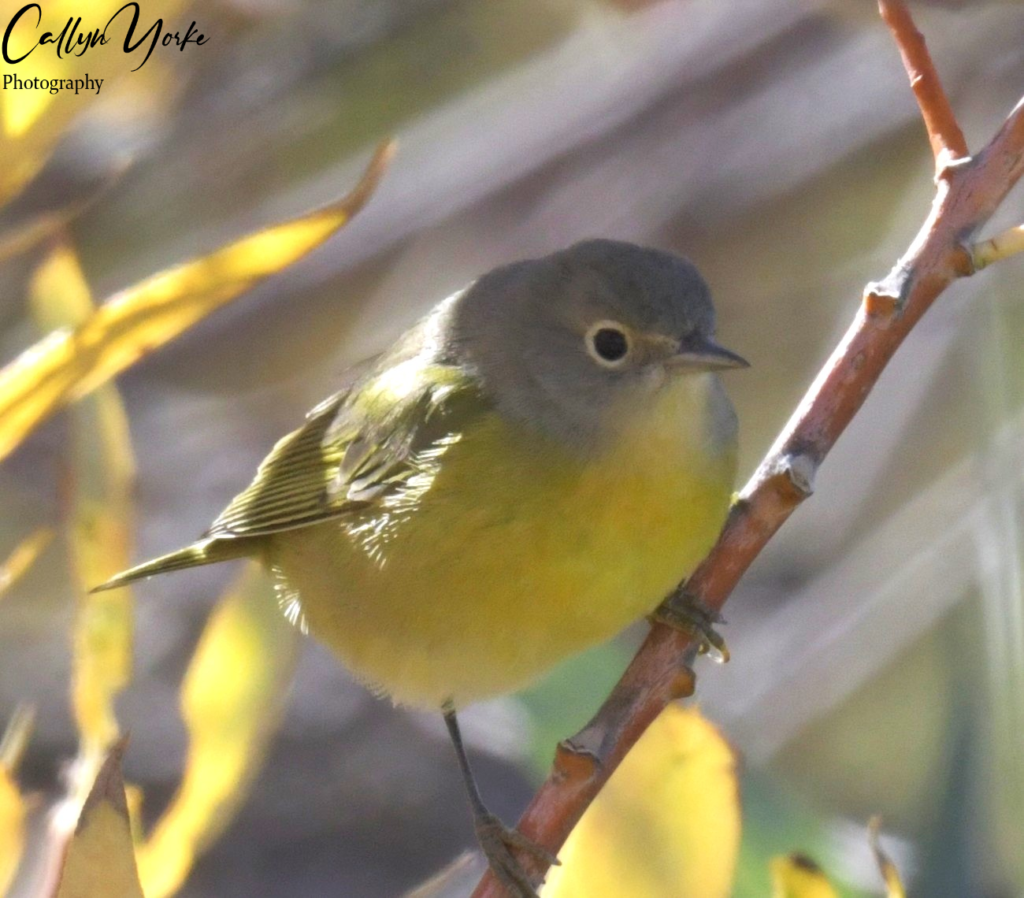
- Common Yellowthroat 5 vocal (calls) in and around marsh of main lake; often with other passerines, e.g. WCSP, SOSP, MAWR, GRP; 1 LCC.
- Yellow-rumped (Audubon’s) Warbler 25 (m,f) vocal (calls), greg. active in all daylight hours; affecting a wide range of vegetation at all foliage height levels – ground to canopy; often in msf with a variety of other avian taxa, BP; ubiq..
- Townsend’s Warbler 1 (m) active in cottonwood foliage, mostly mid to upper levels, UCC.
- Wilson’s Warbler 2 (m,f) greg. occasionally vocal (calls) a pair foraging low to mid-level in willows in msf with YRWA, WCSP and BUTI, LCC.
_______________________________________________________________
28 August – 8 September 2024 SUMMARY (105 Species)
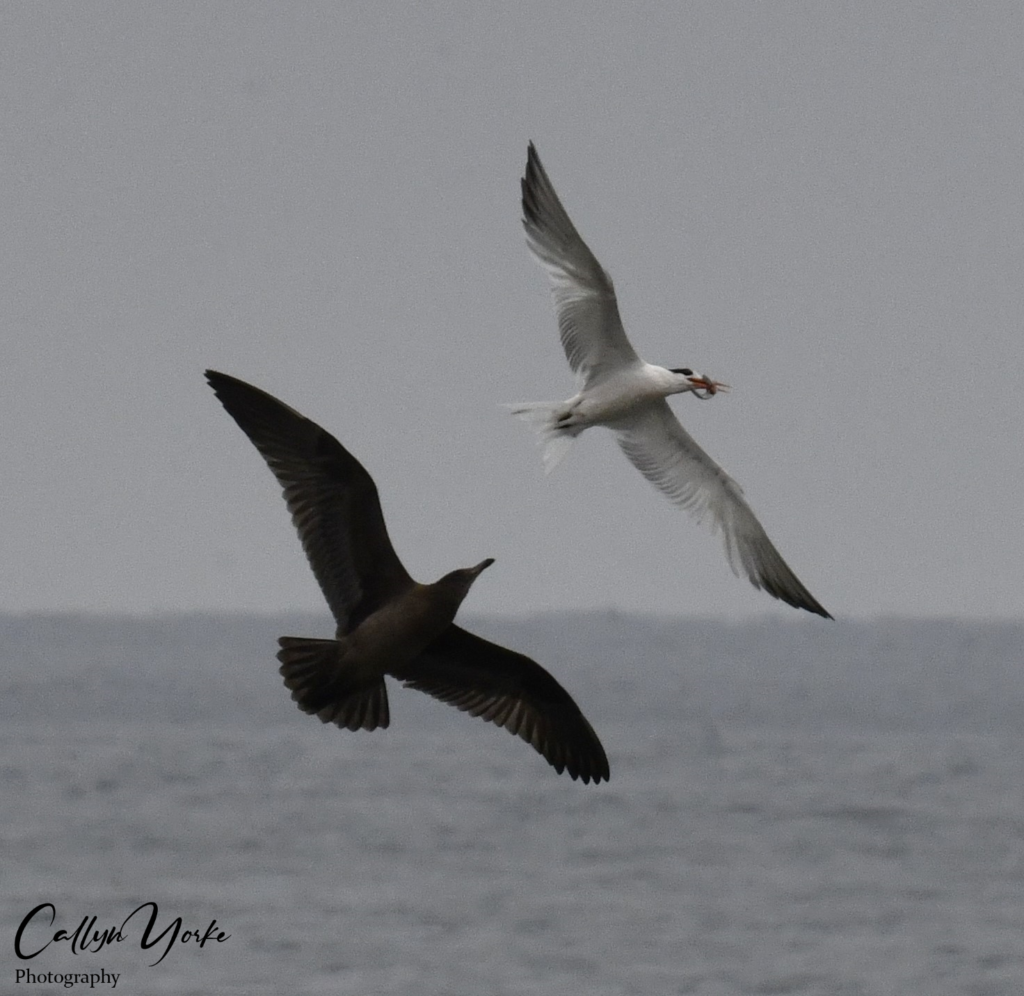
Weather: Overcast with partial clearing by late morning to early afternoon on most days; 65°F to 78°F; wind W, WSW 2 – 15 mph; Seas moderate with increasing onshore winds causing an afternoon chop – surf 1-3 ft..
Time: 0620 -1500 hrs.
Areas Covered:
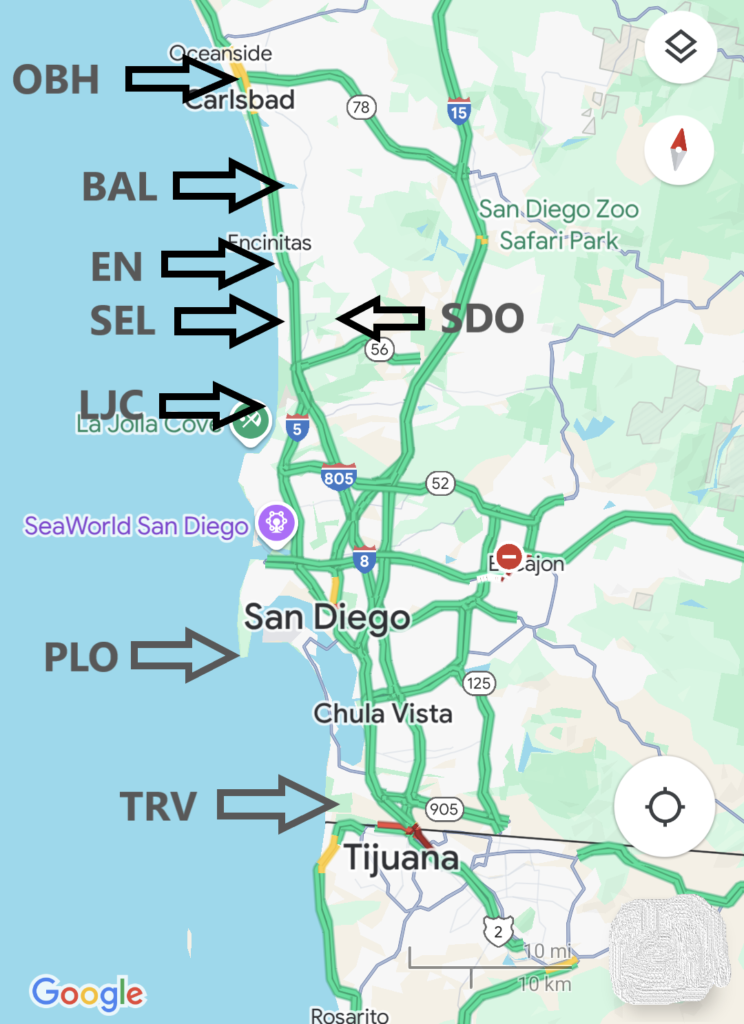
1) Encinitas (EN): Casual daily surveys by car, on foot and while surfing, covering the coastline and suburbs, extending from Brisa Pacifica Hotel (410 Hwy 101), southward to Swami’s. Moonlight Beach (MB), Lower and Upper Cottonwood Creek ecological reclamation areas (LCC; UCC – 28 August, 0630-0815; 1042- 1202 hrs.). These areas were heavily impacted with holiday visitors (Labor Day weekend), many with dogs (leashed and unleashed). A small homeless encampment has persisted in LCC. Several more homeless individuals occupied park benches in UCC. While in UCC, I met the caretaker, Ted Wilson, who informed me that LCC and UCC officially opened in 2004, about two years before my nearly annual bird surveys of this area were initiated. Since that time, plantings of native shrubs and trees have flourished (invasive grasses and herbs are periodically removed), producing a well developed riparian corridor (e.g., arroyo willow thickets and 50 ft. sycamore canopies in UCC). Water in Cottonwood Creek flows beneath a series of paved roadways to LCC, terminating at MB. Willow, Coast Live Oak Cottonwood and Sycamore trees attract a variety of warblers and finches. A partially restored coastal sage slope along the UCC trail extension paralleling I-5, supports a characteristic ecological assemblage of birds, including a relatively new addition, a CDFW and USFWS – listed Endangered Species, California Gnatcatcher. Downstream, the Cottonwood Creek outlet at MB is a focal point for shorebirds, particularly wintering gulls. Depending on the season, bird surveys combining the three locations (MB, LCC & UCC) may yield a total of 25-35 species, including resident and transient birds.
2) San Elijo Lagoon (SEL – 29 August, 0830-1135 hrs.). Initially, I entered the San Elijo Lagoon wetland reserve at N. Rios Ave. and hiked a well traveled trail down through coastal sage scrub and into a brackish tidal marsh (SWSEL). Continuing westward under a railway bridge, the trail t- junction overlooks a lagoon with a small, shallow island where shorebirds sometimes congregate. Relatively few birds were seen in this area. Significantly, dozens of people were on the trail with their dogs.
Next, I drove via Solana Beach and I-5, to the northwest San Elijo Lagoon visitor center and walked the adjacent trails overlooking habitats that included tidal channels, marsh and riparian woodland (NWSEL). A small patch of coastal sage scrub also occurs around the visitor center, adding marginal habitat heterogeneity to the natural preserve. I walked the riparian perimeter once, then through it on an elevated boardwalk. The remaining time was spent scanning the extensive marsh and distant tidal channels with a 10 x 42 binocular. Here, a spotting scope would have been useful, since most of the birdlife was distant from the trails in the central area of the marsh. Notable sightings in NWSEL, included Ridgeway’s Rail, White-faced Ibis and a comparatively small cormorant, tentatively identified as Neotropic Cormorant (photo).

Unfortunately, birdlife in this important coastal wetland is visibly affected by a daily parade of canines and their owners — people who apparently think that everyone else appreciates seeing dogs romping in nature. Birds definitely don’t see dogs that way, whether leashed or unleashed; most of them go into hiding or worse, simply leave the area. Despite having dedicated public areas for dogs throughout the region, this mindless, unnecessary drama plays out daily in practically all of the accessible natural areas in San Diego County.
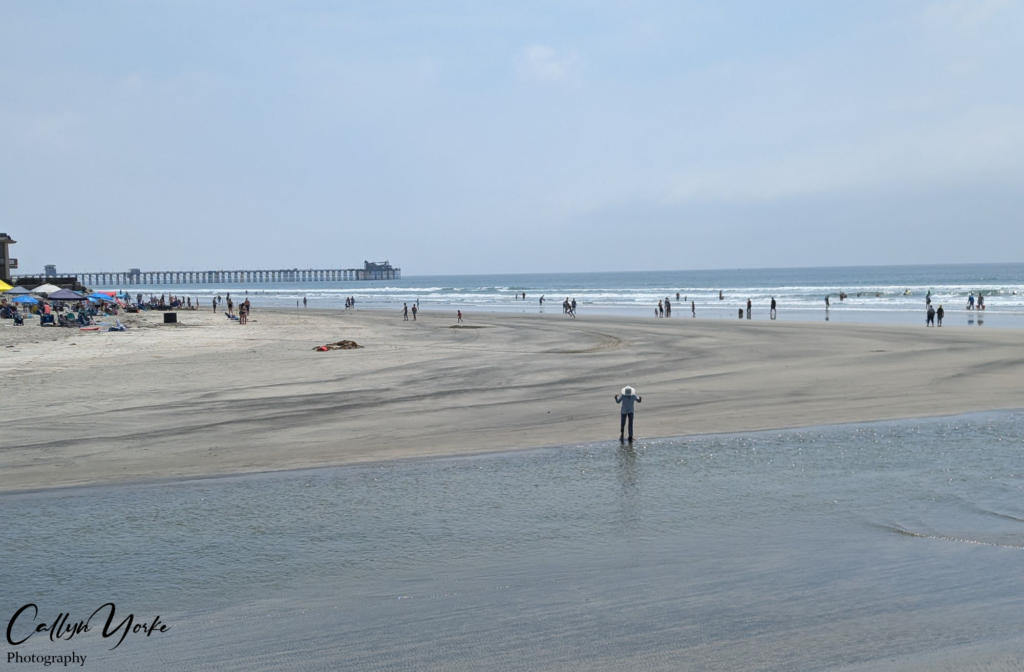
3) Oceanside Beach and Harbor (OBH – 30 August: 0720-1330 hrs). I made an initial drive-through survey on the perimeter of the Oceanside Harbor — watching for birds in a roadside mix of exotic plantings and fragmentary coastal sage scrub, adjacent fishing docks and breakwaters. Subsequently, on foot, I focused on the main beach and adjacent mouth of the San Luis Rey River. The largely unclaimed beach and shoreline on an outgoing tide, initially had a fair number of birds (mainly Western, California and Heermann’s Gull, Royal Tern and Willet), decreasing with the arriving holiday crowds. Meanwhile, several explorers, some throwing sticks for their dogs, invaded the San Luis Rey River mouth, pushing upstream to the main river channel under the roadway bridge. Not unexpectedly, this area, which on a quiet weekday has been quite productive, attracted few birds.
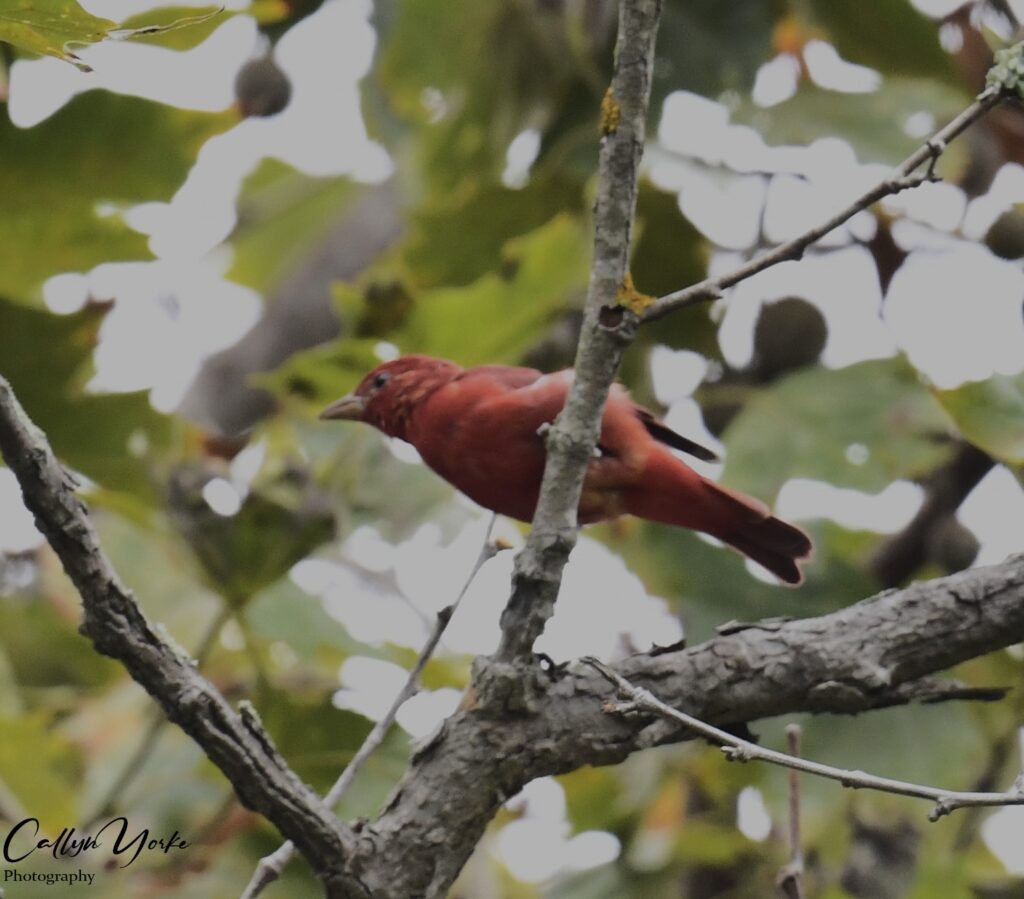
4) San Dieguito County Park (SDP – 31 August: 0644-0930 hrs.). The upper main gate to the park was closed and locked when I arrived. Off-street parking was available and a walk-in gap in the front fence allowed access to the interior park trail system. I walked most of the park trails in the upper section, followed by a partial walk-through of the lower section around the water features and lawns.
The upper section of the park was a mix of disturbed and undisturbed coastal sage scrub, bordered by Eucalyptus woodland, paved parking lots, playgrounds and a baseball field. The lower section had typical urban park landscaping, including two small ponds, one with a fountain spewing algal-green water, a flock of tame mallards, mowed lawns, tall plantain and a variety of other ornamental trees, including conifers. I estimated my visual coverage during the survey at about 35 acres. The final tally of birds found in the park was 23 species, including 7 new species for the trip list, e.g. California Thrasher, Western Tanager and Summer Tanager (photo).
5) Tijuana River Valley (TRV – 1 September, 0654 -1425 hrs), including Dairy Mart Pond (DMP, 0654-0800 hrs.); Bird and Butterfly Garden (BBG, 0900-1045 hrs.); Hollister and Sunset Rd. farm house and alfalfa field (HSR, 1045- 1100 hrs.); Tijuana River – Slough – Estuary – National Wildlife Refuge (TENWR, 1112-1300 hrs.) and the adjacent stretch of Imperial Beach (IMB, 1308-1425 hrs.).
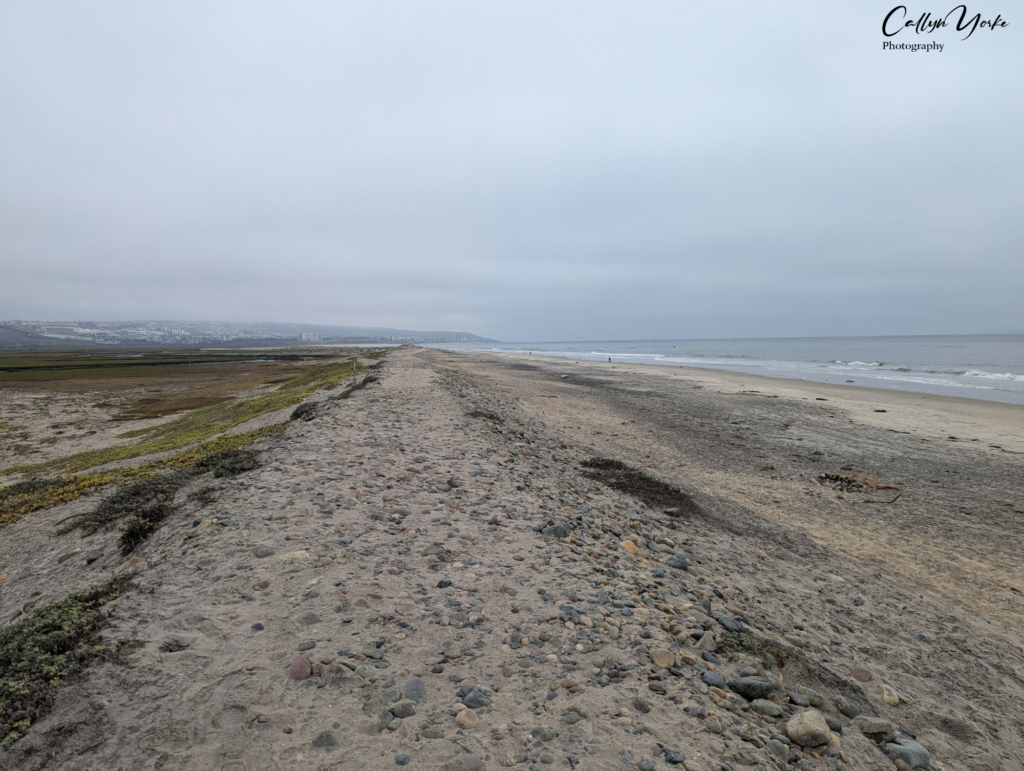
My TRV survey began at Dairy Mart Pond (DMP), with a heavy overcast and light mist. At this hour, DMP was quiet and little disturbed by human activities. There were only three partial vantage points on the south side of the pond: a wooden wall-blind near the parking lot, an observation deck several yards away and a small clearing littered with toilet paper. The remainder of the pond, as far as I could see, had a border of tall, dense vegetation, consisting of invasive giant reed, castor bean and native riparian elements, obscuring a clear view of the water. I walked the pond south perimeter trail for a distance of about 0.1 mi., reversing direction and returning to the roadside parking area.
Most of the birds seen were in the pond, perched on snags, or partly concealed around the interior marsh, as observed from one of the three aforementioned viewing locations. Two other birders simultaneously surveyed additional habitat to the south and west; they reported having also seen very little birdlife in the DMP area.

Continuing by car on rough roads heading southwest then north on Hollister Rd., my next stop was at the Bird and Butterfly Garden (BBG). One other car was in the parking lot when I arrived; several more with a group of birders arrived soon thereafter. A strong hydrogen sulfide (H₂S) odor prevailed throughout the area, ostensibly due to anaerobic decomposition of sewage and dead vegetation in the TRV (local beaches have frequently been closed due to high coliform bacterial counts).
I walked the pathways around the parking area and gardens, where a dripping faucet and saucer had been placed in the shade for a bird bath — attracting the one Wilson’s Warbler seen during my current SDCO surveys. I continued on a sandy trail westward into a mixture of coastal sage and riparian scrub, to a distance of about 0.25 mi., returning the same route, following an equestrian. When I arrived at the parking area, a Black-throated Magpie Jay was quietly preening in the crown of a tall salt cedar. It was the only individual of this highly gregarious species seen during my survey (photo). Subsequently, I met a Taiwanese birder-photographer who reported seeing two of these birds at BBG earlier that morning; he said that one of the birds came down close enough for him to obtain some good quality images. I was not so fortunate in that endeavor.
Tijuana River – Slough – Estuary National Wildlife Refuge (TENWR). I began a walking survey on the pathways surrounding the visitor center. Very little birdlife was found in the immediate area. I continued walking south on the McCoy Trail to its terminus. The tide was low, exposing mudflats along the marsh channels, where shorebirds (mostly Western and Least Sandpiper) were numerous.
Larger-sized shorebirds were to be found along the western border of the marsh, across the street from an Imperial Beach apartment building. There, I photographed dozens of Willet, Short-billed Dowitcher, Whimbrel and a pair of Lesser Yellowlegs. Further southward, along the levee separating IMP and TENWR, flocks of Brown Pelican and Elegant Tern were diving for small fish nearshore; A loosely aggregated, mixed species flock of Western and Clark’s Grebe was also in this area.
The TRV day’s tally was 66 bird species, including several shorebird additions to my San Diego County trip list.
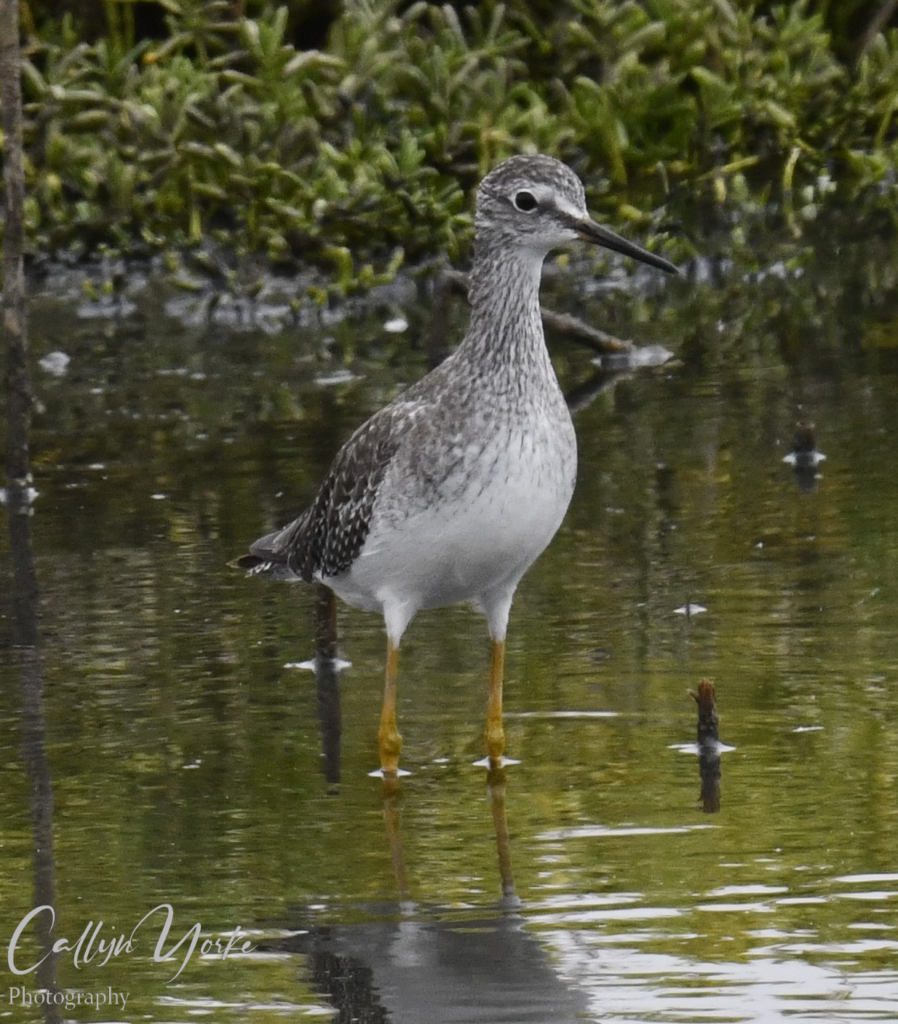
6) La Jolla Shores and Cove (LJS, LJC – 3 September, 0707-0915 hrs.). Today I had scheduled primarily for surfing at LJS (0925-1300 hrs.), following a morning bird survey at La Jolla Cove (LJC, 0707-0915 hrs.). I began the survey on the Coast Walk trail of LJC, at the ‘sea watch’ wooden stairway. From there, I proceeded slowly northward about 200 yards on the trail, returning the same route. The trail overlooks steep, unstable cliffs and a rocky shoreline below. The opposite slope supports a series of luxury homes and gardens with marginal ornamental flowering shrubs and trees, trimmed so as to avoid spoiling the view. Scattered stands of coastal sage scrub and ruderal patches with flowering Tree Tobacco dominate the downslope edges (west side) of the trail. A highlight at this location was an immature Vermilion Flycatcher (photo).
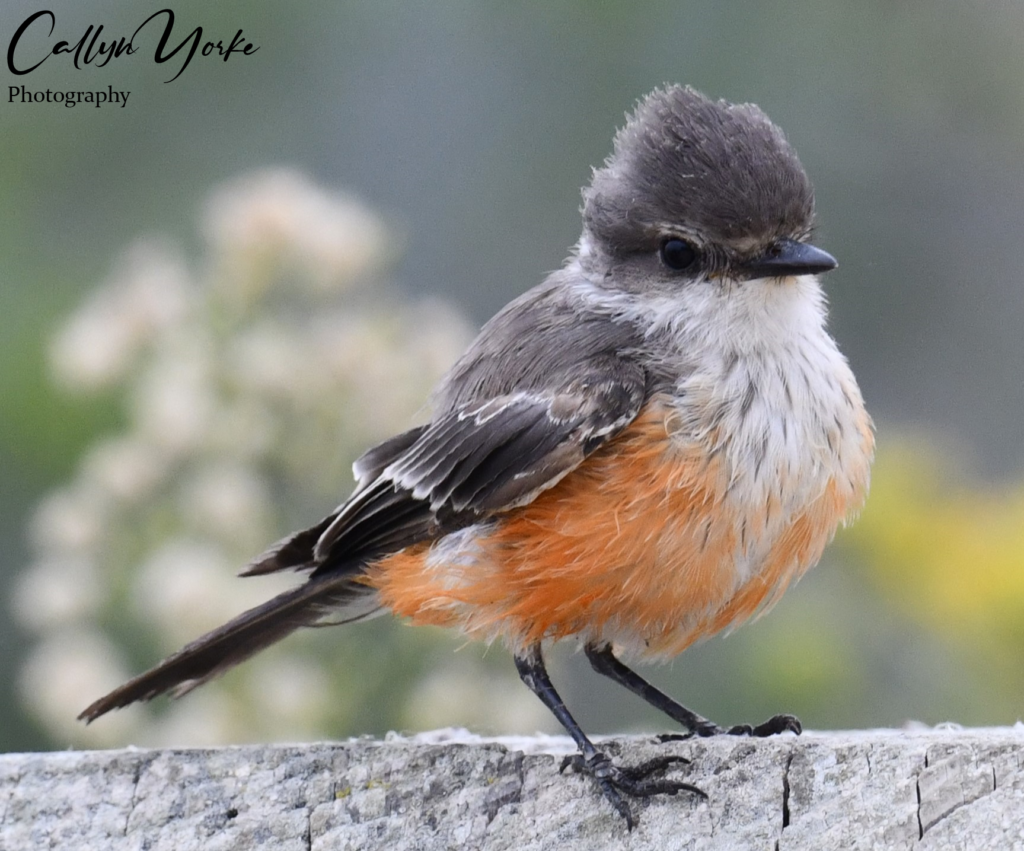
I continued southward on the paved portion of the Coast Walk overlooking the cliffs and shore — mostly inundated by a rising tide. A colony of at least 350 Brandt’s Cormorant (adults and juveniles), together with Brown Pelicans and California Sea Lions, populated the cliff ledges throughout the area.
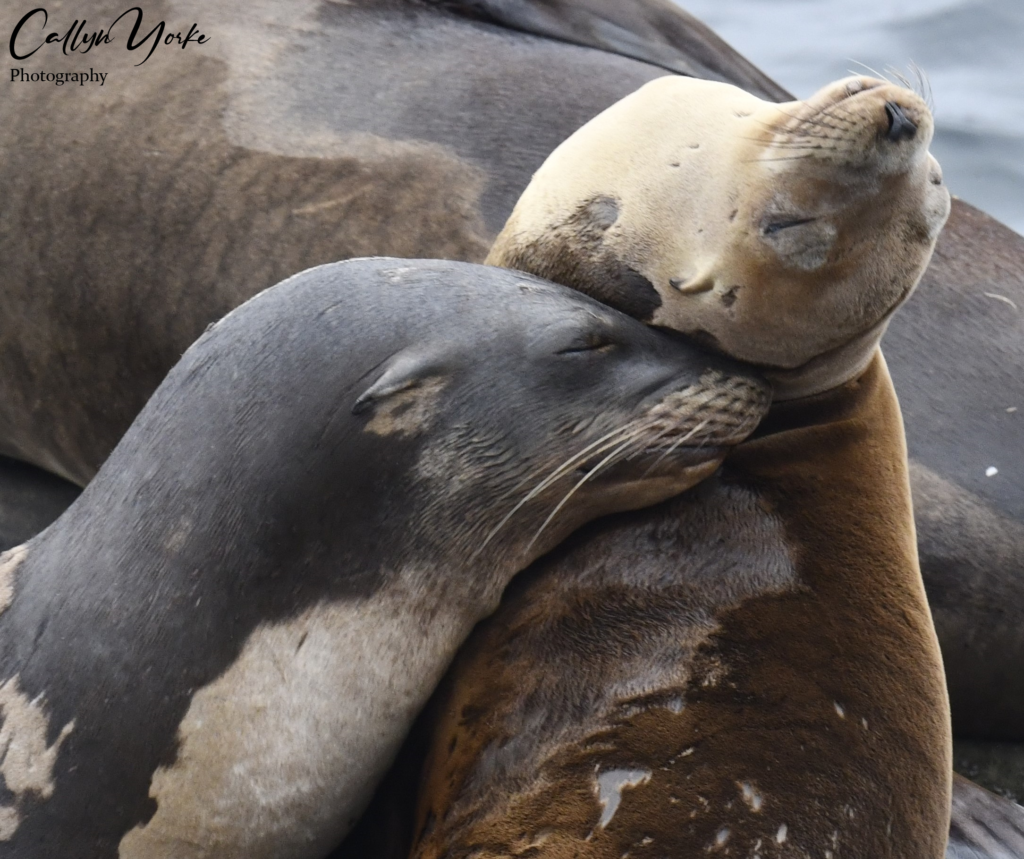
A single Pelagic Cormorant was swimming near shore (photo), while a flock of about twenty Double-crested Cormorant occupied the large pines overhanging the ‘sea watch’ stairway.
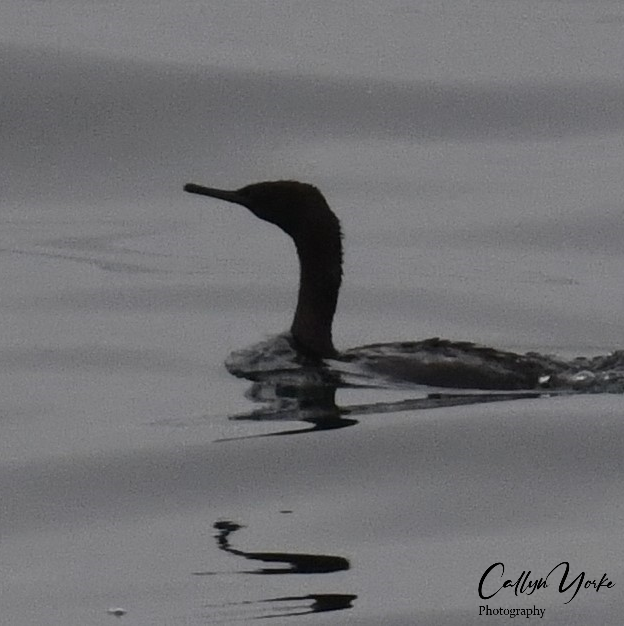
7) Point Loma (PLO) – 4 September, 0709-1045 hrs.: Fort Rosecrans National Cemetery (RNC, 0709-0751 hrs.); Sunset Cliffs Natural Park (SCP, 0820-0913 hrs.). Cabrillo National Monument (CNM, 0930-1045 hrs.).
I drove slowly, once through RNC, entering at the northwest gate (main entrance) and exiting at the south gate, briefly surveying both east and west sections, including the adjacent roadside of Cabrillo Memorial Drive. Several warbler-sized passerines in distant trees remained unassigned; I failed to locate any of the recently reported RNC rarities, e.g. Virginia’s and Lucy’s Warbler.
The next Point Loma birding location was Sunset Cliffs Natural Park (SCP, 0820-0913 hrs.) beginning at the northwestern entrance on Ladera St.. I walked the park trail system through coastal sage scrub on a severely eroded slope ending abruptly at high cliffs overlooking the Pacific Ocean. At first glance, this ‘natural area’ appeared to have been conveniently given such distinction due to the unstable land being largely useless for residential/commercial development. Essentially, that may have been true. However, signage in the park indicated that these badlands contain significant Pleistocene fossil deposits of marine invertebrates.
Apparently disinterested in the notable natural history of the place, local residents and visitors appeared to be using the trails mostly for exercise and dog-walking. Again, this is the predominant trend in San Diego County. Ok, I get it. Not everyone has a degree in Biology. But would it be so difficult to simply purchase an elementary field guide and begin appreciating the wonderous diversity of life that somehow manages to survive in San Diego County?
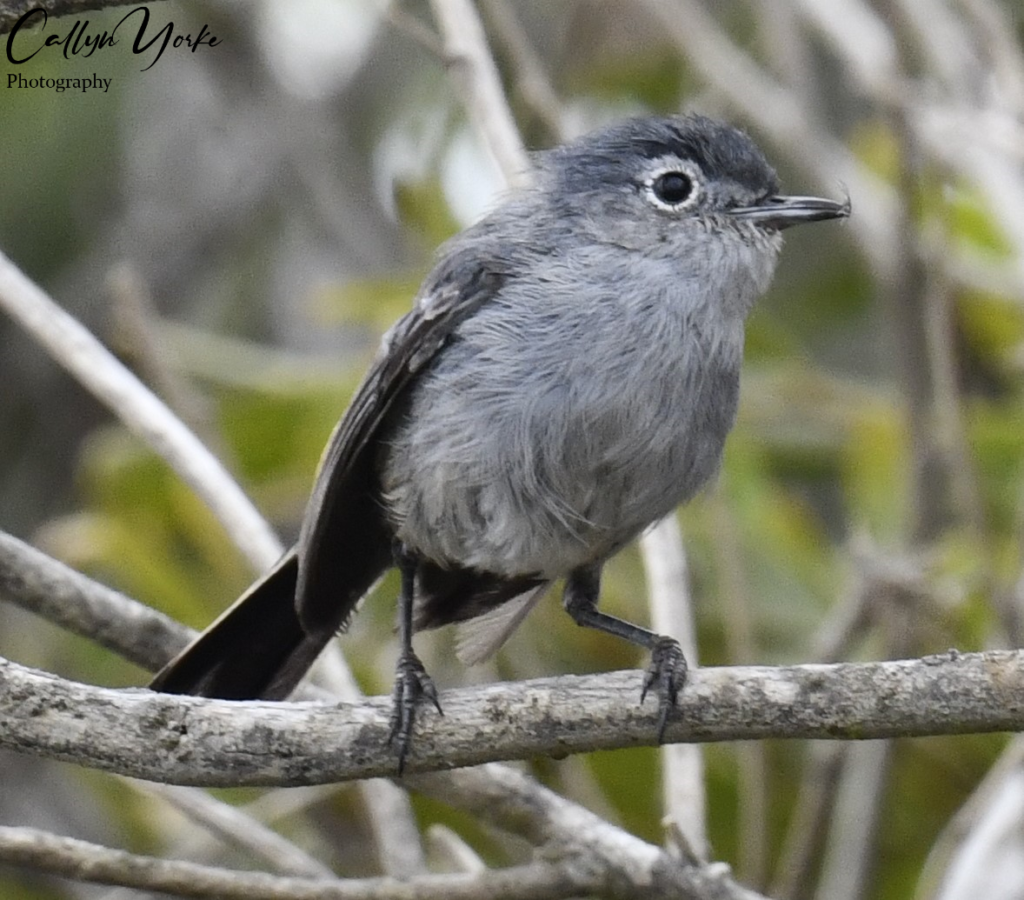
As I walked through the park, a well concealed Wrentit and Song Sparrow vocalized briefly. If there was additional birdlife present, it was keeping out of sight in a dense coverage of sage (Salvia spp.) and Lemonade Berry (Rhus integrifolia). Gasoline-powered weed- trimmers were being used in the northwest and central sections of the park. Joggers and dogs were on the trails. Western Gull, Heermann’s Gull, Royal Tern and Brown Pelican were in flight offshore. A busy trio of California Gnatcatcher offered a brief photo opportunity near a residence in the northwest corner (photo). Stealing the show, the coastal scenery was breathtaking. In the distance, a couple of barefooted surfers hesitated to scan the seas before starting down a treacherously steep trail (photo).
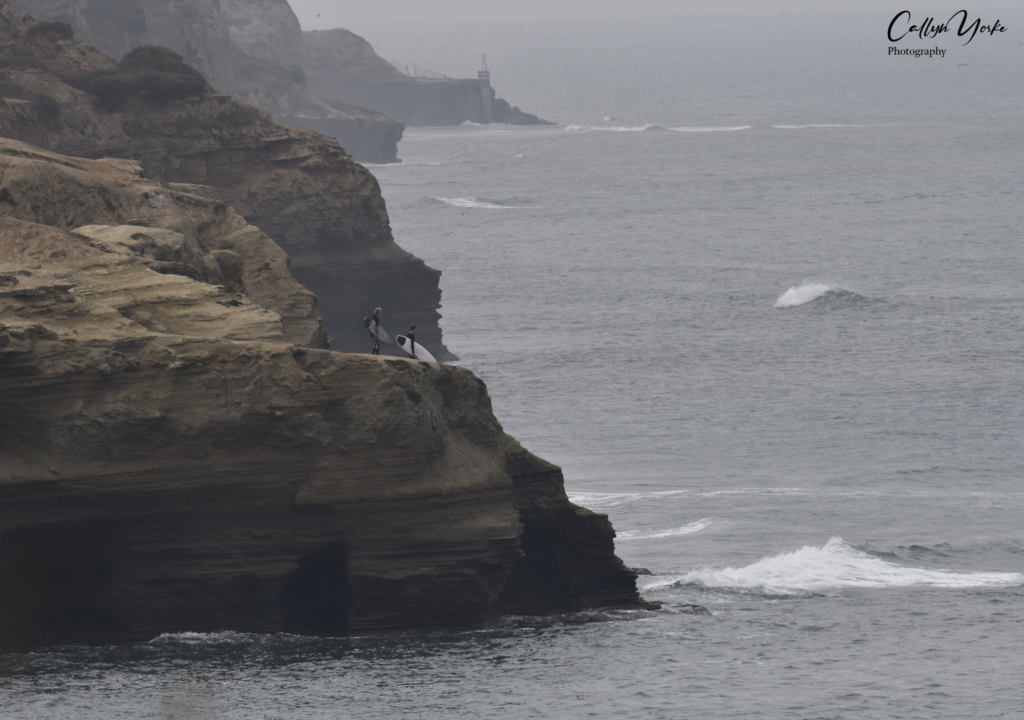
The final Point Loma survey area this morning was a relatively small, hilltop section of Cabrillo National Monument (CNM, 0930-1045 hrs.). I walked trails around the visitor center, lighthouse and parking areas, looking for migrant birds that might be clinging to isolated pines jutting out of the windswept coastal sage scrub. No luck there. The only new birds for my Point Loma day-list were seen in the live oak – chaparral canyon below the lighthouse — California Scrub Jay and California Thrasher — both species I had already found in San Dieguito Park. About fifty middle school students arrived at the visitor center as I was leaving. The parking lot was filling up. Automobile traffic through the Point Loma Naval Base was moderately heavy. By late morning, gusty west winds were rattling the many flag poles.
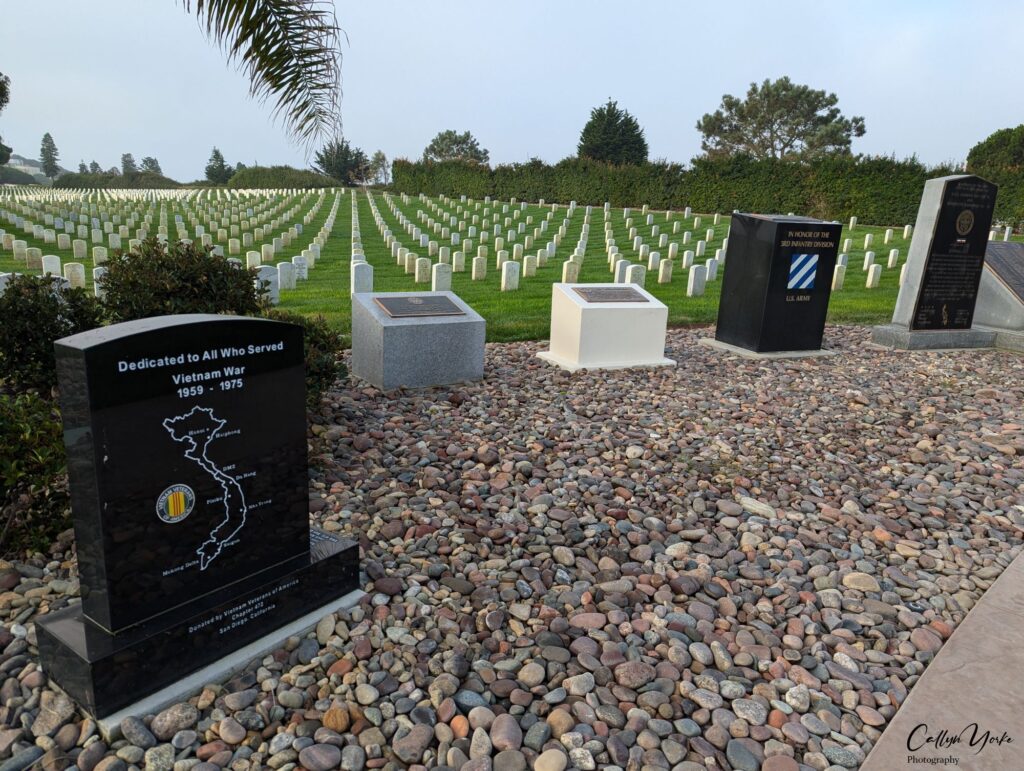
8) San Diego Botanical Garden, Encinitas SDBG – 5 September, 0900-1200 hrs.. Beginning at northeast corner parking lot and gated entrance, I walked most of the pathways through the gardens, except for those blocked off to pedestrian traffic in the northwest section. The gardens feature large patches of California native vegetation, e.g. coastal sage scrub, alongside a mosaic assemblage of global plant communities, including conifer and angiosperm rarities. Many exotic shrubs and trees had showy flowers and fruit attractive to birds. I estimated the area visually surveyed inside and immediately adjacent to SDBG to be roughly twenty-five acres, covering about 70% of the SDBG property.
This was a particularly warm, sunny day (79°F to 84°F) with steady onshore winds. Unfortunately for birders, the gardens open decidedly late in the morning (0900 hrs.; closed Tuesdays) and charge a rather hefty entrance fee ($18 general admission; seniors $12). As a consolation, abundant shade was available throughout most of the gardens. Initially, I searched for birds in those relatively cooler, shady spots. However, most of the birdlife was found at the edges of clearings.
Disturbance from human activities was minimal on the property. Several volunteers were manually removing unwanted vegetation in the eastern section near the Children’s Garden; most of the remaining areas of SDBG were wonderfully peaceful and quiet – visited only briefly by meditative couples and small family groups. Remarkably, absolutely no dogs or cats were seen in the gardens. I’m guessing that pets, like weeds, are rigorously excluded from SDBG.
Hummingbirds (Selasphorus sp.) and White-eye (Zosterops simplex) were the most abundant and conspicuous birds, seen mainly in and around flowering trees in the central gardens. The final tally at SDBG was about twenty species of bird; one of those new for my trip list – a lone Chipping Sparrow. Rather surprisingly, no orioles or tanagers were found during the survey. Migrant warblers were also MIA — the only representative from that group was Orange-crowned Warbler, a common resident.
9) Bataquitos Lagoon Ecological Reserve (BAL, 7 September, 0720-1107 hrs.) I began the walking survey at the northeast parking lot, across from the intersection of Bataquitos Rd. and Spoonbill Ln.. This is the northeast trailhead of the northern lagoon trail to the visitor’s center, located about 2 mi. to the west, where I reversed direction and returned along the same route. Most of the lagoon is closed to the public; the eastern portion is fenced and posted as a seasonally protected area for nesting Western Snowy Plover and California Least Tern (I observed neither of those species in BAL this morning).
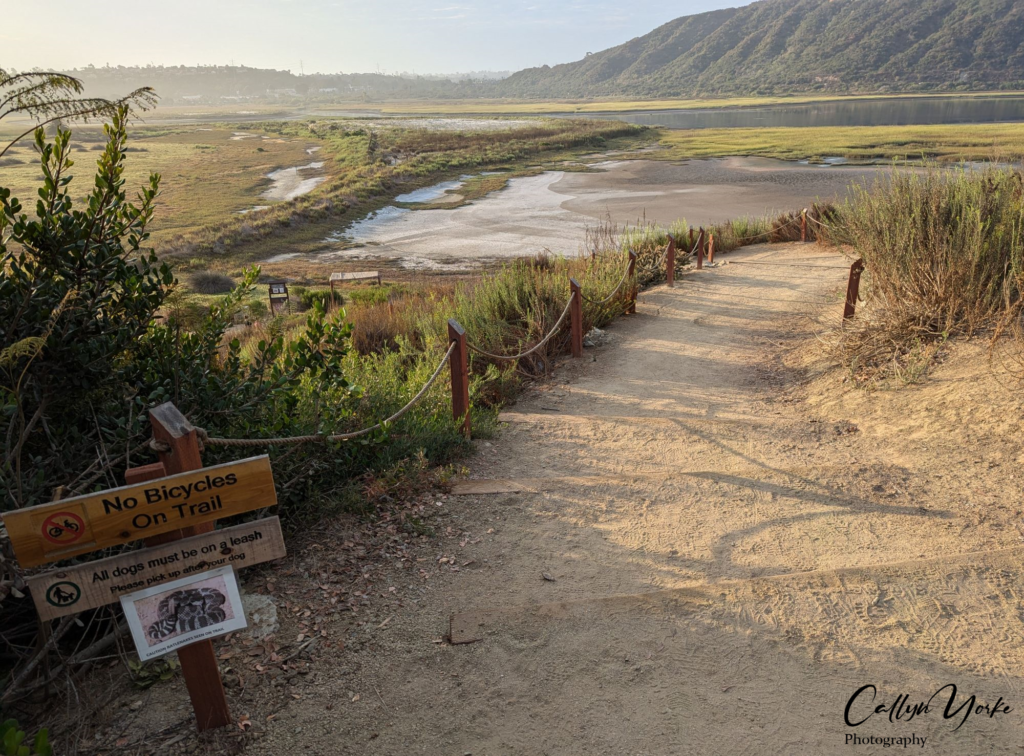
The Bataquitos Lagoon trail passes through mature Eucalyptus woodland, coastal sage scrub, marginal salt marsh and a willow-riparian patch. A golf course with an artificial pond borders the north-central section of the trail. Birds in the inaccessible lagoon, tidal mudflats and marsh are frequently visible at distances requiring a spotting scope and tripod. The majority of shorebirds foraged on the tidal mudflats in the southeast corner of the lagoon, which was well out of binocular range for specific identification, e.g. Dowitcher spp.. I made digital images of the inaccessible, distant lagoon mudflats and marsh using a Nikon D850 and pf 500mm lens – some of those images, when examined later on a laptop monitor, showed identifiable species, e,g, Common Tern (photo). Fortunately, on my return walk to the east trailhead, a nearby alkaline sink, partly inundated by the incoming tide, had attracted several shorebird species that I had previously missed, including Black-necked Stilt, Semipalmated Plover, Western Sandpiper and Least Sandpiper.
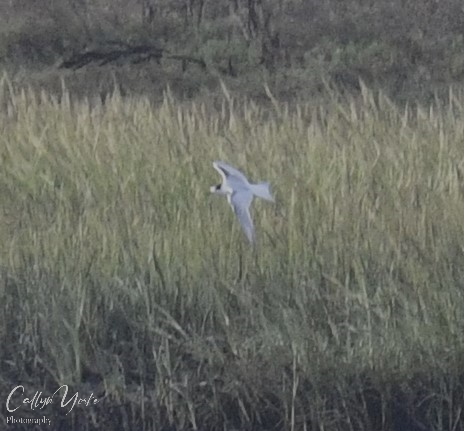
Resident birds were fairly easily found along the trail, as some species, e.g. Allen’s Hummingbird, Black Phoebe, House Wren, Song Sparrow, California Towhee and Common Yellowthroat, appeared habituated to the many people using the trail for exercise and dog-walking. Migrant land birds, e.g. sparrows, warblers and icterids were largely absent.
Three other birders were met briefly during my survey, including Ted Keyel, a new resident in the area and formerly a wildlife biologist consultant from Wisconsin. We had a civil exchange regarding the scientific usefulness of eBird, with opposing opinions. Ted argued that eBird had merit at least for presence/absence data. The sheer volume of combined eBird reports, monitored by programmed filters and expert reviewers, would seem to lend support to that claim. My position was from a strictly science oriented view, questioning the reliability and repeatability of eBird data, particularly due to uncertain methodology and accuracy of the reports. We both agreed that eBird has limitations – and that’s putting it politely. In technical terms, eBird data is a minefield for Type I and II errors.
That is not to say eBird is entirely worthless. There is no doubt that eBird is a useful social media platform for recreational education – assisting with bird identification, status (for both birds and birders), distribution, and incidentally, the desperate need for habitat and wildlife conservation. All good there. But the eBird leaders apparently want it to be much more than that. eBird.org has developed into an imaginative and ambitious online service with an aggressive, almost take-over style business model.
eBird’s principal owner and promoter is Cornell University, which broadcasts eBird worldwide as ‘Citizen Science.’ To my ear, that sounds like the Special Olympics hijacking the bus to the actual Olympics. Handicaps may be compensated in certain sports but certainly not in the Natural Sciences, where the margin for error is, by convention, 5%. The reality is that the rapidly growing eBird data base is riddled with too many errors and inaccuracies. Reviewers (presumably volunteers) simply can’t keep up with the thousands of daily eBird data entries. In my experience, except for the eBird folks at Cornell University, Academia is in a majority agreement – that no first-rate scientific inquiry should ever depend on eBird data for anything more than perhaps raising meaningful biological questions and potentially testable hypotheses.
Annotated Bird List
Abbreviated site localities in chronological order are as follows: Encinitas neighborhood (EN); Moonlight Beach, Upper and Lower Cottonwood Creek (MB; UCC; LCC); Southwest and Northwest San Elijo Lagoon (SWSEL; NWSEL); Oceanside Harbor, Beach and mouth of the San Luis Rey River (OBH; SLR); San Dieguito County Park (SDP); Tijuana River Valley (TRV), Dairy Mart Pond (DMP), Hollister and Sunset Rd, (HSR) Bird and Butterfly Garden (BBG), Tijuana Slough-Estuary-National Wildlife Refuge (TENWR), Imperial Beach (IMB); La Jolla Shores (LJS) and La Jolla Cove (LJC); Point Loma: Ft. Rosecrans National Cemetery (RNC), Sunset Cliffs Natural Park (SCP) and Cabrillo National Monument (CNM). San Diego Botanical Garden (SDBG).
Actual counts are given for a species location; when there were more than about thirty individuals, I estimated by counting groups of ten..
Plumage and behavioral categories are abbreviated as follows: basic – nonbreeding plumage (bsc plmg); alternate – breeding plumage (alt plmg); molting – transitional plumage (trans plmg); adult (ad); juvenile/immature/ subadult (imm); gull age classes – first cycle, second cycle, C1, C2, etc.); male (m); female (f); associated with a mixed species flock (msf); estimated height in ft. above ground or water (agl); probing substrate (prb); insect – arthropod gleaning, i.e. from foliage (igl); hover or snatch-gleaning (hog); aerial hawking, e.g. of flying insects (aha); consuming flower parts, nectar, fruit, seeds (frg); gregarious – in pairs or flocks (greg.); widespread occurrence in appropriate habitats (ubiq.) – for bird species in this category, only the location with the highest count is given.
BIRDS NOTED
- Blue-winged/Cinnamon Teal 2 (f) a pair swimming at the north edge of the pond and bordering marsh, DMP.
- Gadwall 15 (m,f) greg. – swimming and alighting in the pond in pairs and trios, DMP.
- Mallard (wild type) 25 (m,f) greg. pairs and small flocks in marsh, ponds, tidal sloughs, fresh and brackish water; NWSEL; ubiq..
- Surf Scoter 2 (m) greg., seen while on my surfboard; a pair in fast, northbound flight, low, about 250 yards offshore, LJS.
- Ruddy Duck 2 (m,f) greg. a pair swimming on the north side of the pond near the marsh, DMP.
- Pied-billed Grebe 2 individuals swimming near the marsh, DMP; 3 greg. in adjacent golf course pond, BAL.
- Western Grebe 18 greg. in a loose msf with CLGR about 200 yards offshore; Brown Pelicans and Elegant Terns diving for small fish just outside of the surf zone, IMB; 1 swimming in open water of the outer harbor, OBH.
- Clark’s Grebe 10 (possibly more in the distance) a loose aggregation in a msf with WEGR, as noted above, IMB.
- Feral Rock Pigeon 40 greg. on pavement, beach, open ground, utility lines, buildings MB; ubiq..
- Eurasian Collared Dove 2 on utility lines around farm houses, HSR; 2, EN; noting that dove hunting season has recently begun, EUCD is apparently more abundant and widespread in LACO than SDCO.
- Mourning Dove 6 greg. on utility wire at southern border of SBG; ubiq..
- Anna’s Hummingbird 4 (m, f, imm.) aha while hovering 10 -20 ft. agl above conspicuous perches in coastal sage scrub and riparian patches, BAL; ubiq..
- Allen’s Hummingbird 16 (m) occasionally vocal during intraspecific chases; aha; frg; ID: extensive green feathering on head and back of adults; often territorial chases seen around flowering plants; the expected dominant resident and migratory Selasphorus sp. in coastal Southern California, SDBG; ubiq..
- Rufous/Allen’s Hummingbird 5 ? (m, f, imm) silent, immature individuals, all with fairly extensive green feathering and of uncertain identity (most, if not all I encountered were probably resident and local dispersant ALHU). RUHU is possible, though unlikely to occur for more than a day in same area with numerically dominant ALHU; migratory RUHU moving through mostly the inland region at this time. Hypothetically, expanding coastal populations of ALHU may be competitively excluding migratory RUHU. SDBG; ubiq..
- Ridgeway’s Rail 1 foraging in marsh with WFIB at edge of tidal channel, NWSEL; briefly vocal (unseen) in salt marsh adjacent to narrow tidal channel on McCoy Trail, TENWR.
- Common Gallinule 1 swimming close to the marsh on the north side of the pond, DMP.
- American Coot 12 loosely greg. swimming throughout pond, DMP.
- Black-necked Stilt 8 greg. standing together in marsh adjacent to a tidal channel, TENWR/IMB; 4 greg. in tidal-inundated alkali sink at edge of marsh, BAL.
- Black Oystercatcher 2, a pair mostly resting on a relatively dry, mid-level ledge at high tide, LJC.
- Black-bellied Plover 2 (alt. & bsc plmg) greg. a pair resting on bare ground at edge of saltmarsh and channel, SWSEL.
- Semipalmated Plover 3 greg. in flight and prb in alkali sink near east trailhead, msf with KILL, WESA, LESA, BAL.
- Killdeer 4 greg. pairs prb in alkali sink in msf with SPPL noted above; 2 on adjacent golf course, BAL.
- Whimbrel 40 greg. prb in saltgrass marsh adjacent to tidal channel, TENWR/IMB; 2 on shore near breakwater, OBH; one on lower ledge above splash zone, LJC; 4 greg. (2 pair) in flight, low northward offshore, EN; 1 in tall marsh grass next to tidal channel, BAL.
- Long-billed Curlew 1 initially in plain view, walking on a dry, alkaline sink, then into adjacent marsh grass where it was partly concealed, BAL.
- Marbled Godwit 2 a pair prb in msf with WHIM, TENWR/IMB; 2 individuals prb at the tide line of the main beach, OBH.
- Black Turnstone 6 greg. resting and moving slowly on mid-level ledge just above the splash zone; surrounded by BRCO, WEGU and HEGU; California Sea Lions hauled out nearby, LJC.
- Sanderling 1 (bsc plmg) a lone individual foraging on mud bank of tidal slough-marsh, TENWR/IMB.
- Least Sandpiper 60 (ad.; 80% imm) greg. prb in msf with WESA on exposed mud bank of tidal slough near wooden bridge on McCoy trail, TENWR; 2 (probably a dozen or more in msf with WESA on distant southeast bank of lagoon) greg. prb, in alkali sink, east end of trail in msf with WESA, SPPL, KILL, BNST, BAL.
- Western Sandpiper 120 – conserv. est., outnumbering LESA about 2:1. (ad.;70% imm) greg. prb in msf with LESA as noted above; flocks approachable from the McCoy trail, though highly mobile, flying to different locations up and down the length of the channel TENWR.
- Short-billed Dowitcher 60 (ad; 70% imm.) ID: vocalizations when flushed; distinctive juvenile plumage with ‘tiger striped’ tertials; comparatively steep forehead and short bills; greg. prb. in small, crowded shallow tidal pool, msf with LBDO and LEYE, TENWR/IMB; probable SBDO 16- 20 greg. prb on distant southeast mudbank of lagoon, BAL.
- Long-billed Dowitcher 15 (ad – bsc plmg.; imm. 50%) ID; mostly silent; comparatively plain tertials of juveniles; larger body size than adjacent SBDO with head shape/ bill length variable but generally appearing longer when side by side with SBDO; greg. prb in msf with SBDO noted above, TENWR/IMB; possibly several greg. in msf with SBDO on distant se mudbank of tidal lagoon, BAL.
- Spotted Sandpiper 2 (bsc plmg) individuals moving slowly on lower and middle ledges just above the splash zone, LJC.
- Willet 60 (ad. imm) greg. most resting and partly concealed in saltmarsh bordering a tidal channel, TENWR/IMB; 25 loosely greg., prb at tide line on main beach, OBH.
- Lesser Yellowlegs 2 (imm) greg. prb in shallow tidal marsh pool. msf with SBDO and LBDO, TENWR/IMB.
- Heermann’s Gull 30 (ad. 80 % bsc plmg; imm – C1, C2, C3) standing on ledges with WEGU, BRCO and BRPE; in flight nearshore, LJC; one imm. chasing ELTE with a fish (unsuccessfully), IMB (photo) ubiq..
- Ring-billed Gull 15 (ad. 70%; imm – C1, C2) with nearby CAGU and WEGU on beach, OBH.
- Western Gull 120 (ad., 80 %; imm. – C1, 10%, C2, C3, C4, (< 5%), vocal, greg., flocks and individuals standing on ledges in msf with BRCO, BRPE, HEEG, and California Sea Lions; in flight near and offshore; on water and around boats well offshore; on lawns in parks; on buildings, LJC; a few wandering >10 mi. inland on lakes, ubiq..
- California Gull 20 (ad., imm.- C1, C2, C3) greg. on beaches and outer shore, often in msf with WEGU and HEEG, WILL, OBH; ubiq.
- Caspian Tern 3 (ad.) greg. resting on shallow peninsula with BBPL and WILL, NWSEL; 2 in flight near and offshore, EN; LJS.
- Common Tern 2 (imm) greg. a pair briefly circling 2 – 20 ft. agl over the east lagoon and marsh, BAL; a scarce but regular transient in Southern California (photo – see above).
- Royal Tern 50 (ad., 95%; imm) vocal, greg. on beach with a few ELTE; in flight near and offshore, OBH; ubiq..
- Elegant Tern 15 loosely greg. while diving nearshore with BRPE; one with fish being chased by an imm. HEEG (see previous photo); IMB; 10 diving outside the surf zone, LJS; greg. interior of large ROTE flock on beach, OBH (photo), ubiq..
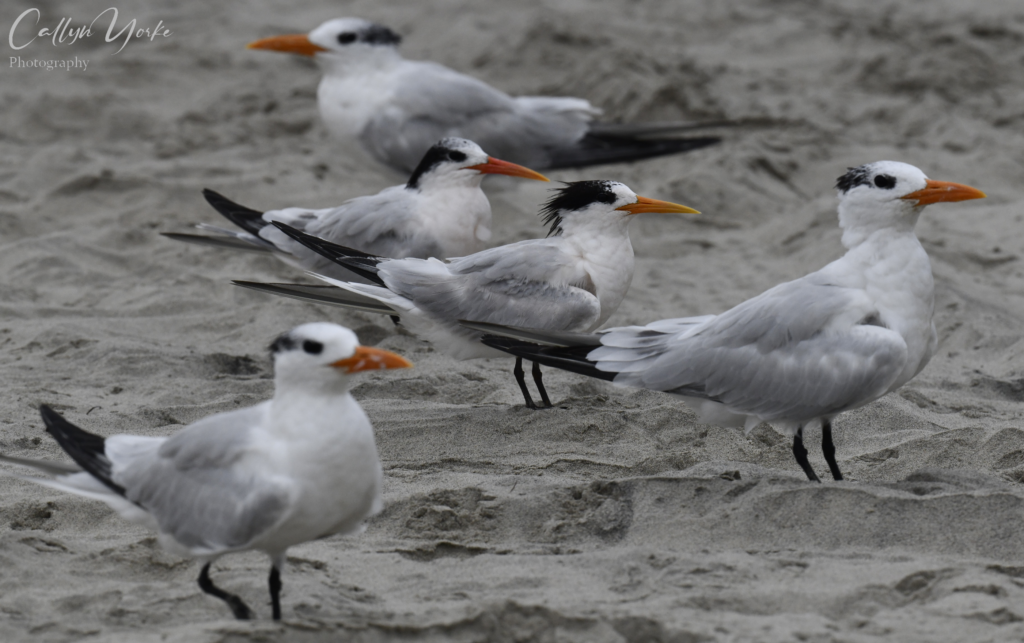
- Brandt’s Cormorant 350 (conserv. est.) (ad, bsc plmg; about 20% imm), standing on tidal rocks and cliff ledges; flying nearshore and offshore in pairs and small flocks; LJC; ubiq.,
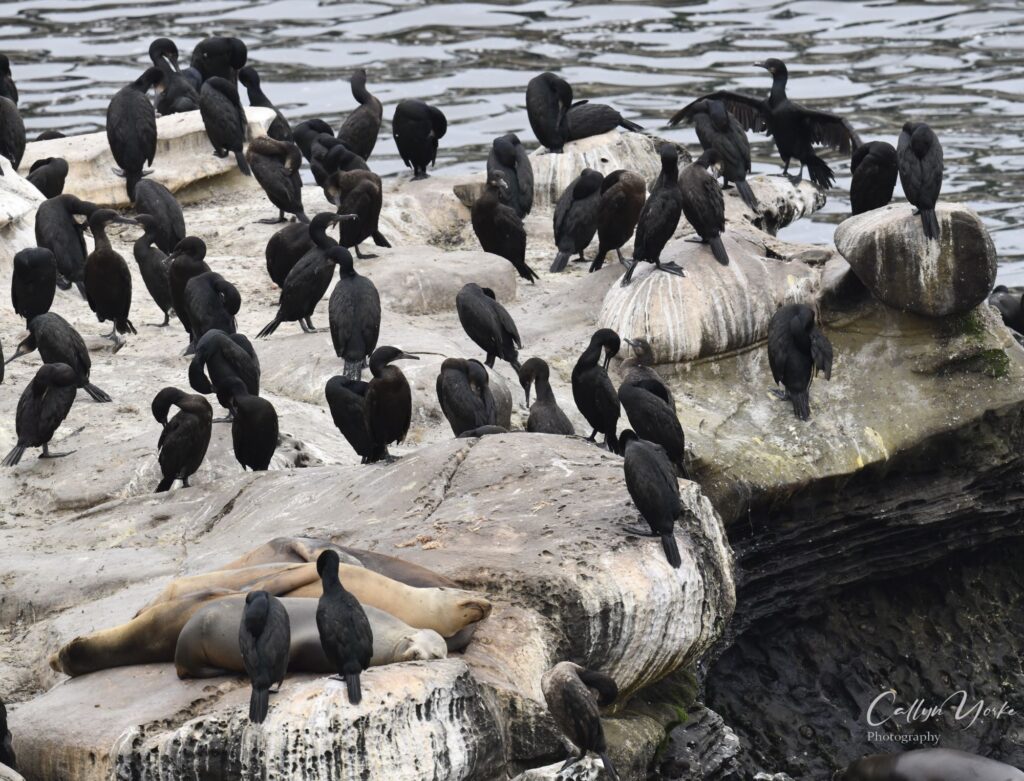
- Pelagic Cormorant 1 swimming nearshore, LJC (see introductory photo).
- Neotropic Cormorant 1? ID: a relatively small, short-legged cormorant with mallards for size-comparison (photo); dark lores and ocular area with narrow white gular border; standing on ground at the edge of the main channel, opposite the visitor center, SWSEL (also see introductory photo).
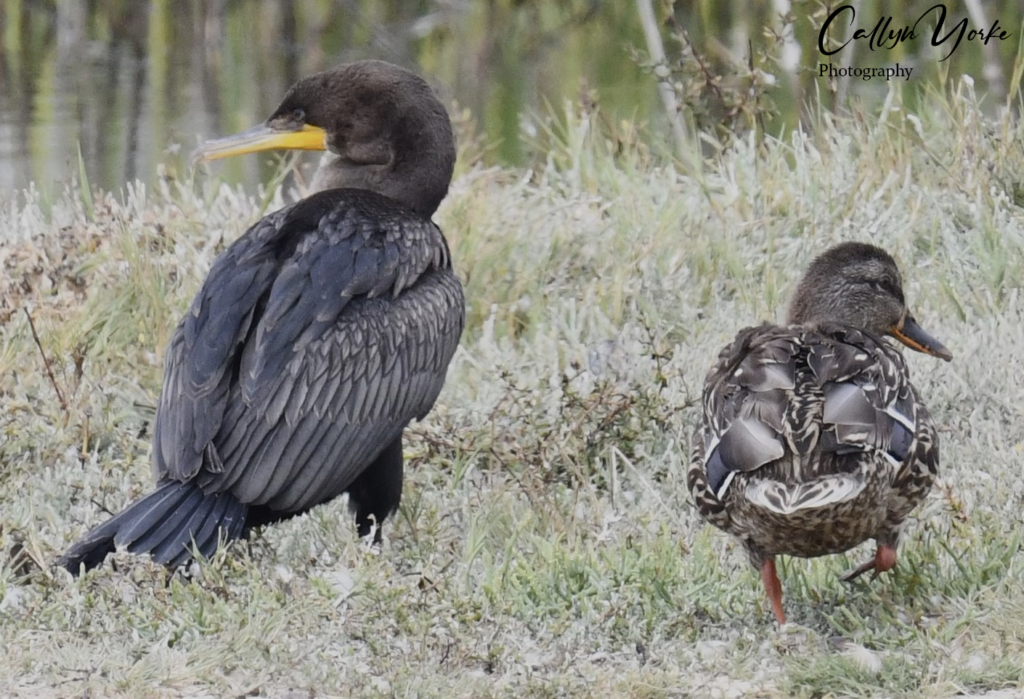
- Double-crested Cormorant 60 (ad, imm) on breakwater and in adjacent harbor waters, OBH; a small flock perched in pines overhanging wooden ‘sea watch’ stairway LJC; in flight nearshore; lagoons, harbors, breakwaters and inland waters throughout, ubiq..
- Brown Pelican 75 (ad, imm) standing on ledges and rocks above the high tide level; on breakwaters and fishing docks; small flocks in flight, skimming breaking surf; diving on offshore schools of fish, sometimes with large pods of dolphins nearby, LJC; ubiq..
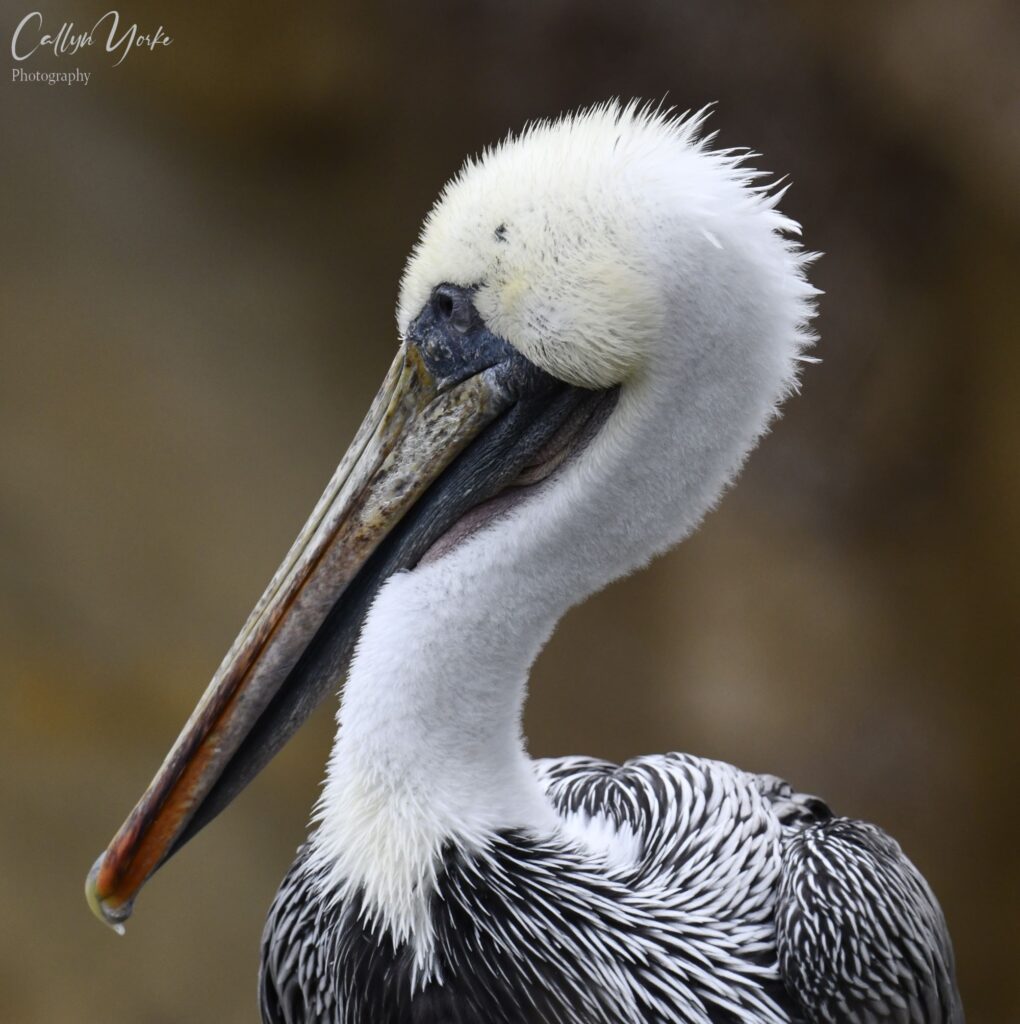
- Great Blue Heron 4 standing on mudflat at edge of channel; in flight over channel, BAL; taking bait fish on dock, OBH (photo); ubiq..
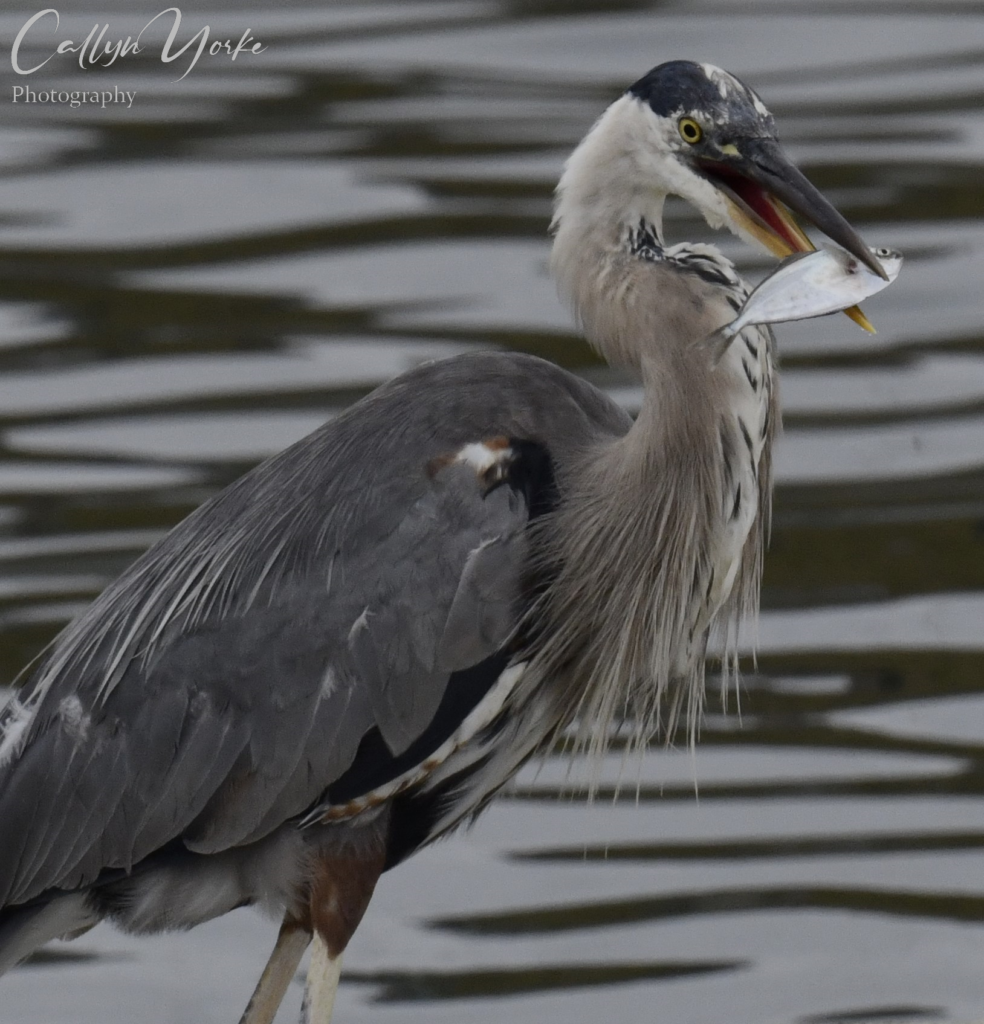
- Great Egret 8 in marsh and on mudflats at east end of the lagoon; in flight over channel, BAL; on bait fish dock with other herons, OBH; ubiq..
- Snowy Egret 7 greg. individuals and pairs on shore, mudflats, in shallows and on fishing docks, OBH; ubiq..
- Green Heron 1 at edge of artificial pond, SDP.
- Black-crowned Night Heron 7 (ad, imm) in marsh on north side of pond, DMP; 1 on bait fish dock, OBH.
- White-faced Ibis 16 greg. in flight low over pond, DMP.
- Turkey Vulture 1 circling at about 75 ft. agl over area, BBG.
- Osprey 2 individuals perched on light pokes about 200 yards apart over SLR estuary, OBH; on snags and in flight at edge of tidal channel, BAL; 1, on snag next to main tidal channel, SWSEL.
- Northern Harrier 1 standing on ground in distant marsh, s, TENWR.
- Cooper’s Hawk 1 (imm) in flight, low at edge of marsh; later seen about 0.5 mi west in Eucalyptus woodland, BAL;
- Red-shouldered Hawk 2 (ad, imm) vocal, loosely greg. semi-habituated to human presence; individuals, possibly pars calling and flying around tall trees in riparian patches; on utility lines over busy roadways, UCC (photo); ubiq..
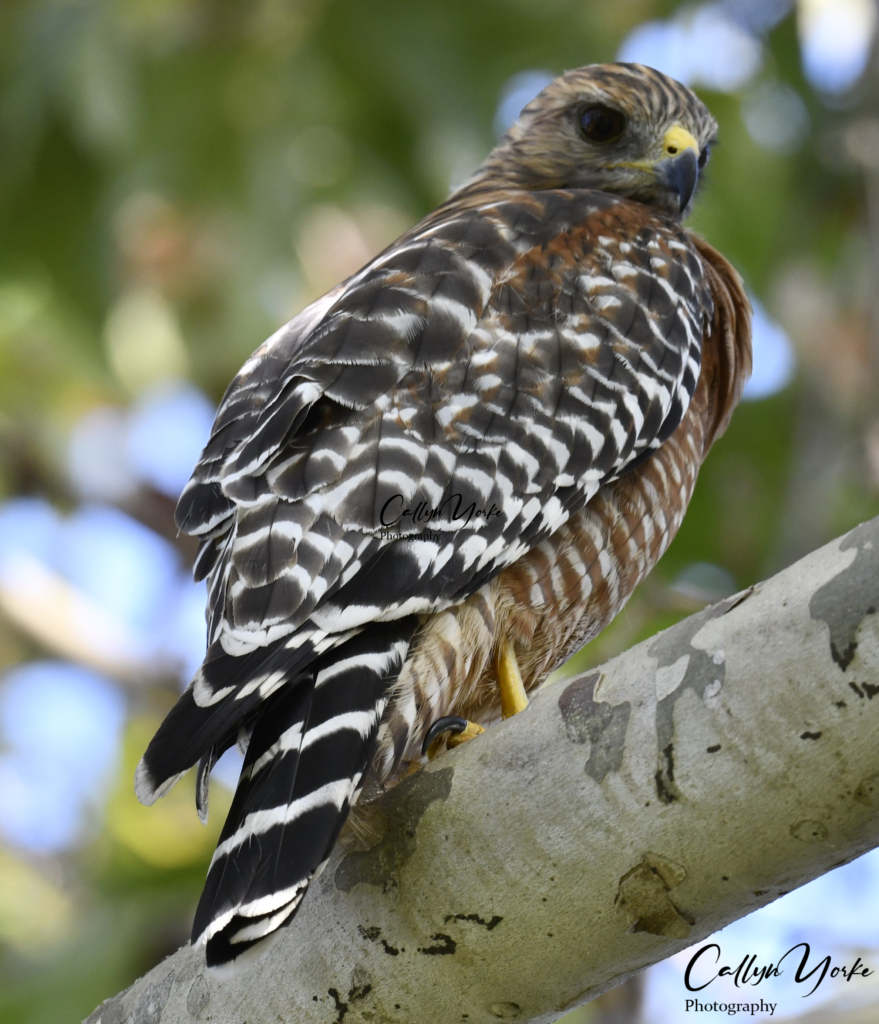
- Red-tailed Hawk 1 soaring on thermals over suburbs with tall Eucalyptus, EN.
- Belted Kingfisher 2 vocal in flight, low at edge of SLR channel under roadway bridge, OBH.
- Downy Woodpecker 1 (m) vocal in canopy of plantain tree, SDP.
- Nuttall’s Woodpecker 3 (m,f) vocal individuals in Eucalyptus woodland, BAL; ubiq.
- American Kestrel 1 sallying from snag to ground in adjacent horse pasture, ne BAL.
- Western Flycatcher 2, vocal (calls), individuals aha at edge, 8-10 ft agl, in mixed coastal sage-willow riparian patch west horse trail, BBG.
- Black Phoebe 5 (ad., imm) vocal, individuals and pairs sallying to ground and marsh from 2-5 ft. agl perches; occasional pairs engaged in chases; often near water and/or moist vegetation, BAL; ubiq.
- Say’s Phoebe 1 sallying to lawns from headstones, FRC.
- Cassin’s Kingbird 14 greg., vocal a (migratory?) flock of about 10 birds in leafless canopy of a tall Eucalyptus, flying to and from the tree; elsewhere individuals or pairs on utility lines and on exposed limbs of a variety of ornamental trees, SDP; ubiq..
- Hutton’s Vireo 3 (ad, imm) greg. occasional calls, a cohesive trio of two adults and one imm. igl quickly in lower levels of young oaks and sycamores, UCC.
- Black-throated Magpie Jay 1, preening at top of salt cedar, BBG; evidently a localized breeding population present here for at least 32 years. For some reason, this species, of uncertain providence, has not yet been placed on the official California State bird list by CBRC (see introductory photo).
- California Scrub Jay 2 vocal, in flight, low over coastal sage scrub, SDP; SBG; CNM.
- American Crow 10 greg., vocal, early morning flight over park and adjacent suburb, SDP; ubiq..
- Common (Northern) Raven 1, in flight over area, UCC; DMP; LJC.
- Bank Swallow 1 ID: comparatively small size, with dark breast band; flying 10-20 ft. agl over mouth of SLR, OBH.
- Northern Rough-winged Swallow 1 flying back and forth over marsh, 5- 10 ft. agl, SWSEL.
- Barn Swallow 10 loosely greg., vocal, flying back and forth over tidal channel and marsh throughout the area, SEL; ubiq..
- Cliff Swallow 60 greg. a large, loosely aggregated flock, circling over marsh, SEL; 5, OCH; 4 BAL.
- Bushtit 18 (m,f; ad, imm) greg., vocal, a cohesive flock foraging in a variety of trailside shrubs, including Tree Tobacco, SWSEL; ubiq..
- Wrentit 12 vocal though seldom visible; individuals and pairs in coastal sage scrub, SDP; ubiq..
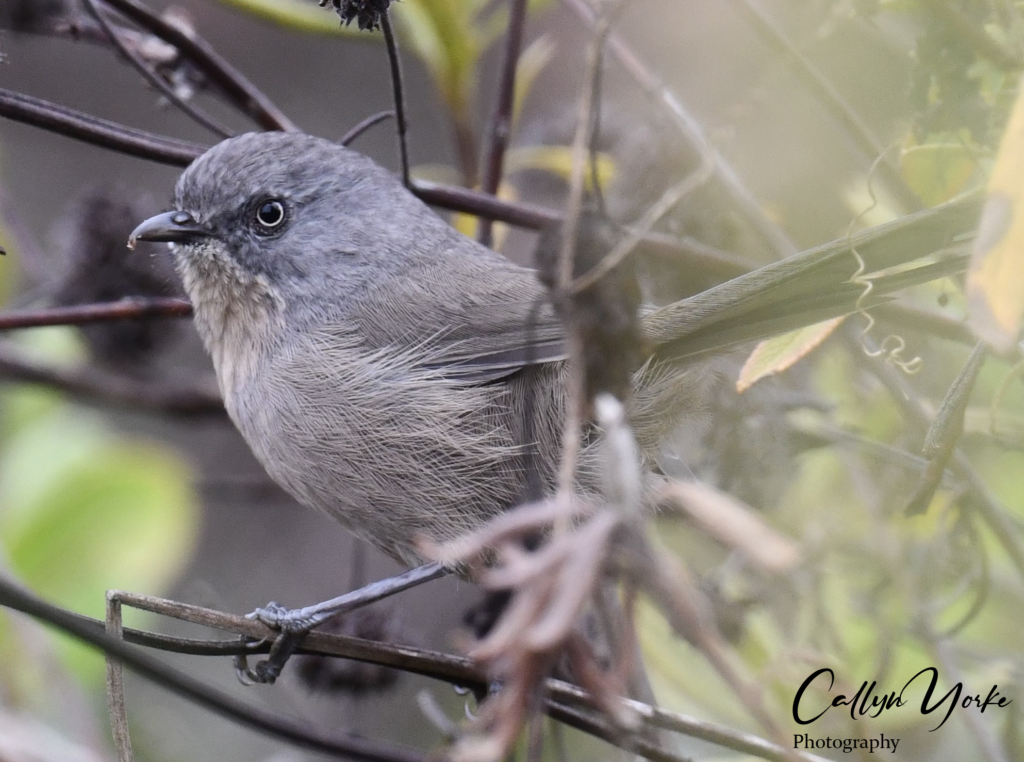
- Swinhoe’s White-eye 15 vocal, greg. igl, frg, in ornamental shrub and flowering tree canopies, SDBG; ubiq..
- California Gnatcatcher 3 vocal, greg., active igl. in coastal sage scrub, 1 -5 ft. agl., UCC; SCP (see introductory photo).
- House Wren 2 igl 1 – 5 ft. agl in salt cedars, BBG; ubiq..
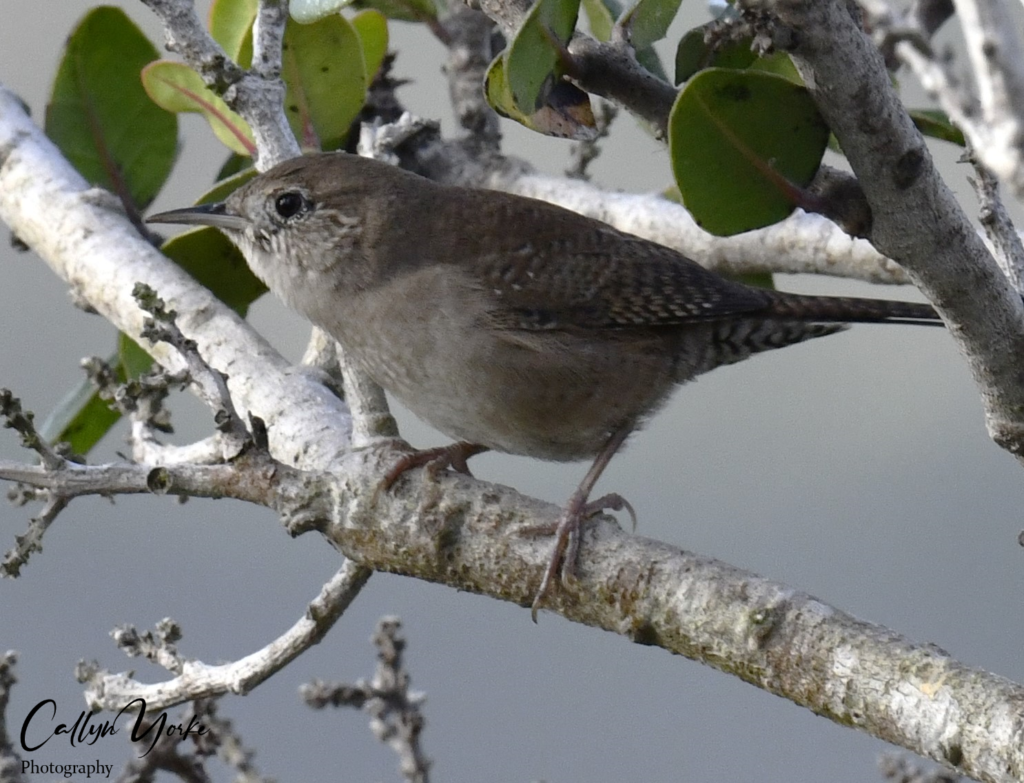
- Bewick’s Wren 2 vocal, greg. 1 – 15 ft. agl, in coastal sage scrub, ascending into middle levels of Eucalyptus, SDP; ubiq..
- European Starling 12 greg. a pair on a utility wire and flying over adjacent alfalfa field, HSR; 2 on utility line, UCC.
- California Thrasher 1 running across trail in native plant section, SDP; flying low over oak woodland-chaparral ravine below the lighthouse, CNM.
- Northern Mockingbird 1 on roadside wall, FRC; 1 on snag at edge of adjacent pasture, BAL.
- Western Bluebird 5 (m,f) greg. on utility line over roadway; a pair sallying to lawns from low sycamore limbs, UCC, SDP.
- Scaly-breasted Munia 16 vocal, greg. taking seeds and flower parts of grasses and herbs in riparian-coastal sage ravine, UCC; ubiq..
- House Sparrow 2 (m,f) on roadside with a garden patch, EN; LJC.
- House Finch 20 (m,f; ad, imm.) vocal, greg. in Eucalyptus and a variety of ornamental shrubs and trees in suburbs and natural areas, SDP; ubiq..
- Lesser Goldfinch 15 (m,f) vocal, greg. in coastal sage, willow-cottonwood riparian patches, SEL; ubiq..
- Chipping Sparrow 1 bsc. plmg. alighted on ground below observation tower in coastal sage scrub, then continued to fly westward, SDBG.
- Dark-eyed (Oregon) Junco 4 (m,f) greg. pairs on ground beneath ornamental trees, RNC.
- Belding’s Savannah Sparrow 20 loosely greg. on ground and in low marsh vegetation throughout the tidal channel area along the McCoy Trail, TENWR; 2 in marsh at edge of tidal channel, BAL.
- Song Sparrow 12 greg. vocal, pairs at edges of coastal sage and trails; lawns, picnic areas, SDP; ubiq..
- California Towhee 12 greg., vocal, pairs on trails, roadsides, in clearings, gardens, Eucalyptus woodland, SDP; ubiq..
- Spotted Towhee 6 in dense coastal sage scrub, riparian and adjacent Eucalyptus woodland, SDP; ubiq..
- Hooded Oriole 1 (f) on utility wire, UCC; ornamental flowering trees, EN.
- Red-winged Blackbird 12 (m,f) greg. in flight over pond, DMP.
- Great-tailed Grackle 18 (m,f) greg. on sidewalks and in ruderal patches of the harbor roadside, OBH.
- Orange-crowned Warbler 4 vocal, greg. igl in a variety of native and ornamental shrubs and trees, 2 – 50 ft. agl, UCC; ubiq..
- Wilson’s Warbler 1 (m) in and around a dripping faucet and saucer bird bath beneath a salt cedar, BBG.
- Common Yellowthroat 12 (m,f) greg., vocal (mainly contact calls), individuals, pairs and trios active in coastal sage and adjacent willow-riparian-Eucalyptus woodland, BAL; ubiq..
- Western Tanager 1 (m, imm) in Eucalyptus canopy in upper park section, SDP.
- Summer Tanager 1 (m) moving through plantain tree canopies adjacent to lower entrance, SDP (see introductory photo).
- Lazuli Bunting 1 (f) on utility wire, HSR.
_______________________________________________________________
28 November – 15 December 2020 SUMMARY (125 Species)
Weather: Fair to partly cloudy, 48F to 66F; wind predominately E, NE, ESE 2-15 mph; seas variable, depending on wind, surf 2 -5 ft.; high tide, 0600-0800 hrs.
Time: 0630 – 1730 hrs.
Areas Covered 1) Encinitas: Eight morning transects (0630-0930), one afternoon transect (1340-1640 hrs.) beginning and ending at Moonlight Beach (MB), including adjacent Encinitas suburbs (ES), lower and upper Cottonwood Creek Ecological Preserve (LCC, UCC). Multiple casual surveys through Encinitas commercial and suburban districts. COVID-19 pandemic advisories posted everywhere. Face coverings worn by the majority of pedestrians; most small businesses remained open during my visit, including hotels; most restaurants were open for outside dining and take-out. Large weekend/holiday crowds in town and on beaches.
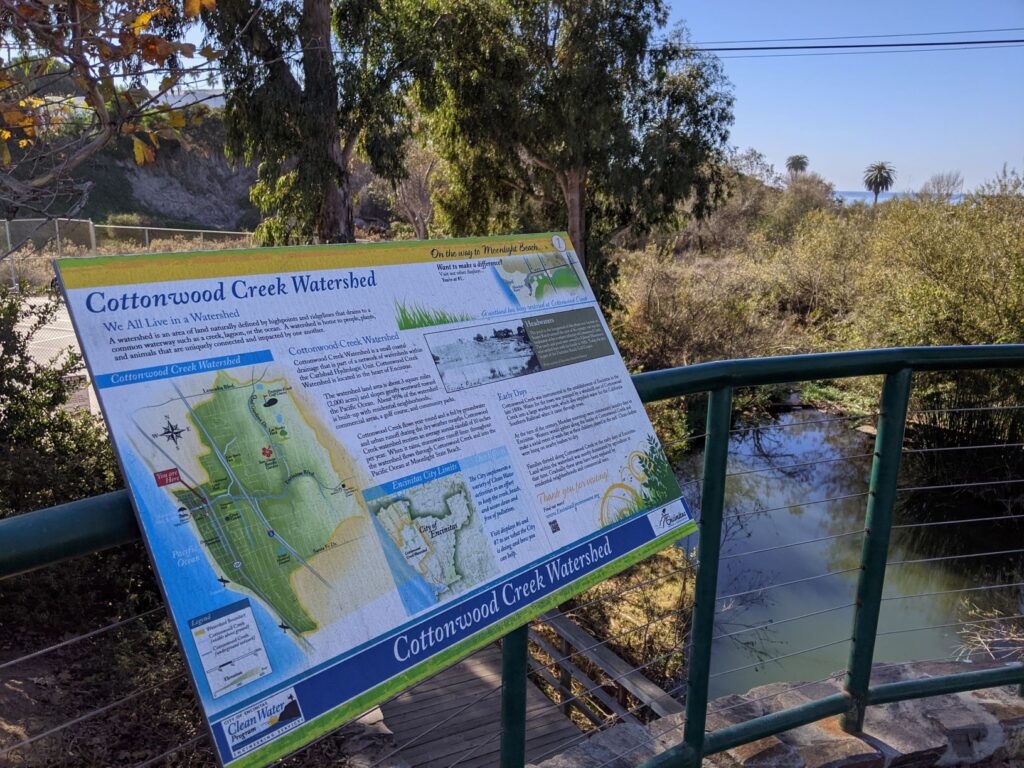
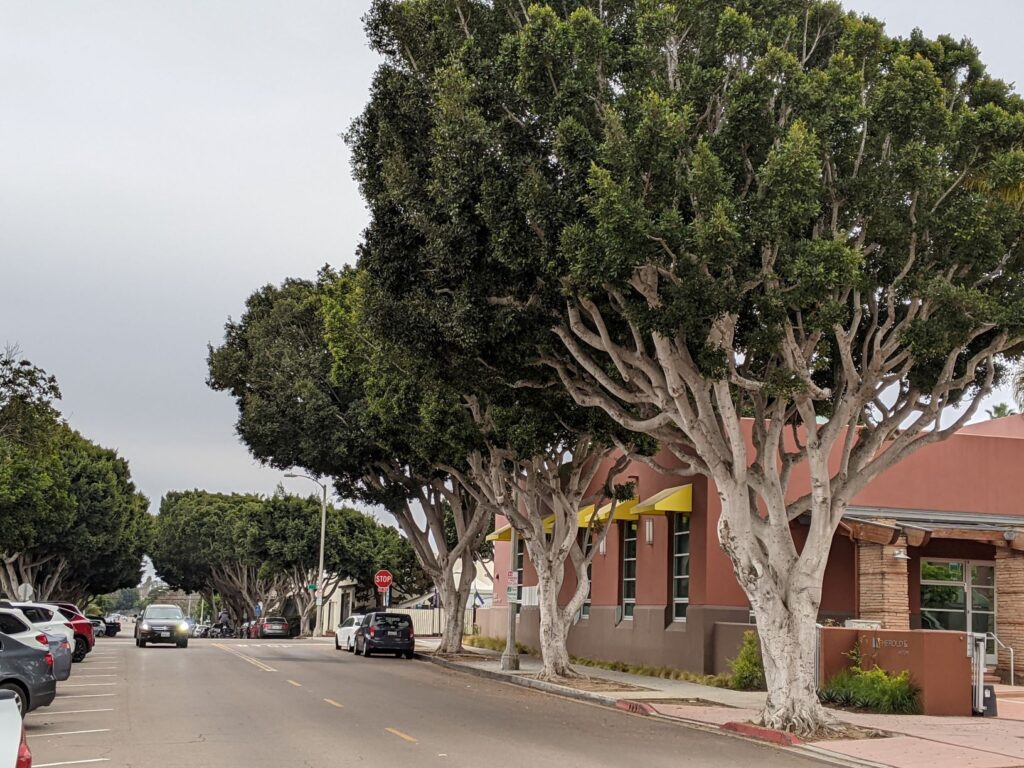
2) San Elijo Lagoon (SEL – 30 November, 0706-1010 hrs): Including Rios Avenue, Peninsula and Pole Trails, railroad underpass and south ponds, the Visitor Center and adjacent trails. 3) Poggi Canyon, Chula Vista (PC – 4 December, 0833-1042 hrs.), including Rancho Drive suburbs and Otay Valley Regional Park.
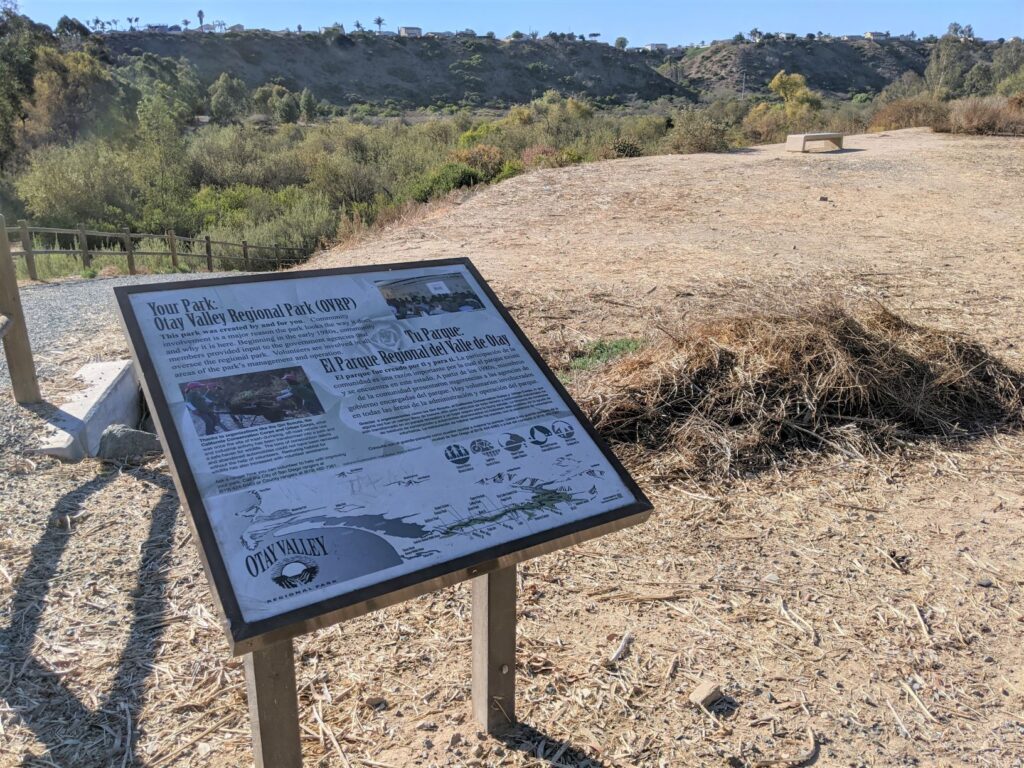
4) Tijuana River Valley (TRV – 4 & 9 December, 1111-1310 hrs.) Tijuana River Estuary National Reserve (TRE), North and South McCoy Trail; levee overlooking the adjacent Imperial Beach IB.
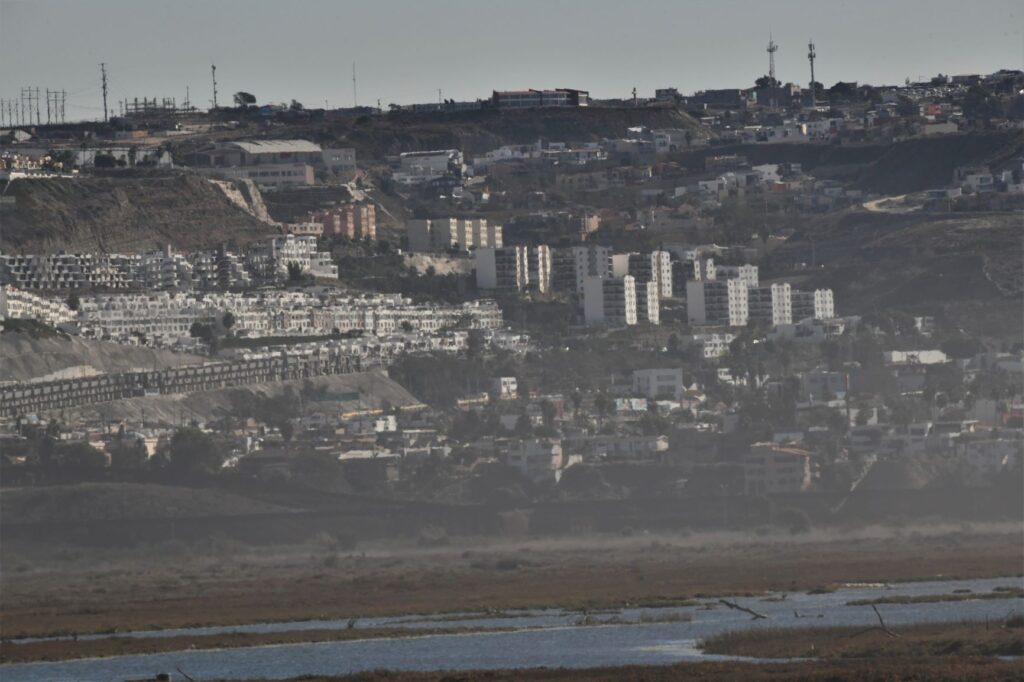
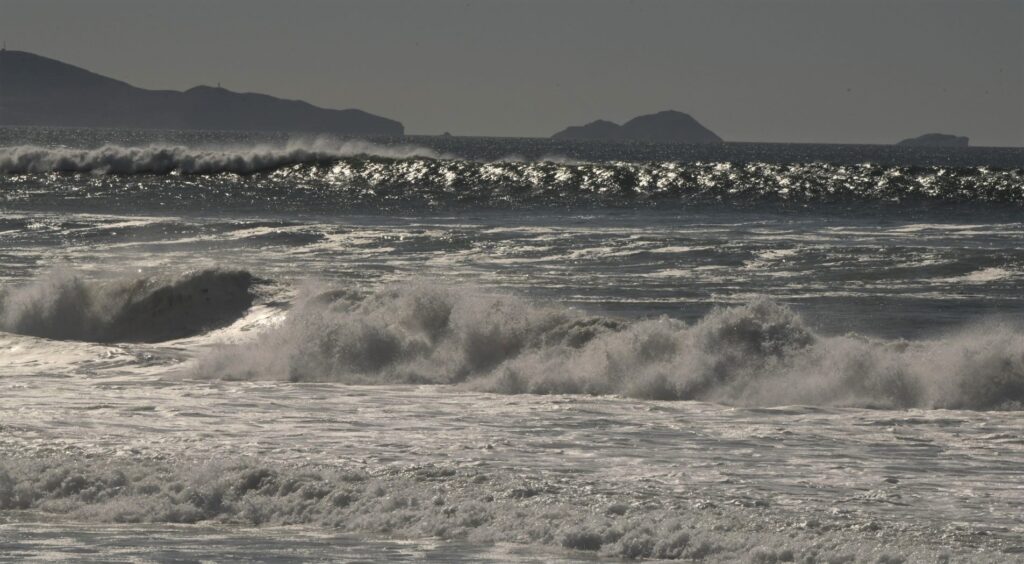
5) Leucadia suburbs adjacent to I-5 and Leucadia Blvd (LB – 6 December, 0845-1009 hrs. 6) Fiesta Island (FI – 9 December, 0805-0953 hrs), including dog park and adjacent shorelines and lagoons. 7) Coronado Island (CI – 9 December, 1015 -1155 hrs.), shore and breakwater adjacent to Hotel Del Coronado, Vietnam War Naval Memorial park and bay shore. 8) Oceanside Harbor, breakwater, beach and San Luis Rey River mouth (OH – 11 December, 0704-0834 hrs.). 9) Capistrano Park, Oceanside (CPO – 0847 – 1050 hrs.). 10) San Diego Botanical Garden, Encinitas (BG – 13 December, 1000-1150 hrs.). 11) Guajome Regional Park, Oceanside (GP -14 December, 0736-0920 hrs.).
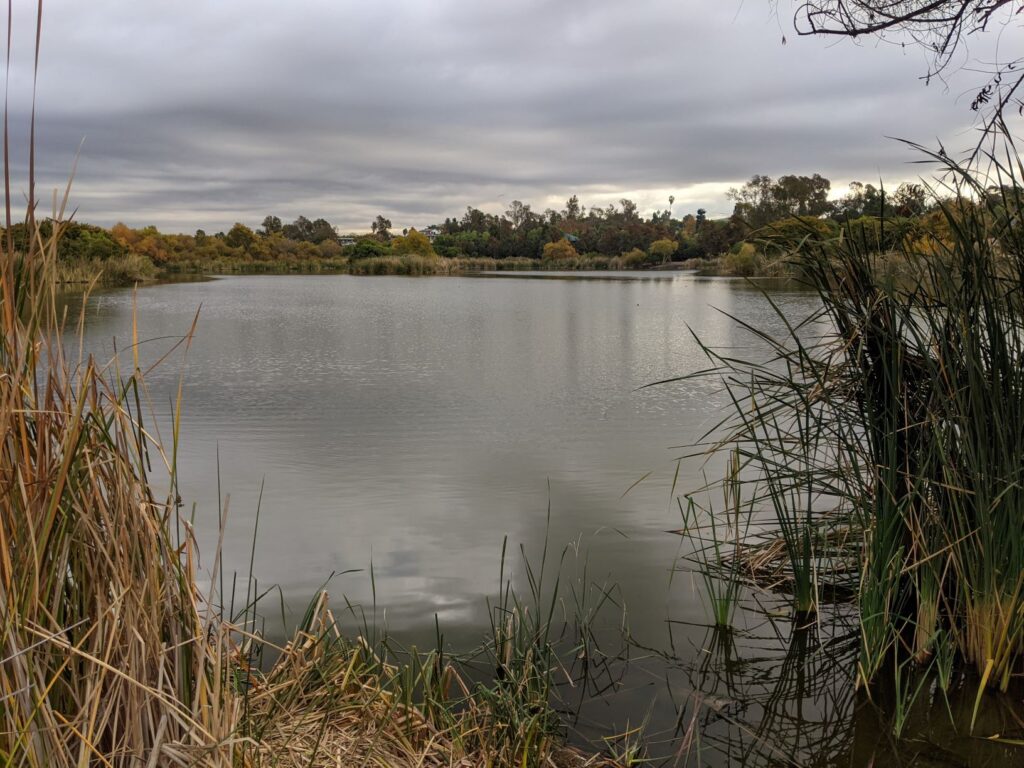
12) Dairy Mart Pond, Tijuana River Valley (DMP – 15 December 0736-1005 hrs.), including the Bird and Butterfly Garden (BBG).
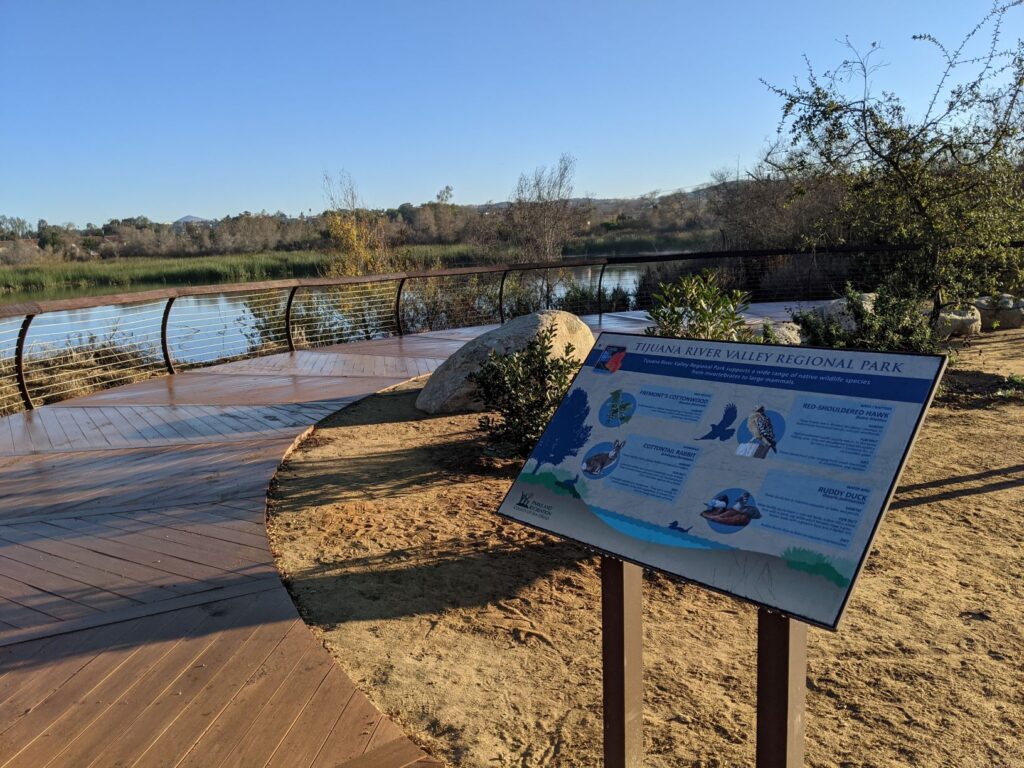
13) San Diego River (SDR – 15 December, 1026 – 1230 hrs.) including the Riverview Golf Course clubhouse parking lot and restored riverine habitat in the vicinity of Riverwalk Drive & Fashion Valley Road.
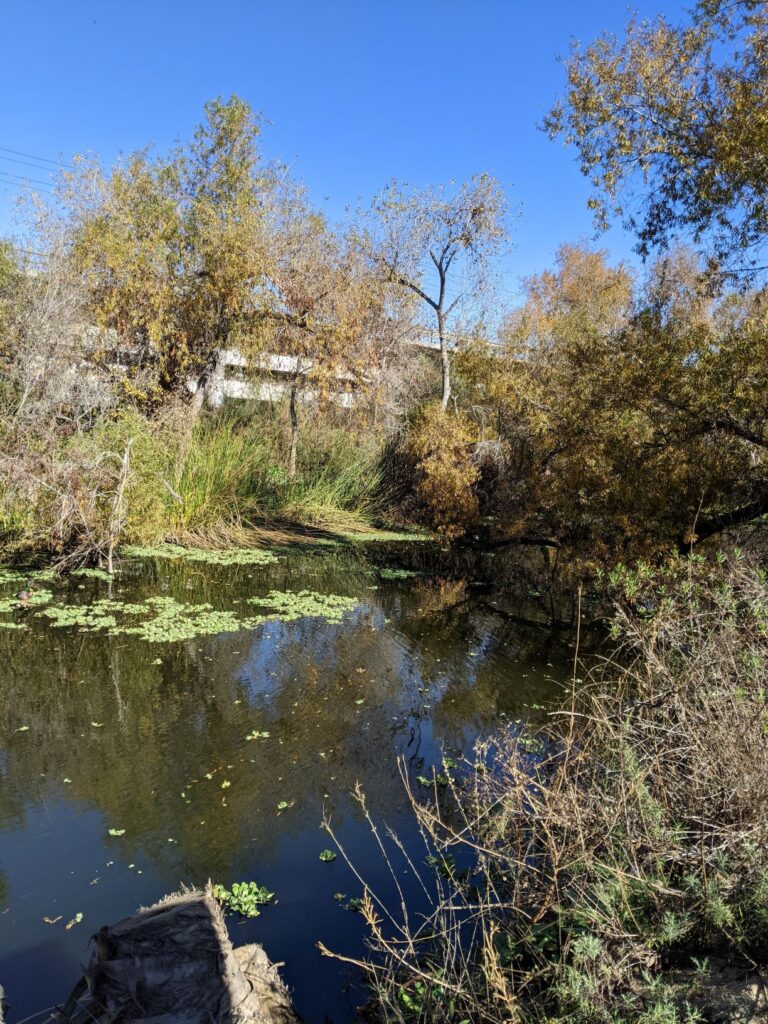
BIRDS NOTED (Common names underlined for reference; Rarities in bold type; Numbers represent the highest count for single and multiple-day surveys😉
Canada Goose 3 gregarious, vocal swimming and flying to shallows in lake, GP; Brant 10 gregarious in lagoon with nearby watersports activities, FI; Domestic Swan Goose 4 (exotic) gregarious, GP; Domestic Gray-lag Goose 2 (exotic) gregarious, on shore with SWGO, GP; Gadwall 3 (1 m, 2 f), gregarious, s SEL; American Wigeon 8 (m,f) gregarious, swimming at edge of channel, s SEL; Mallard 20 (m,f) scattered small flocks throughout, SEL, 20 (m,f) gregarious on shore, GP, 8 (m,f) individuals and pairs in shallows throughout, TRE, 8 (m,f) gregarious in backwaters, SD, 1 (m) flying low over river mouth, OH; Cinnamon Teal 3 (1 m, 2 f) gregarious, swimming at edge of marsh, GP; Northern Shoveler 40 (m,f) gregarious throughout the lake, GP; Green-winged Teal 6 (m,f) gregarious in channel, s SEL; Redhead 30 (m,f) gregarious, diving in lagoon with GRSC, LESC, FI (photo);
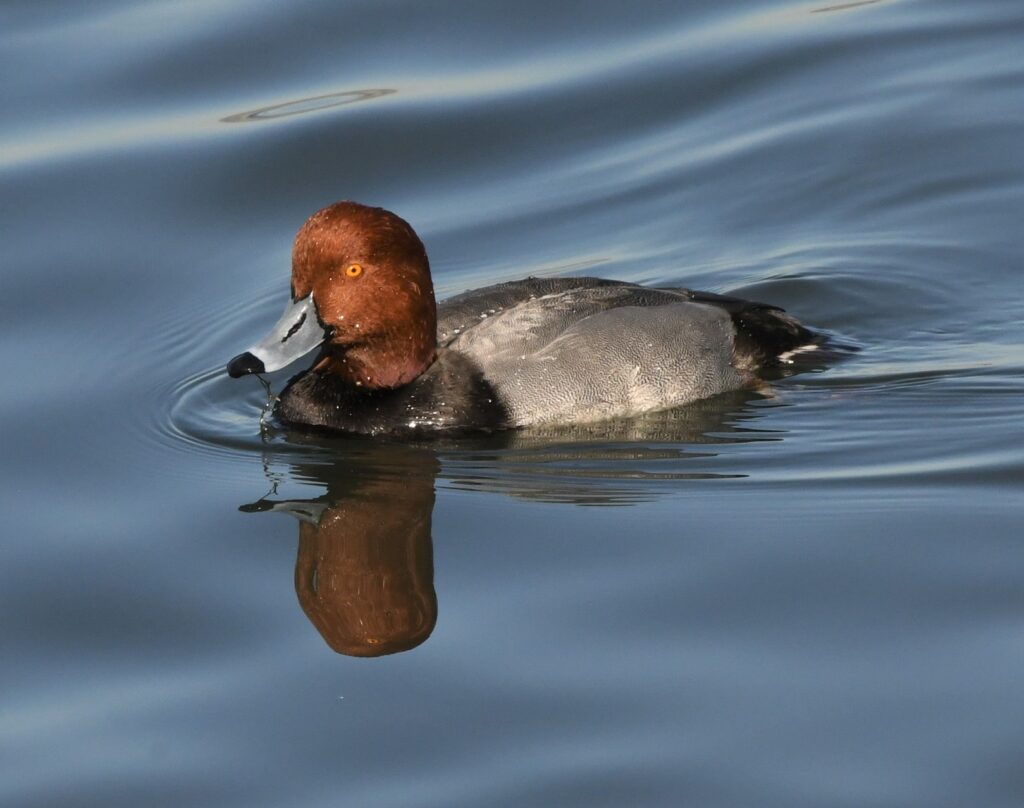
Greater Scaup 4 (m,f) gregarious, diving in main estuary channel, IB, 3 (m,f) gregarious, diving in lagoon, FI (photo);
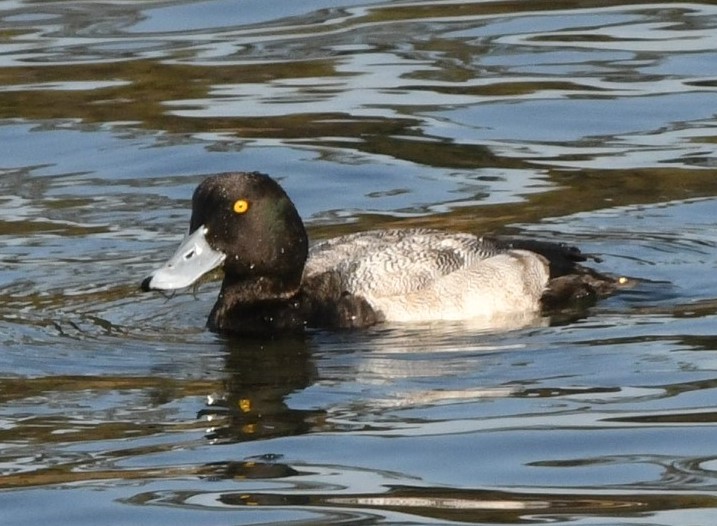
Lesser Scaup 12 (m,f) gregarious, diving in main estuary channel with GRSC, IB, 5 (m,f) gregarious, diving in lagoon with GRSC, FI; Surf Scoter 10 (m,f) gregarious – a cohesive flock flying low offshore, MB; Bufflehead 8 (m,f) gregarious diving in lagoon, FI; Ruddy Duck 2 (m,f) in main lake, GP, 4 (m,f) gregarious, DMP; Pied-billed Grebe 1 swimming in marsh channel, s SEL, 6 individuals diving in open water and near shore throughout, GP, 4 individuals diving near shore, DMP; Eared Grebe 2 diving in channel, TRE, 2 diving in lagoon, FI, 2 diving in harbor, OH; Western Grebe 12 gregarious about 200 yards offshore, MB, 4 in outer harbor, OH; Feral Rock Pigeon 25 (exotic – naturalized) MB, locally abundant in suburbs and towns; Band-tailed Pigeon 2 a pair in fast, direct flight over UCC (28 Nov.); Eurasian Collared Dove 12 (exotic) gregarious on utility lines, LB, s SEL, 10 gregarious MB, LCC, UCC, 10 gregarious CPO, 6 gregarious ES, GP; Mourning Dove 2-12 gregarious, in most locations surveyed; Anna’s Hummingbird 1 (m) LCC, 8 ubiquitous in gardens, especially with feeders, ES, 6 perched atop shrubs and outer sub canopies of willows, SEL, s, n, Allen’s Hummingbird 4 (m,f) UCC (photo), 5 ubiquitous in gardens, especially with feeders, ES, 4 (m,f) PC, 4 (m,f) TRE, 1 (m) CPO, 3 (m,f) BG, 1 (m) GP;
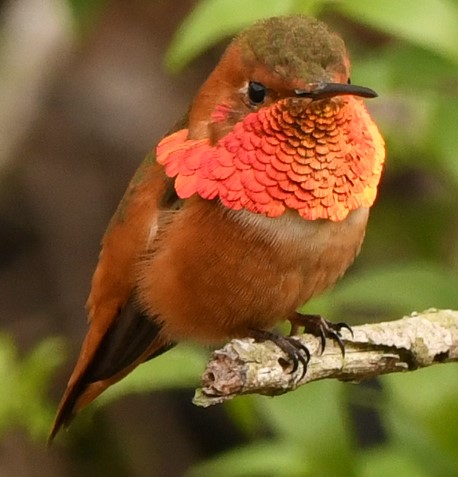
Ridgeway’s Rail 1 vocal (unseen) s SEL; Common Gallinule 2 on shore of main pond, GP (photo);
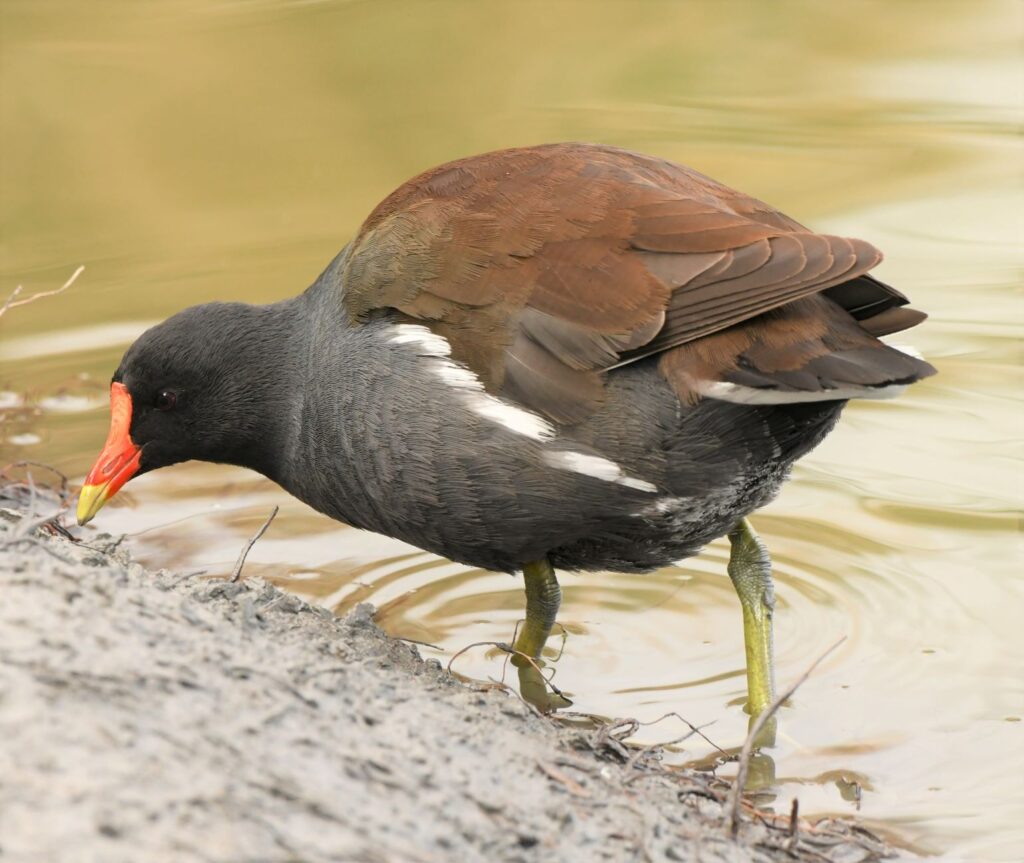
American Coot 1 FI, 40 gregarious, GP, 16 DMP; Black-bellied Plover 12 gregarious on shore of small island, se SEL, 1 on breakwater rocks CI (photo);
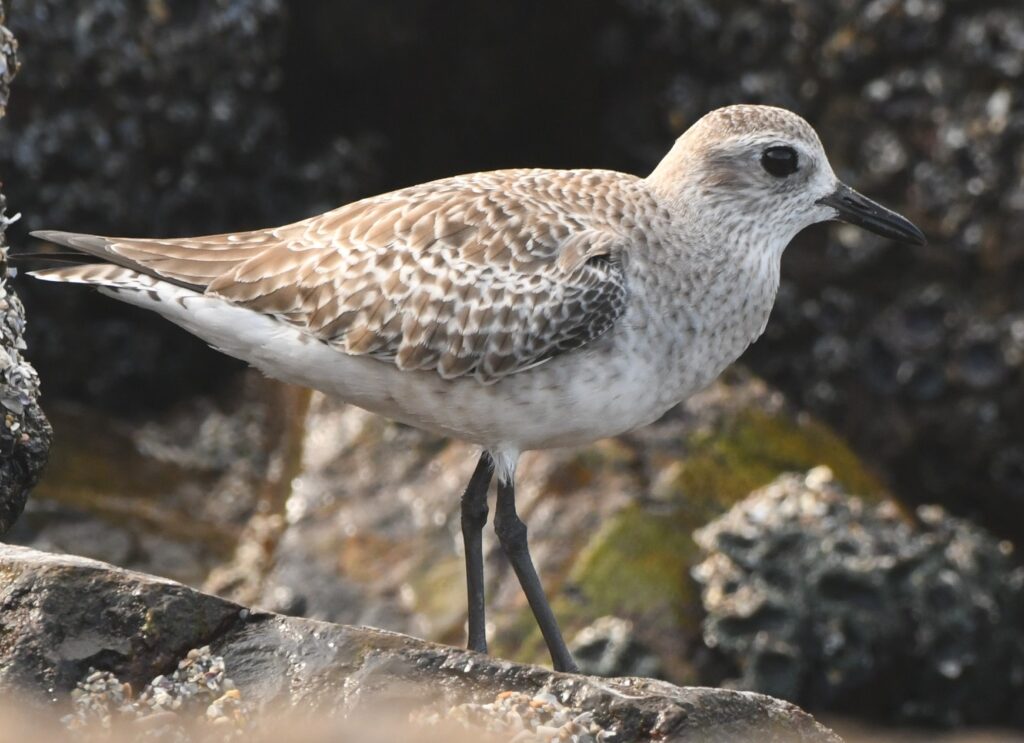
Snowy Plover 3 on outer shore, IB (photo);

Semipalmated Plover 3 on mudflat edge of channel, nw SEL; Killdeer 1 nw SEL, 11 gregarious at edge of marsh, TRE, 2 GP; Whimbrel 1 standing in marsh, TRE; Marbled Godwit 10 gregarious, taking flight briefly and settling down, partially concealed in marsh, nw TRE; Black Turnstone 3 gregarious, foraging on breakwater rock barnacles , IB (photo);

Surfbird 1 standing on breakwater rocks, CI (photo);
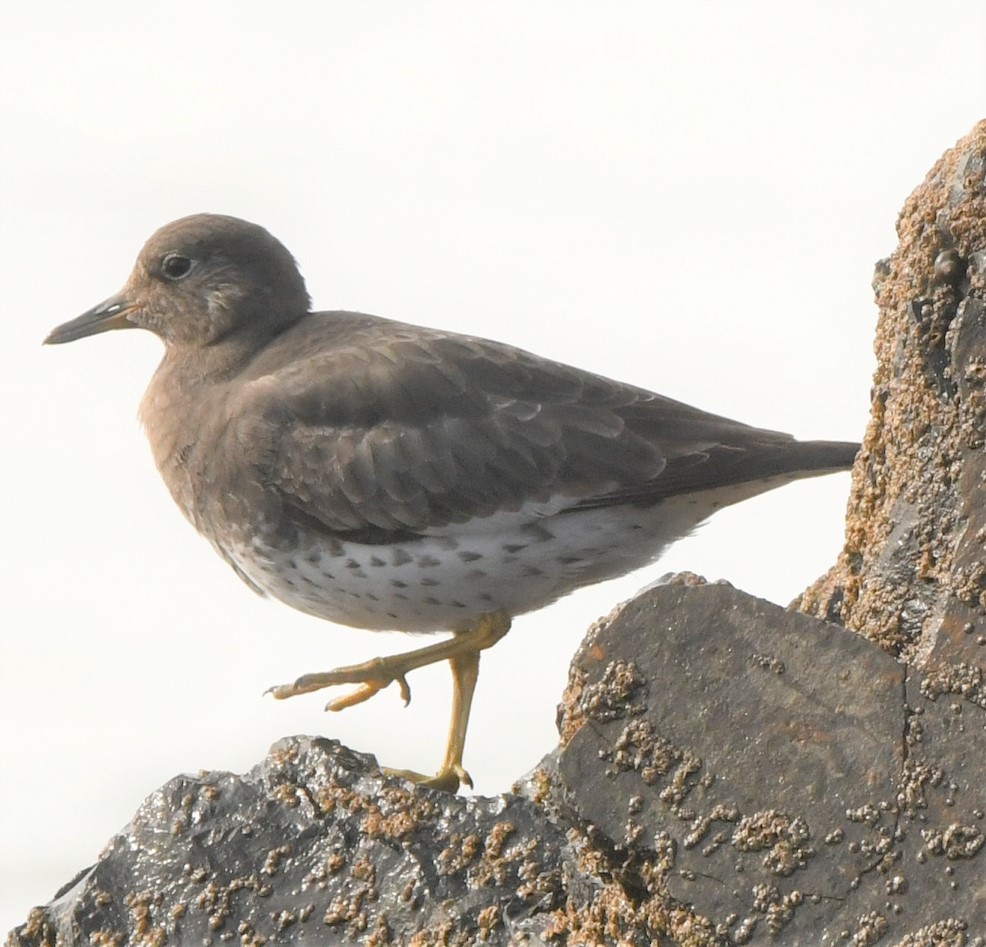
Sanderling 5 gregarious at tide line on outer shore IB; Dunlin 1 on shore of island with BBPL, se SEL; Least Sandpiper 20 gregarious on alkaline mudflats, s McCoy trail, TRE; Western Sandpiper 30 gregarious on shore, FI; Spotted Sandpiper 1 on mudflat edge of channel, nw SEL; Greater Yellowlegs 3 s, n SEL, 1 on shore, FI; Willet 1 on shore nearly every morning, MB, 8 n, s SEL, 2 on shore, OH; Bonaparte’s Gull 20 gregarious direct flight nw about 100 ft. above the surface, 200 yards offshore, MB; Heermann’s Gull 4 (3 ad, 1 juv.) gregarious, MB, 5 (4 ad, 1 C1) gregarious on beach, OH; Ring-billed Gull 12 (90% ad.) gregarious, MB, 1 flying, n SEL, 20 resting on shore in river mouth and adjacent beach, OH, 11 gregarious in main pond, GP, 2 (ad) DMP; Western Gull 30 (90% ad. with C1, C2, C3 in decreasing order of abundance), vocal, gregarious MB, ubiquitous elsewhere near and on the ocean shore, including 4 adults at DMP; California Gull 6 (ad, C1) gregarious on and offshore, MB, ubiquitous elsewhere in fresh and saltwater habitats; Lesser Black-backed Gull 1 (ad) apparently a returning winter visitor on Del Coronado Hotel beach near the breakwater rocks, (photo);
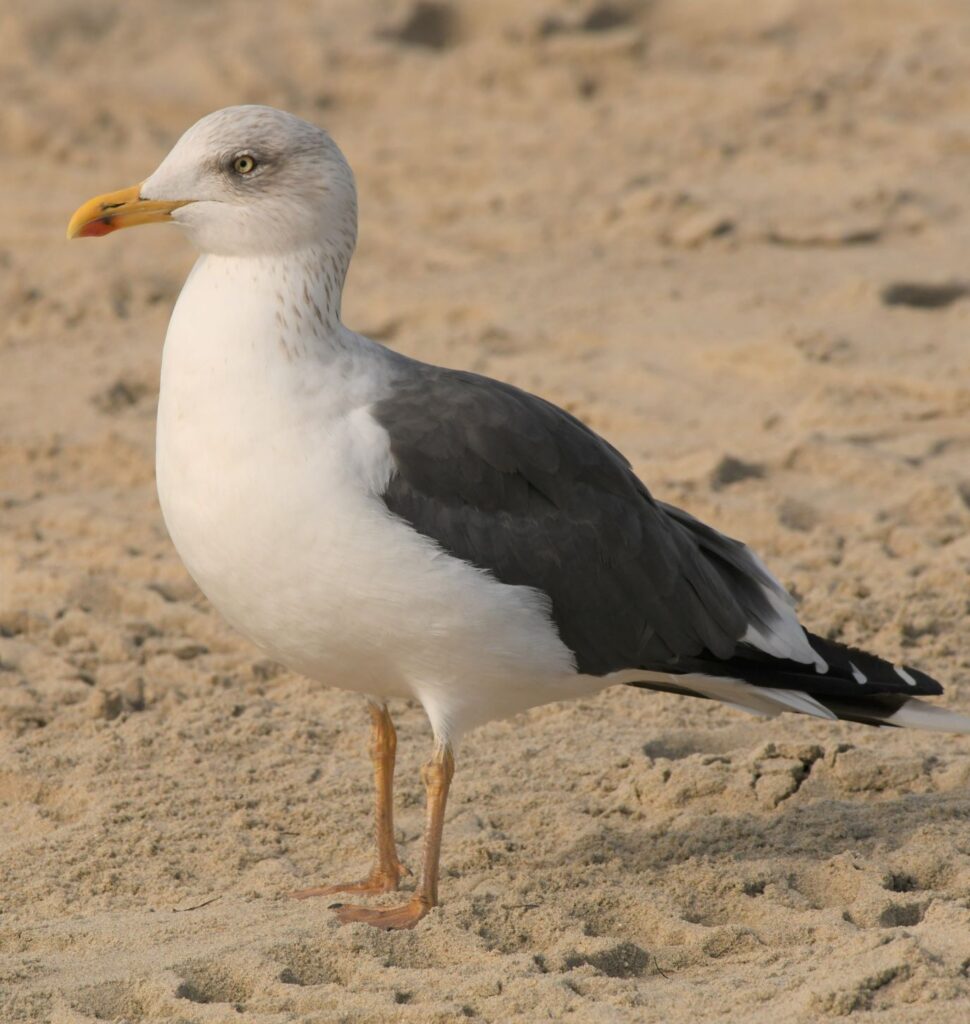
Forster’s Tern 1 flying nw offshore, MB; Royal Tern 5 gregarious, flying nw offshore , 1 sw SEL, 20 gregarious on shore between breakwaters, OH, 20 gregarious on shore CI (photo);
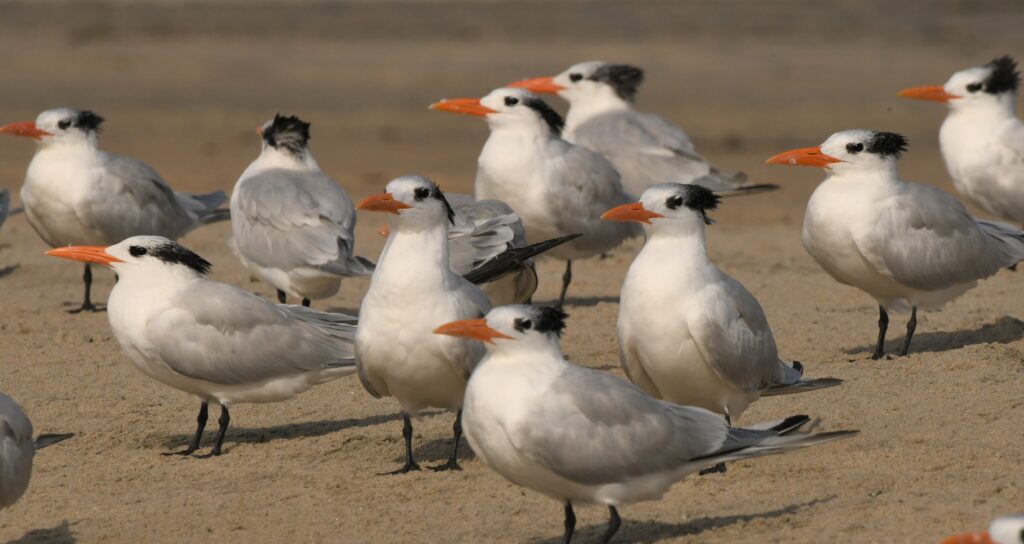
Caspian Tern 3 gregarious on pond island shore, se SEL; Red-throated Loon 1 flying low offshore, MB; Pacific Loon 4 flying low offshore, MB; Common Loon 2 flying low offshore, MB; Brandt’s Cormorant 20 gregarious flying low offshore, MB; Double-crested Cormorant 12 gregarious and individuals flying low offshore, MB; American White Pelican 2 gregarious on main lake, GP; Brown Pelican 20 gregarious flying offshore and over surf, MB, 3 flying low over surf, IB; Great Blue Heron 2 s, n SEL; Great Egret 5 s, n SEL, 1 FI, 1 TRE, 1 on dock OH; Snowy Egret 24 gregarious and individuals, s, n SEL; Little Blue Heron 1 – apparently a continuing winter visitor, standing in shallows of main channel, w SEL (photo);
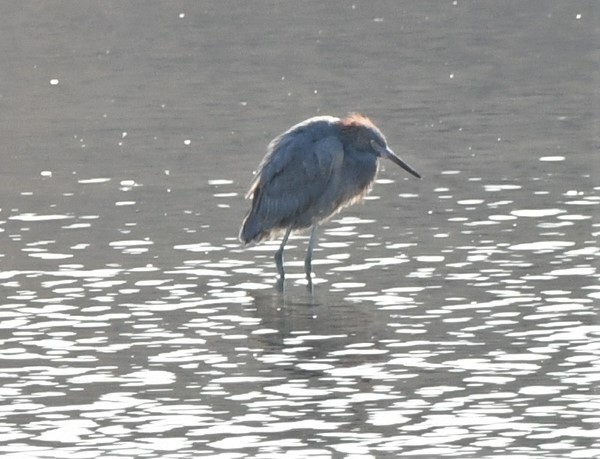
Green Heron 1 adult, at edge of small patch of marsh-pond, LCC (photo);
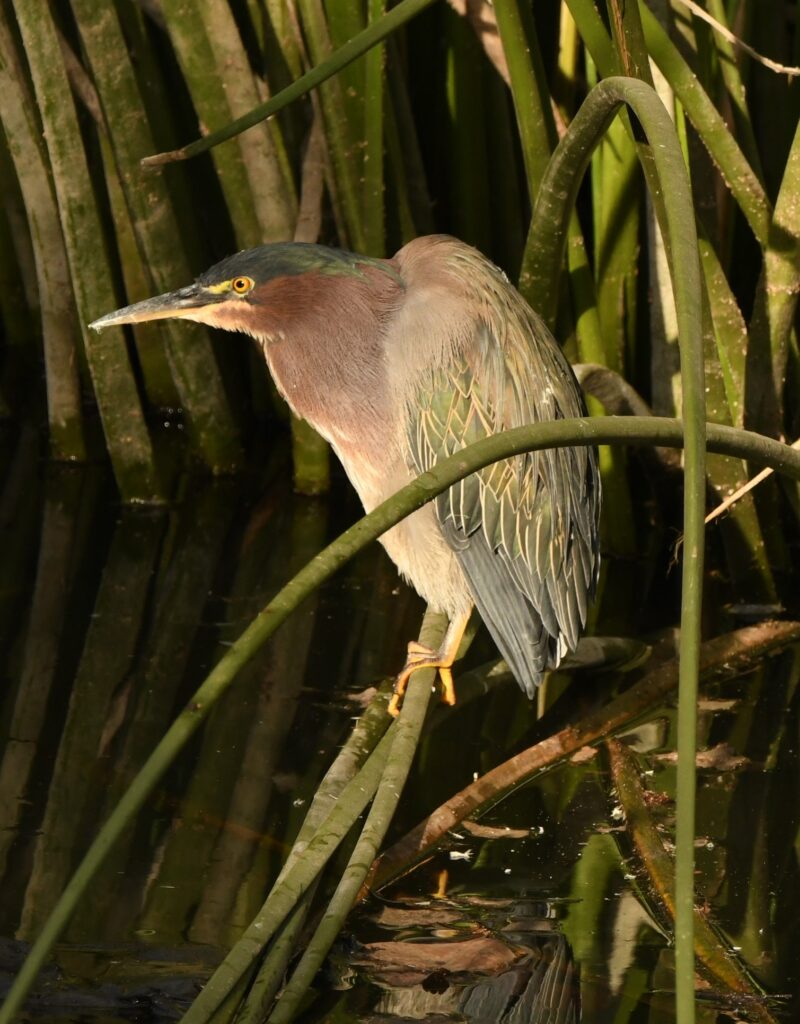
Black-crowned Night Heron 3 (ad, imm) edge of marsh, main pond, GP, 2 DMP; Yellow-crowned Night-Heron 1 adult – apparently a member of a small resident colony in the area, roosting in pines behind apartment buildings, n TRE (photo);

Osprey 1 flying over marsh and perched in tree next to channel, n SEL (photo), 1 (ad) in tree at edge of pond, DMP;
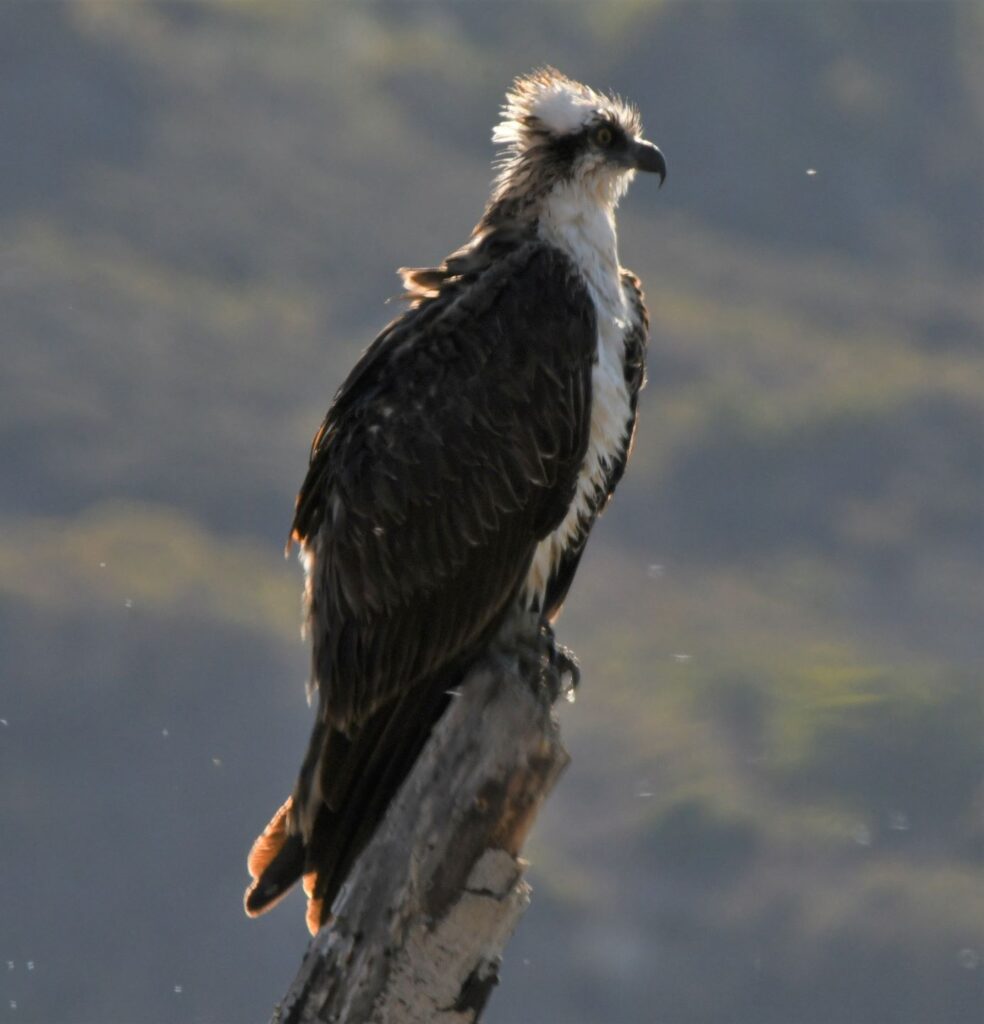
Turkey Vulture 1 flying over Coronado Blvd., IB; White-tailed Kite 1 flying over riparian patch, PC; Northern Harrier 2 (f) flying low over marsh and wet fields, TRE, 1 (m) flying low over open field, DMP; Cooper’s Hawk 1 flushed from tall trees, BG, 1 (ad) GP, 1 (ad) in large tree at edge of ruderal field, BBG, 1 in tree adjacent to DMP; Red-shouldered Hawk 1 (ad) fly, perched in dense riparian cover, UCC (photo), 1 perched in tall tree over riparian drainage, PC;
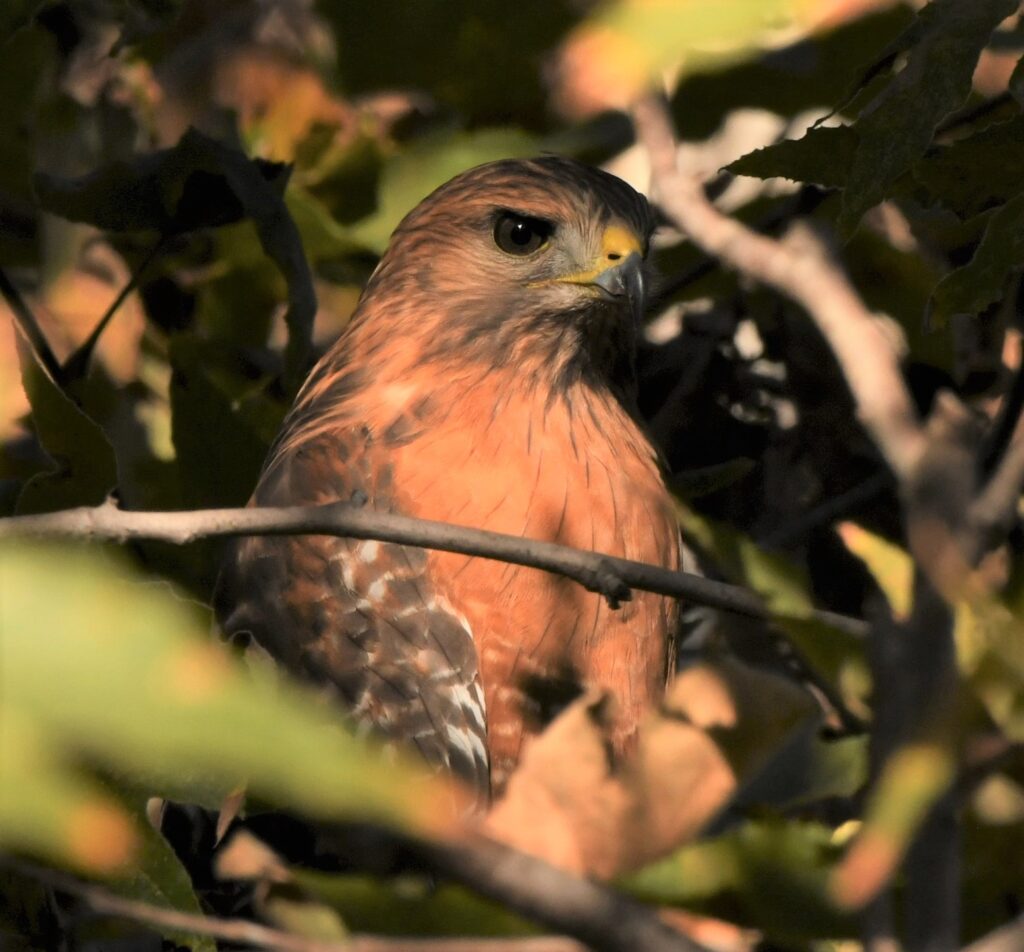
Red-tailed Hawk 1 in tall eucalyptus, UCC, 2 vocal in flight, s SEL, 1 perched next to I-5, LS; Belted Kingfisher 1 vocal, perched on post near channel, n SEL; Nuttall’s Woodpecker 2 (m,f) foraging in riparian patch, UCC, 4 (m,f) vocal, in riparian drainage, PC, 2 CPO, 3 BG, 5 (m,f), vocal, GP, 2 DMP; Downy Woodpecker 1 vocal (unseen) riparian patch, n SEL, 1 vocal LCC; Northern (RS) Flicker 1 vocal (unseen) UCC; Sapsucker (Sphyrapicus sp.?) seen briefly flying to pepper tree, CPO; American Kestrel 1 (m) on utility wire and then adjacent shrub, se TRE, 1 (f) flying to low perch in dog park, FI (photo);
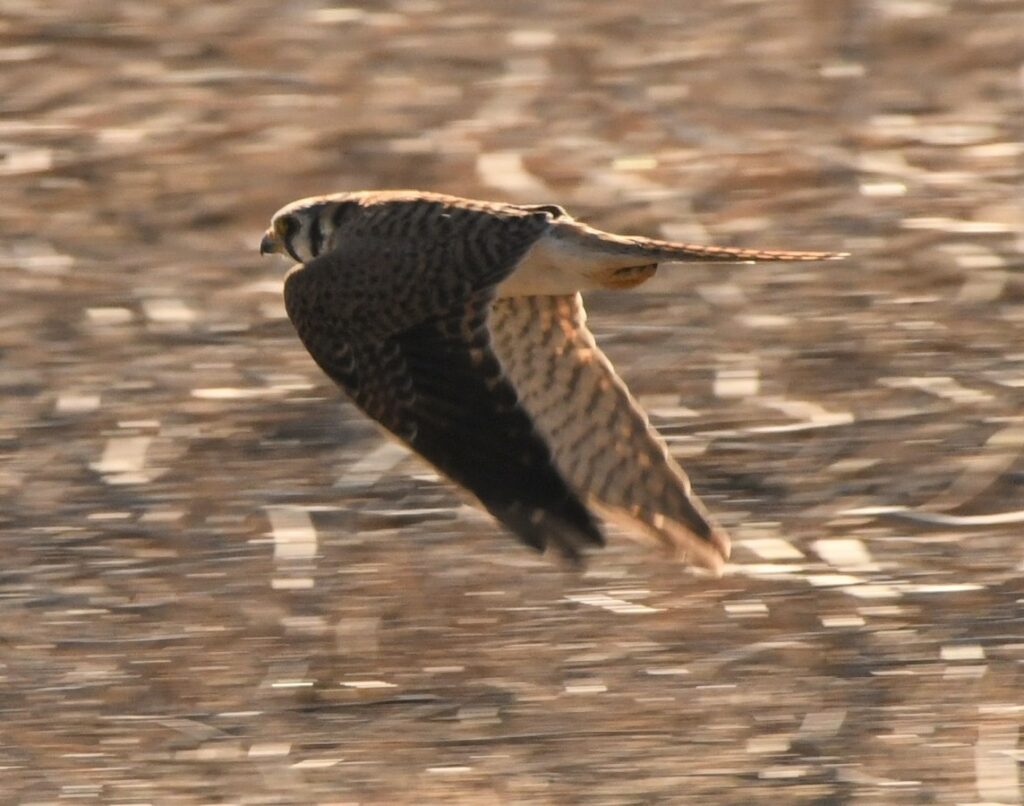
Sulphur-crested Cockatoo 1 (exotic) vocal (continuing – illegally released into the park by owner of adjacent residence) vocal, often pursued by AMCR, UCC (photo);
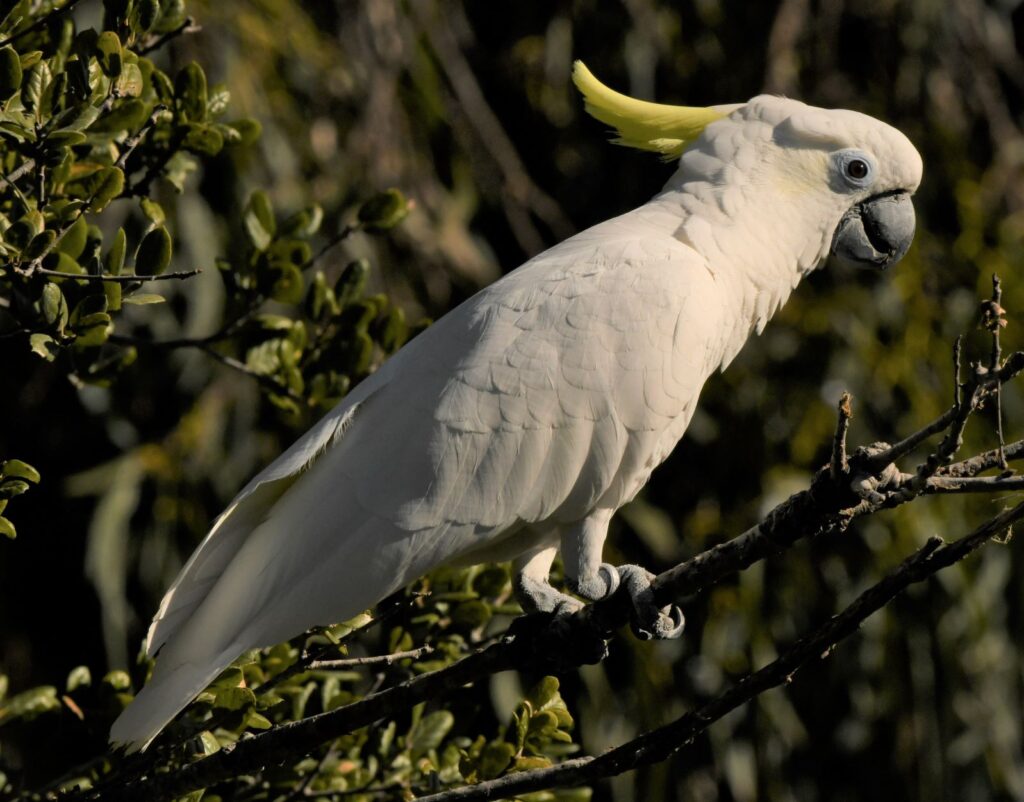
Black Phoebe 2 along weedy drainage, UCC, MB, 3 stream and riparian-lawn edge, UCC, 5 sallying from low perches adjacent to shallow water and shore of channels, SEL, 3 riparian edge and ruderal strips in suburbs, PC, 1 sallying from glass fence in hotel garden, CI, 1 at edge of playing field, sallying to ground, CPO, 1 in riparian patch at edge of main pond, GP, 2 sallying from low perch at edge of pond and trail, DMP, 1 in garden at entrance, BBG, 1 BG; Say’s Phoebe 1 at trailside near a small pond, sw SEL, 1 on shrub at edge of lawn, UCC, 1 on low perch at beach, CI, 3 trail side perches and open fields, TRE, 1 on fence at edge of playing field, CPO, 1 (imm) on post near observation deck, TRE/IB (photo), 2 edge of open fields, GC, 1 in open and brushy fields near entrance, BBG, (Note – SAPH and BLPH frequently found in the same area (sympatric) but usually avoiding each other by selecting different foraging habitat , i.e. SAPH in open, often treeless areas, comparatively distant from water; BLPH almost always near water, especially when SAPH is present.);
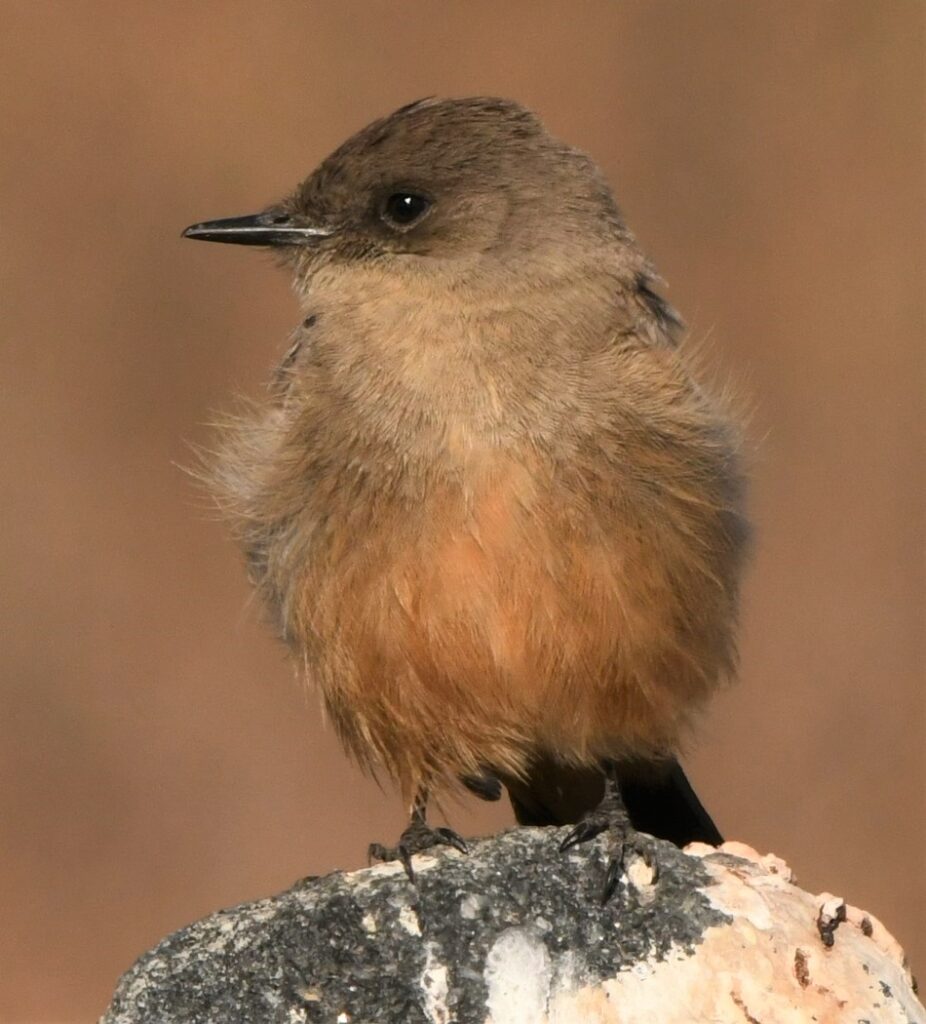
Cassin’s Kingbird 2 vocal exposed perches on brushy hillside, UCC, 2 vocal atop palms, in late afternoon atop a variety of ornamental trees, ES, 2 vocal in a tall sycamore, CPO, 2 vocal in eucalyptus and isolated shrub on open slope, GP (photo), 4 brushy field with scattered trees, DMP, 2 in eucalyptus near entrance, BBG;
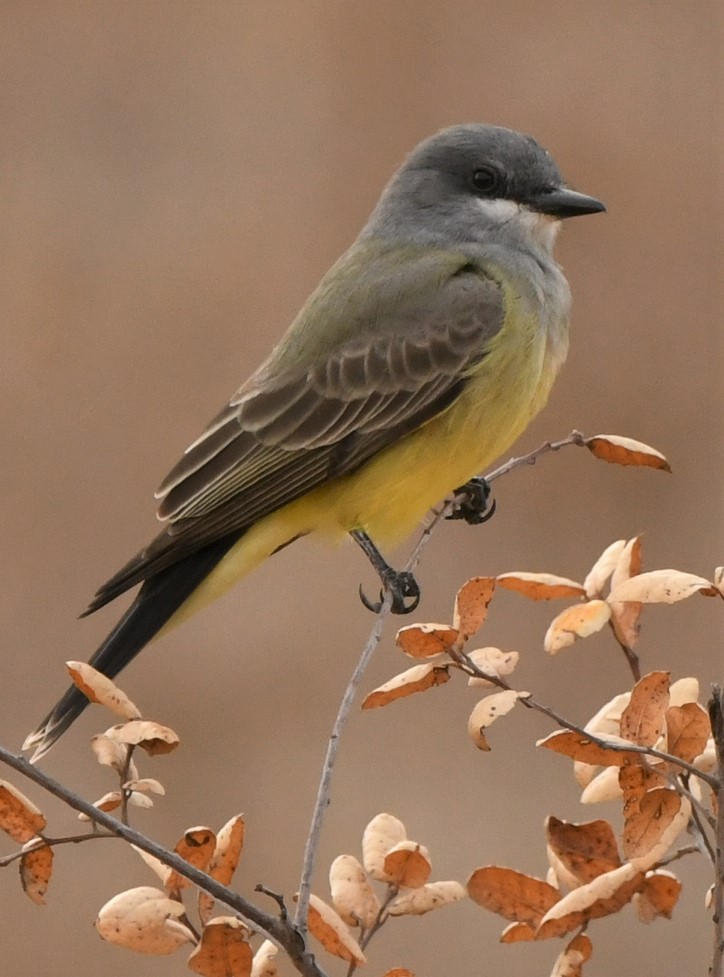
Hutton’s Vireo 1 in ornamental evergreen oak, CPO; California Scrub-Jay 2 vocal in eucalyptus at edge of park, UCC, 1 vocal, edge of picnic area, GP; American Crow 23 vocal, gregarious, MB, LCC, UCC, ES, 8 s, n SEL, 6 PC, 4, CI, 3 CPO, 8 BG, 16, GP; Northern Raven 1 flying over, FI, 2 chasing a RTHA, TRE; Horned Lark 60 gregarious in several loose flocks in dog park, FI; Tree Swallow 1 flying low over marsh and channel, TRE, 20 gregarious, flying back and forth over pond and adjacent area, DMP; Bushtit 5, vocal, gregarious in small oak, ES, 5 gregarious in sycamores along creek, UCC, 14, gregarious, foraging in chaparral and riparian edge in two flocks, s, n SEL , 12 gregarious in garden adjacent to s McCoy trailhead, TRE, 30 gregarious in 2-3 flocks of 8-12, foraging in riparian woodland, GP, 8 gregarious while foraging in shrubs next to rr tracks at golf clubhouse, SDR; House Wren 2 vocal and remaining mostly concealed in dense cover, LCC, 1 vocal (unseen) riparian woodland, n SEL, 3 vocal, active on ground at edge of lawn and base of large trees, CPO, 1 vocal in riparian woods, GC, 2 vocal in dense riparian cover and beneath salt cedar grove, BBG. 2 trailside shrubs, TRE. Bewick’s Wren 1, upstream east slope with Opuntia cacti, 4 on and near the ground in a variety of vegetation types, BG, 1 foraging at base of ornamental tree in parking lot, CPO, 1 at edge of roadside brush pile, BBG; Blue-gray Gnatcatcher 1 foraging in saltbush, s SEL (photo), 3 active near ground in coastal sage scrub trailside, PC, 2 active in trees and shrubs throughout, DMP, 6 BBG, 1 trailside shrubs, TRE; California Gnatcatcher 1 vocal (calls), active in low shrubs near a small pond, s SEL (photo);
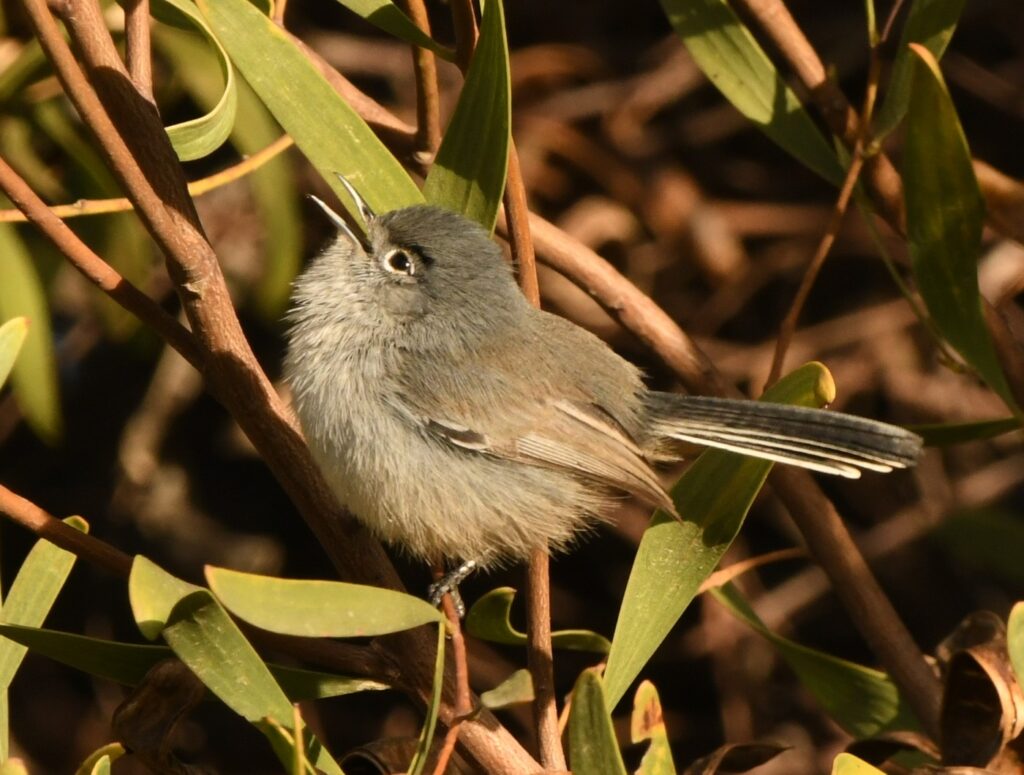
Ruby-crowned Kinglet 2 vocal UCC, 3 foraging in riparian woods, n SEL, 2 PC, 2 CPO, 15, GP, 3 foraging in lerp infested willow foliage edge of pond (photo);
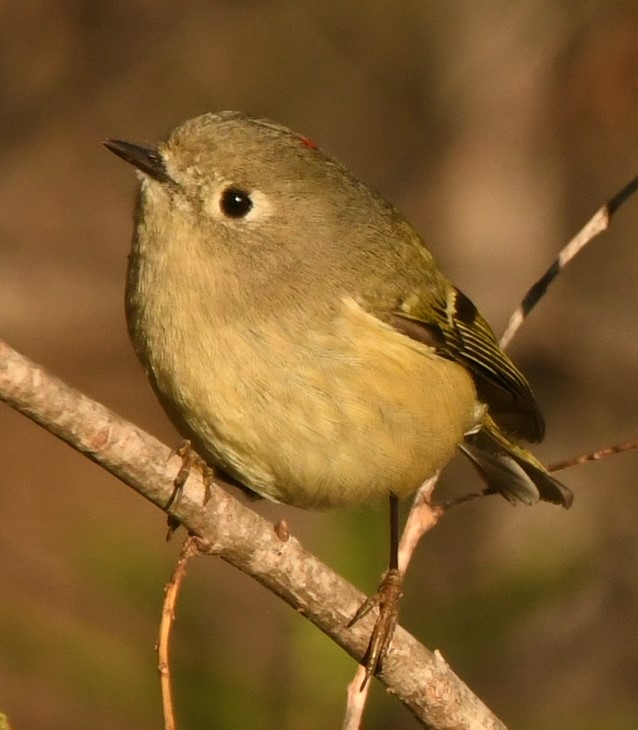
Wrentit 1 vocal (unseen) coastal sage hillside, CPO, 2 vocal (unseen) in coastal sage scrub bordering main pond, GP, 1 vocal (unseen) DMP; Western Bluebird 2 sallying to ground from fence and low limbs, CPO; Hermit Thrush 4 gregarious, foraging on ground and lawn at shady edge of riparian strip, UCC, 1 (dark gray form), at edge of shrub-riparian patch, LCC, 3 on ground in shady riparian areas, PC, 1 shady shrub cover, IB, 2 vocal (unseen) dense riparian woodland, GP, 8 vocal, on ground in shady areas, BBG; Northern Mockingbird 1 vocal (calls and song), LCC, 1 hillside coastal sage, s SEL, 1 residential yard and garden, LB, 1 hillside cactus garden, CPO, 3 in trailside trees, GP; California Thrasher 6 individuals and pairs active on ground in coastal sage and adjacent edge of park, CPO; European Starling 10 (exotic- naturalized) vocal, gregarious on utility wires, MB, LCC,ES, 3 edge of suburbs, s SEL, 5 in and around suburbs, PC; Cedar Waxwing 8 vocal, gregarious on ground, lawns and adjacent deciduous trees, CPO, 10 gregarious, flying over apartment complex on east side of pond, DMP; Pin-tailed Whydah 1 ? (exotic) extremely long tail – seen briefly in flight, low, eastward over I-5 at Leucadia Blvd., I returned twenty minutes later, searching the area on foot to confirm an ID and eliminate the possibility of a vagrant STFL, but without success (6 Dec. 2020); Scaly-breasted Munia 4 (exotic m,f) vocal (calls) gregarious in shrubs at edge of stream, UCC (photo);
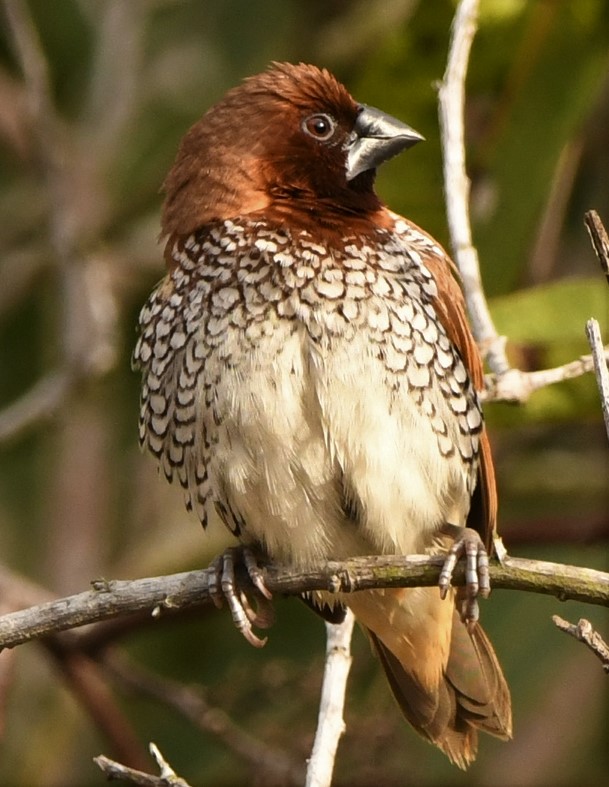
House Sparrow 30 (exotic – naturalized) (m,f) vocal, gregarious in gardens and restaurants with outdoor dining, ES, MB, 3 suburbs adjacent to PC, 2 LB, 10 (m,f) vocal, gregarious around harbor buildings and gardens, OH, 10 (m,f) gregarious, foraging on ground with WCSP, CPO; Oriental White-eye 2 (exotic) gregarious – a pair flew to willow briefly, LCC (5 Dec. 2020); Buff-bellied (American) Pipit 1 vocal in flight over beach, OH, 9 loosely gregarious while foraging on short, dry grass hillside at entrance GP, 1 vocal in overflight FI, 1 vocal (unseen) IB; House Finch 20 (m,f) vocal, gregarious, MB, LCC, UCC, AS, 22 (m,f) vocal, gregarious, ubiquitous, SEL, 6 (m,f) vocal, gregarious, suburbs and coastal sage scrub, PC, 2 TRE, 10 (m,f) vocal, gregarious, BG; 10 (m,f) gregarious – small flocks of 4 – 6 near the main lake, GP, 2 vocal in tamarisks, BBG, 2 in trees around golf club parking lot, SDR; Pine Siskin 4 vocal, gregarious in flight over hillside, UCC; Lesser Goldfinch 4 (m,f) gregarious in sycamores, UCC, 3 gregarious, vocal in willows, LCC, 5 (m,f) vocal, gregarious in alders and other trees along drainage, PCC; 10 (m,f) gregarious in trees and shrubs, FI, 3 gregarious in deciduous trees, CPO, 2 gregarious, BG, 2 +? calls (unseen) riparian woodland, GP, 3 (m,f) gregarious in trees around clubhouse, SDR; American Goldfinch 1 (f) with LEGO in a sycamore, UCC; Orange-crowned Warbler 10 foraging in garden succulents, low riparian vegetation, flowering eucalyptus and curtain fig, LCC, MB, ES, 1, with aberrant melanistic facial feathering staying in same area for several consecutive days, UCC (photo), 5 in shrubs and riparian woods, SEL, n SEL, 6, riparian trees and shrubs, UCC, 2 in eucalyptus, PC, 3 in garden trees and shrubs, LB, 4 gregarious and with YRWA and TOWA in a variety of exotic trees, BG, 1 in riparian strip at edge of pond, GP, 2 in riparian trees and ornamental shrubs, SDR, 1 in garden trees, CI;
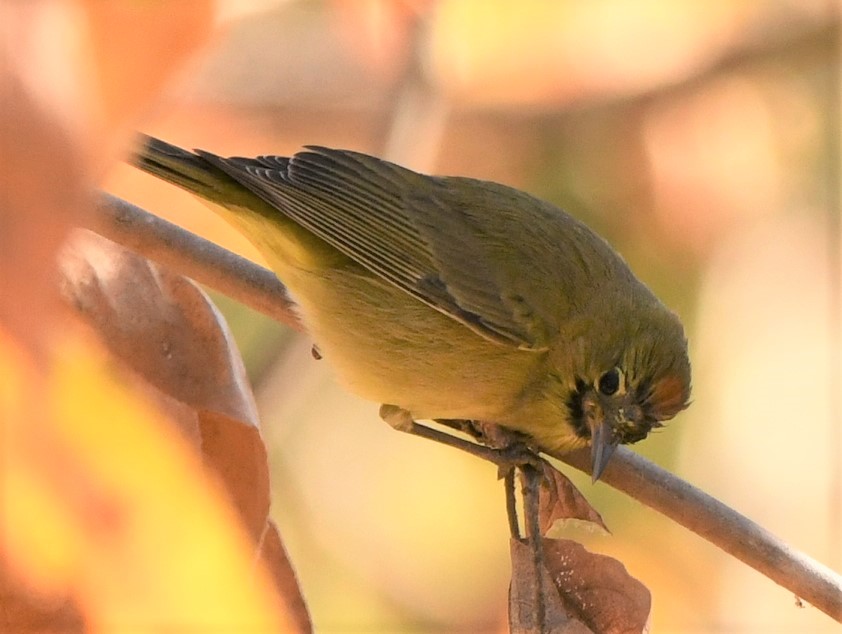
Common Yellowthroat 2 (m,f) often vocal (calls) in dense vegetation along stream, LCC, MB (photo), 4 (m,f) vocal, active inside and at edge of riparian woods, staying on or close to the ground, UCC, 10 (m,f) vocal, gregarious – pairs active in low vegetation near water, s, n SEL, 20 (m,f) vocal (calls) pairs and individuals foraging in riparian vegetation along creek and main lake, GP, 4 vocal (calls) individuals foraging low along margin of pond, DMP, 2 vocal in dense riparian undergrowth and garden shrubs, BBG;
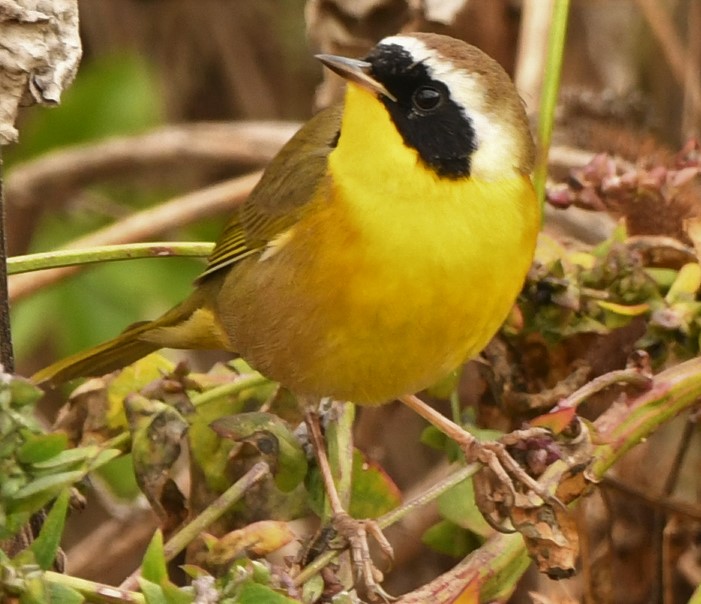
Yellow-rumped (Audubon’s) Warbler (m,f, imm) vocal (calls), gregarious, nearly ubiquitous in small flocks of 3 -8 birds, foraging from ground to tree-top level, snatch-gleaning, hover-gleaning and flycatching, often members of mixed species flocks, e.g. OCWA, TOWA, HOFI, WCSP; Black-throated Gray Warbler 2 (m,f) foraging in curtain fig with TOWA and YRWA, ES; Townsend’s Warbler 6 (m,f) foraging in curtain fig and flowering eucalyptus, ES, willows, LCC, 5 (m,f) gregarious in tall, exotic tropical trees over waterfall/stream section, BG; Spotted Towhee 2 (m,f) edge of coastal sage hillside and park garden, CPO, 2 coastal sage scrub adjacent to main lake, GP; California Towhee 2 vocal (calls), gregarious, on ground in riparian edge, LCC, 4 pairs on ground along upper trail, UCC, 6 coastal sage scrub, s, n SEL; 4 at edge of trail puddle in eucalyptus grove, ruderal edge of suburbs, PC, 3 coastal sage and saltmarsh ecotone, trailside, TRE/IB, 2 ruderal edge of dog park, FI, 6 cactus garden on hillside, edge of park, pairs foraging on ground, CPO, 10 pairs on ground at edge of main lake and in riparian woods edge, GP, 2 edge of clearing near entrance, DMP, 1 BBG, 1 on ground at ruderal edge of parking lot at golf course, SDR; Savannah Sparrow 14 in Salicornia marsh and edge of riparian woodland, no obvious macro or microhabitat separation with BESS s, n SEL, 12 gregarious, foraging in open, dry, ruderal grassland in dog park FI, 1 calls (unseen) DMP; Belding’s Savannah Sparrow 2-3 secretive, occasionally appearing at edge of tidal Salicornia marsh and foraging on seed heads of salt grass (Distichlis sp.), SEL (photo), 5 active in Salicornia marsh throughout, TRE/IB; Large-billed Savannah Sparrow 2 individuals at edge of marsh on a fence near observation deck, TRE/IB (photo);
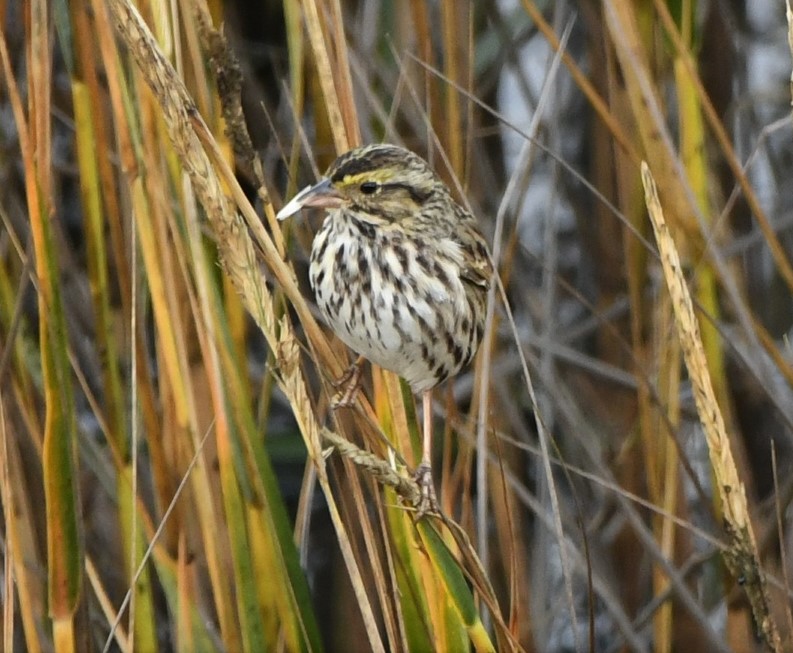
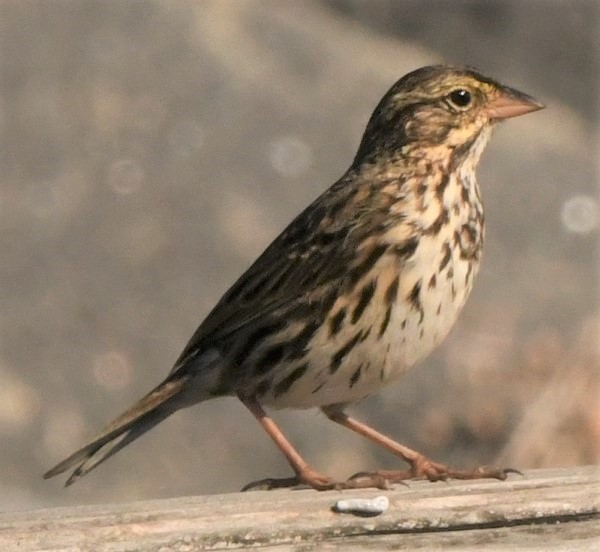
Song Sparrow 6 vocal (calls and song) in dense riparian woodland and edge, LCC, UCC, 16 in marsh, adjacent coastal sage scrub and riparian woodland, s, n SEL, 3 on ground in ruderal drainages, PC, 3 on ground in gardens, CPO, 16 vocal (calls and song) active on ground and low vegetation near water, GC, 12 active on ground, often foraging with WCSP near pond and dense riparian woodland, DMP, 4 active at edge of riparian thickets, BBG, 3 active at edge of riparian woodland and stream, SDR; Lincoln’s Sparrow 2 foraging on ground with SOSP on and adjacent to trail and tennis courts, LCC (photo), 2 with SOSP on ground at shady edge of streamside ruderal strip, UCC, 2 on ground beneath tall ornamental shrubs with WCSP, CPO;
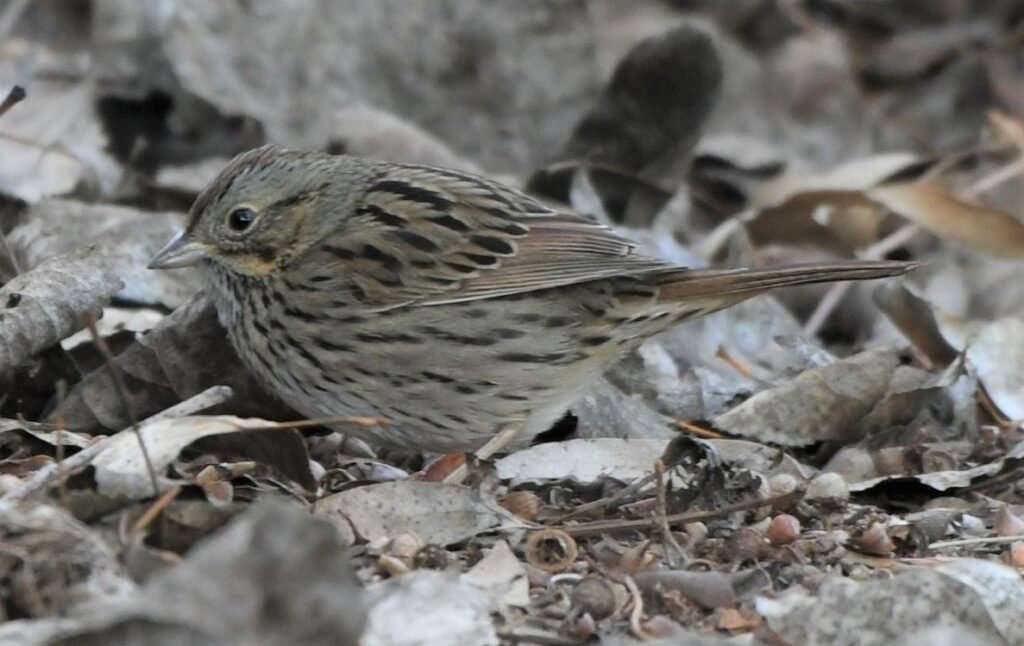
White-crowned Sparrow 2 foraging on ground with SOSP and LISP, LCC, 6 ( 5 ad., 1 imm) vocal (calls and song), gregarious on ground at edge of trai and riparian vegetation, UCC, 15 (90% ad.) vocal (calls and song), gregarious on ground, coastal sage, trailside and edge of riparian, s, n SEL, 12 (90% ad.) gregarious in suburban ruderal patches and coastal sage scrub, PC, 10 (90% ad.) gregarious vocal (calls) on ground trailside, coastal sage and edge of salt marsh, TRE, 20 (0% ad.) gregarious in ruderal patches near n entrance of dog park, FI, 4 gregarious on ground garden at edge of park, CPO, 10 (ad.) gregarious on ground near park entrance, GP; 8 gregarious foraging on trail with SOSP, DMP, 10 (90% ad) vocal (calls and song) gregarious in shrubs and on ground at edge of ruderal field and open ground elsewhere, BBG; Western Tanager 1 (f) in canopy of an exotic deciduous tree, BG; Red-winged Blackbird 16 (m,f) gregarious, vocal while in flight over lake and marsh, GP, 10 (mf) gregarious, flying over pond, DMP; Western Meadowlark 1 on ground at edge of marsh, n SEL, 2 gregarious on ground and flying over dog park, FI, 2, individuals on ground in grassland bordering adjacent airfield, TRE; Great-tailed Grackle 1 (f) flying over marsh and lake, GP; Hooded Oriole 1 repeated calls (unseen) in a mature grove of curtain figs, ES.